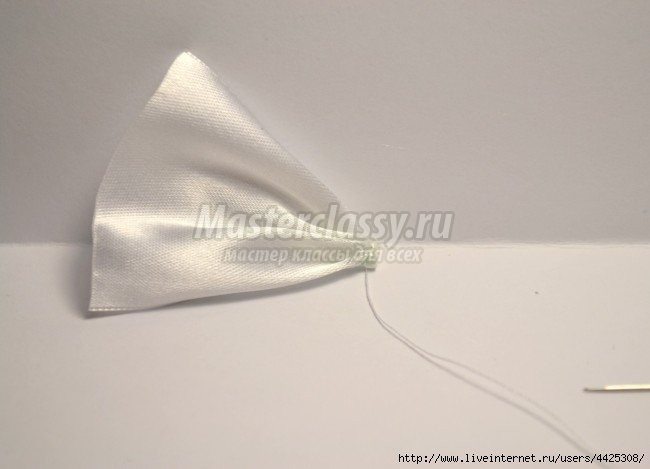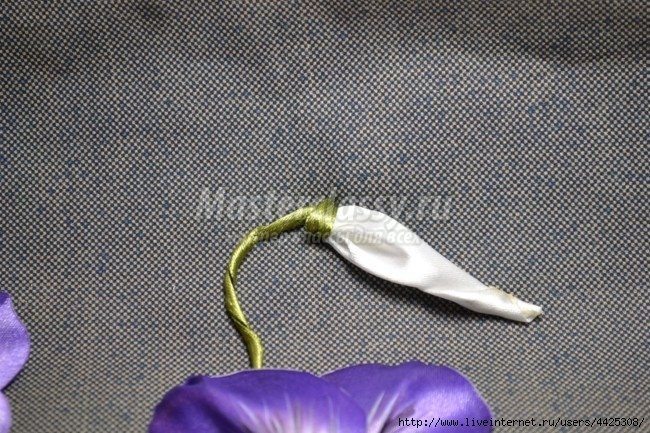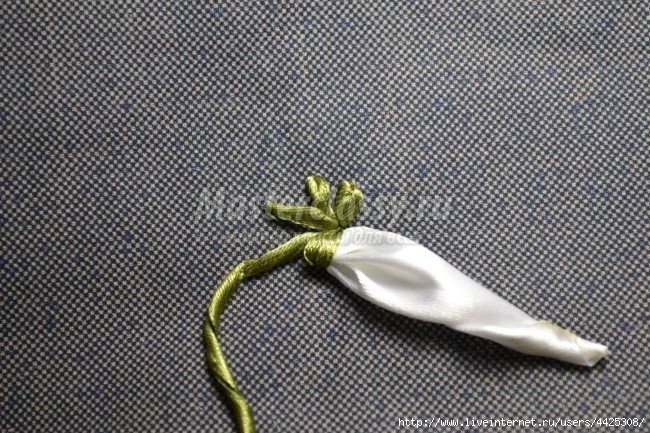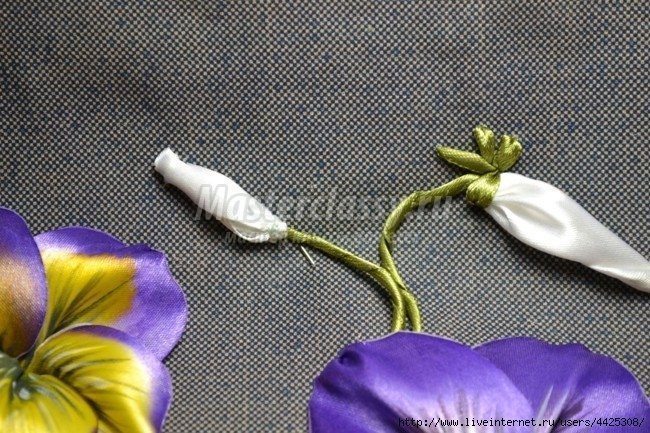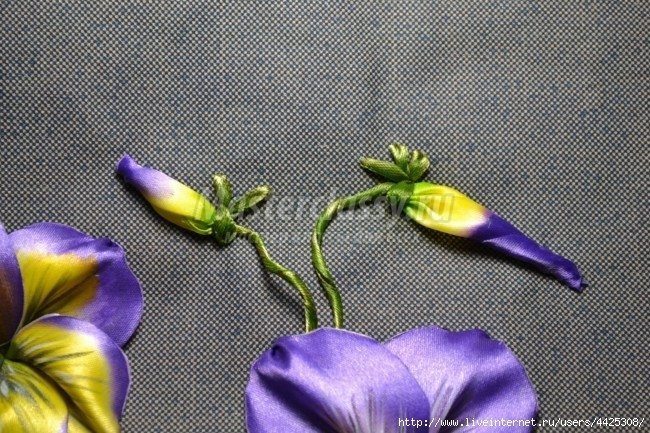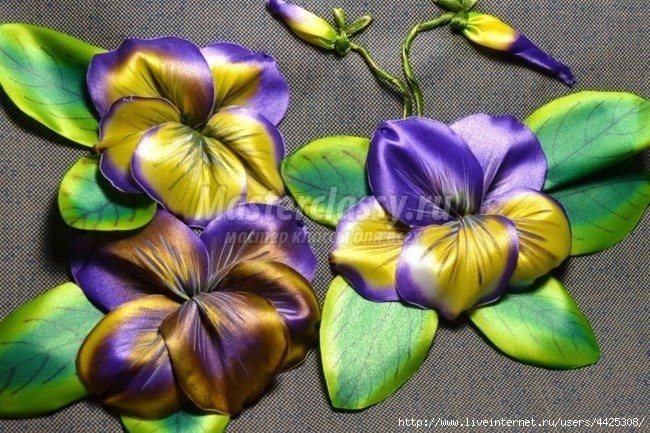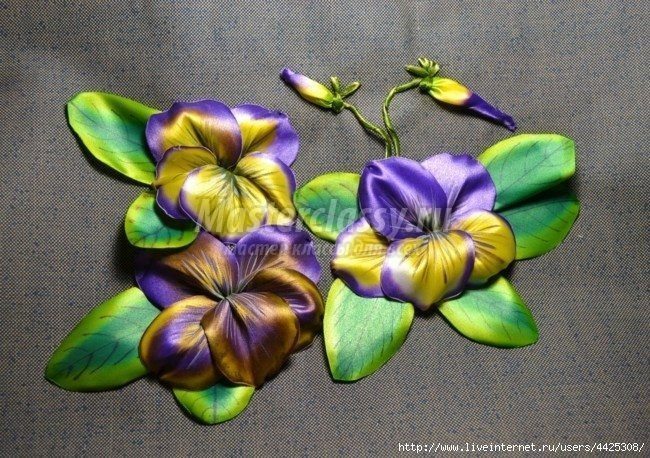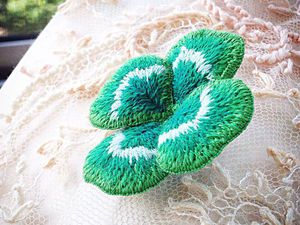
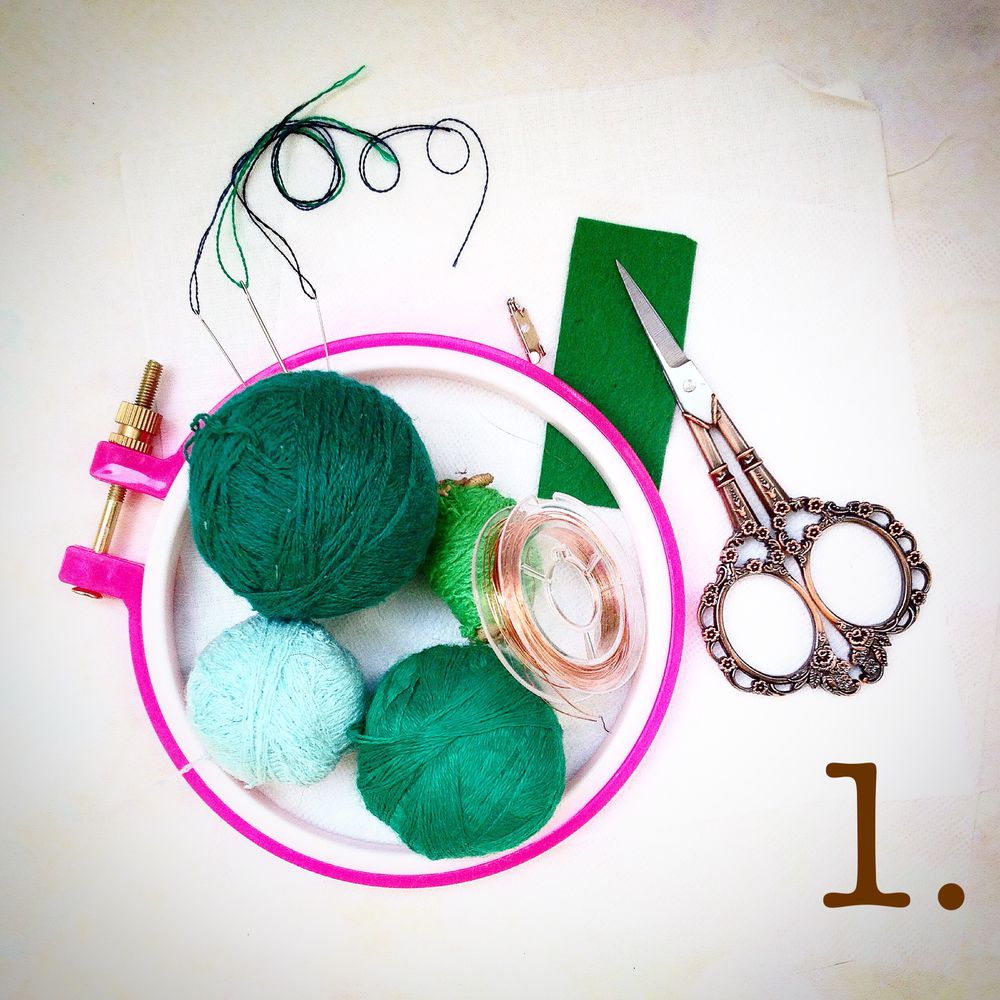
1. The need for the work:
Materials:
– A piece of the base fabric (cotton batiste white for me). You can use any plain weave fabric, thin, with a slight parting of the filaments. The thinner the warp and the weft, and less extendable, the smaller the holes and the whole embroidery is neater and more elegant;
– Thread (my grandmother acrylic 4 colors). If you are new to embroidery, it is better to take the line of the same quality and thickness;
– Copper wire 0,3mm. (. I have a green color, but you can take and conventional, uncoated, as it will be on the wrong side and closed her embroidery will not be seen);
– A piece of green felt thickness of 1 mm 2 area of 1-ruble coin;
– A piece of water-soluble non-woven fabrics of the same size as a piece of the base fabric to be able to fill in the hoop;
– Thread for basting usual (I coil plain white sewing thread);
– The basis for the brooches in the form of pins 15 mm. Or you can use any basis for brooches.
Adaptations:
– Hoop (I have a small 12 cm in diameter);
– Scissors for cutting thread;
– Scissors or clippers to trim the wire;
– Tracing;
– copy paper;
– Needle Embroidery (select based on the thickness of the yarn and fabric);
– Pen or pencil.
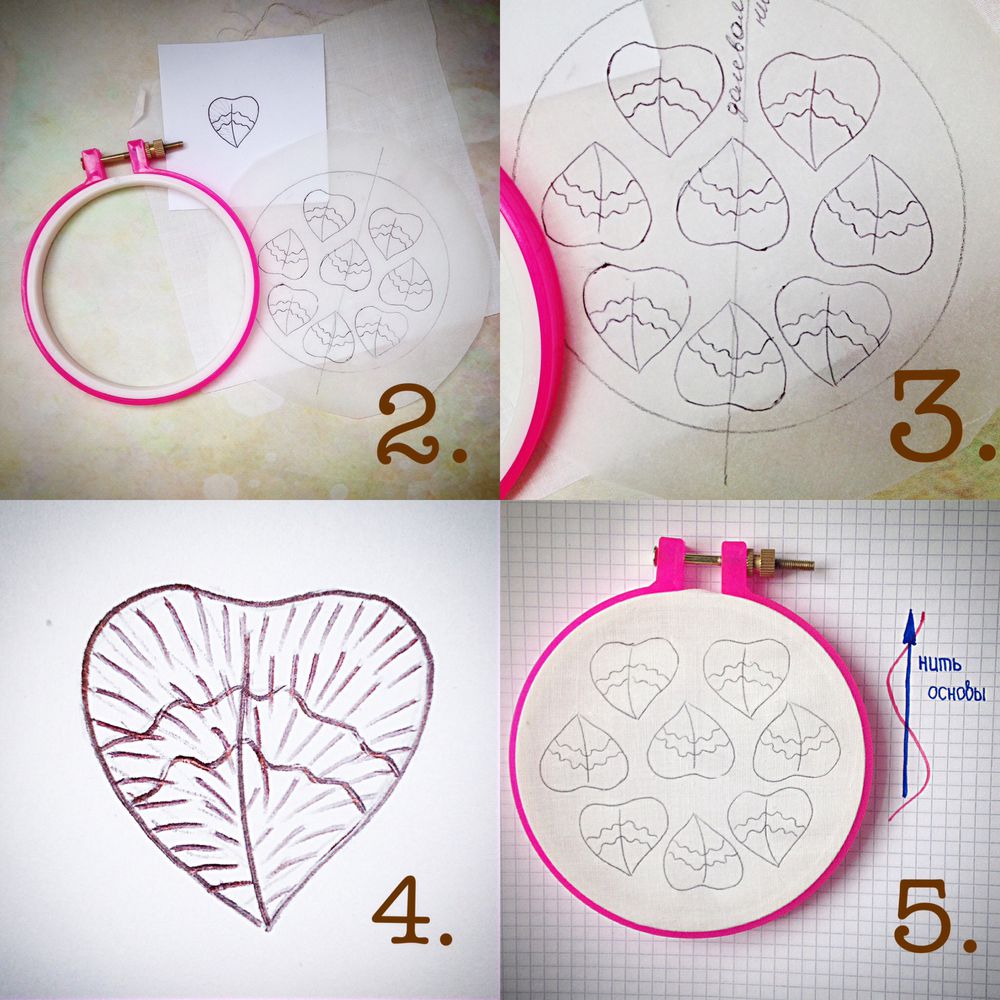
2, 3. Figure. There are no secrets there special. Draw leaves like anyone and anything. I draw on a standard sheet of paper. On tracing paper marks the boundary (obvozhu hoop), designate an equity thread and relative to translate all the leaves in one direction. If the leaves are arranged in a chaotic manner, they will not be the same. Figure embroidery process deforms differently. Clover although this is not critical, the plant must not be perfectly rovnenko.
4. Drawing a leaf. dashed line – this line of embroidery stitches. I imagine them on the fabric does not always draw. Who doubts in the forces – draw.
5. Switch the pattern on the fabric and dressed with fabric in the hoop. I translate using carbon paper. Folding the paper so that the image transferred to and from the front and the reverse side. The hoop dressed with fabric in such a way that there are no distortions of warp yarns of fabric (blue line in the figure is correct, the red is not.)
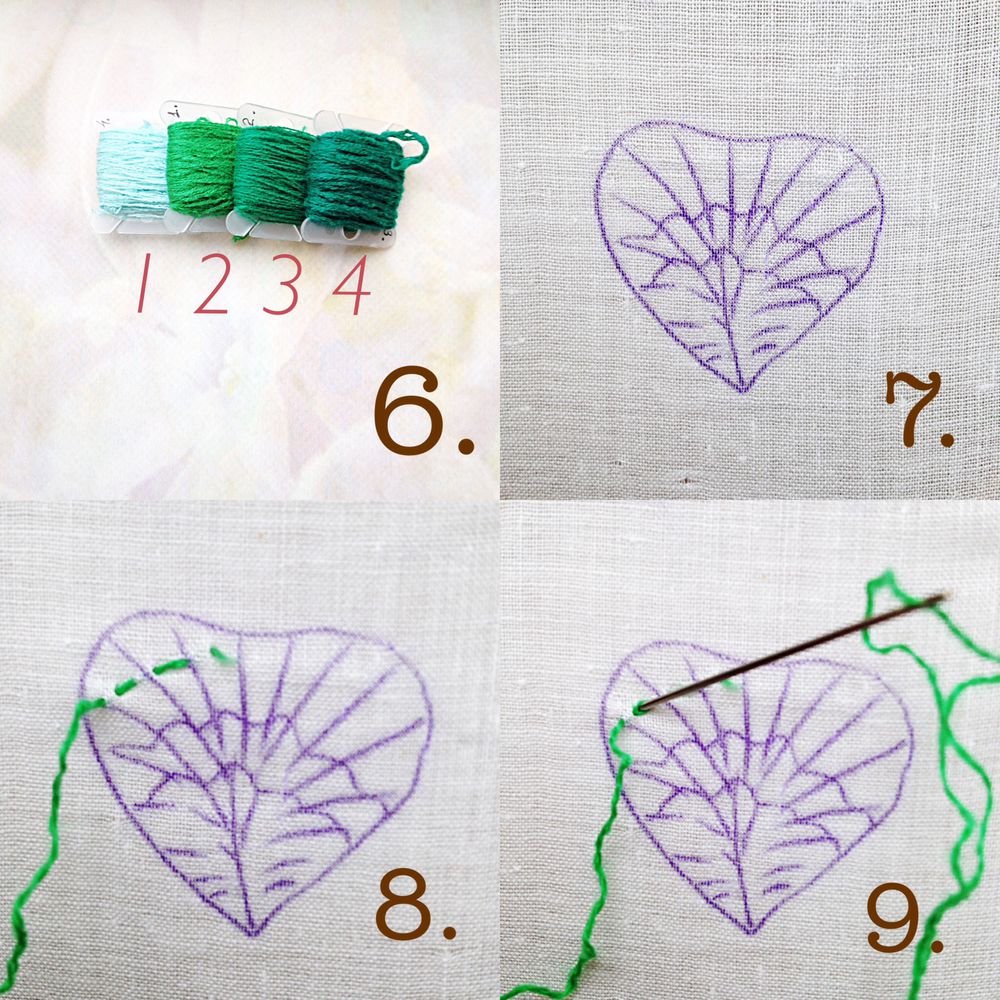
6, 7. Starting to embroider shade number 2.
8. Fix the end of the thread. A few small stitches across the floor of the future.
9. Perform one stitch back, sticking a needle in a thread, as if splitting it. All that now it will be fixed and will not go anywhere.
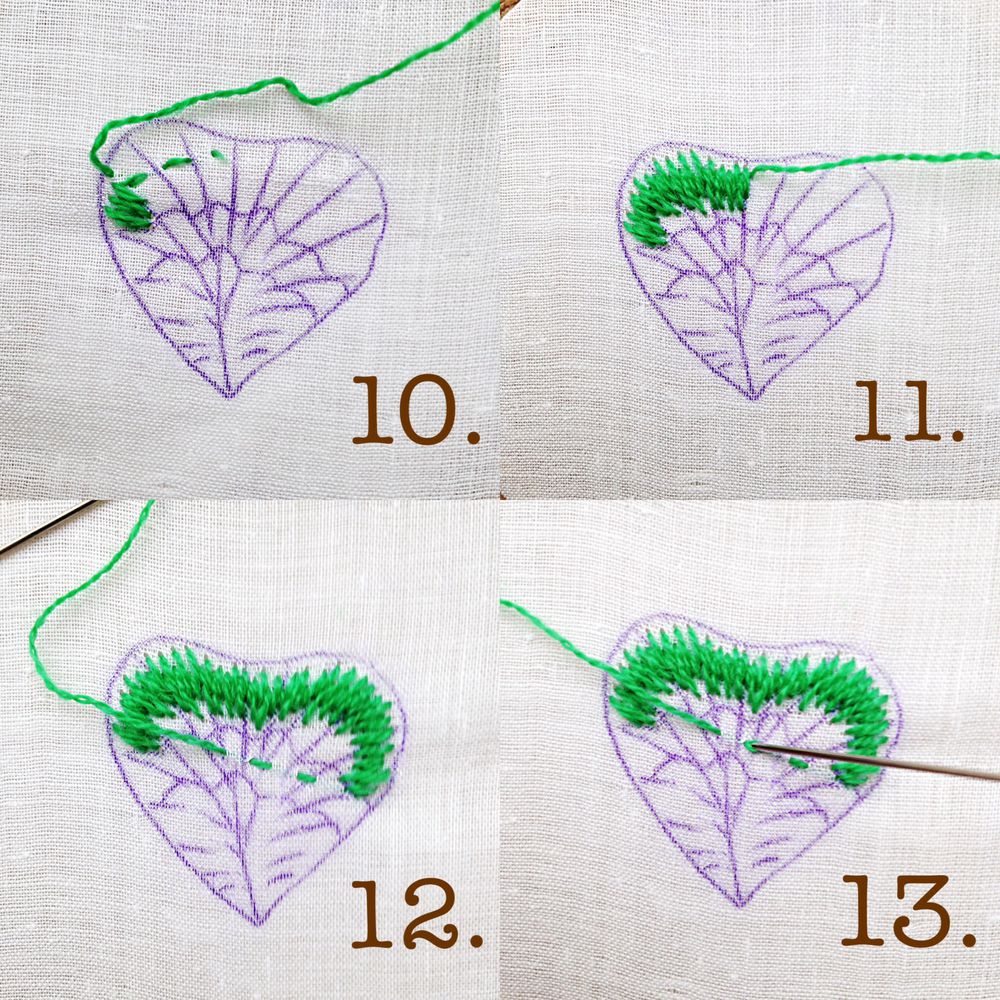
10. Getting flooring laid with stitches of different lengths at different levels. Stitch length not exceeding 7 mm. gaps between the stitches do not need to, they must lie close to each other, but do not “run down” on each other so that the flooring is not Bouguereau. In principle, the gaps can be filled by returning back, but then will turn to the wrong side and the wrong side of the diagonal broach get less accurate. Ideally, it is not necessary to go back at all, then the surface of a two-way turn. The photo shows that the first row of stitches I do not stack exactly to the edge, and departing from it. Full series of stitches will be done later, along with the wire. The distance from the first row to the contour line should not exceed 7 mm in all areas.
11. Continue to embroider the first row.
12 13. Fasten the thread along the same lines as in the beginning, but in reverse order.
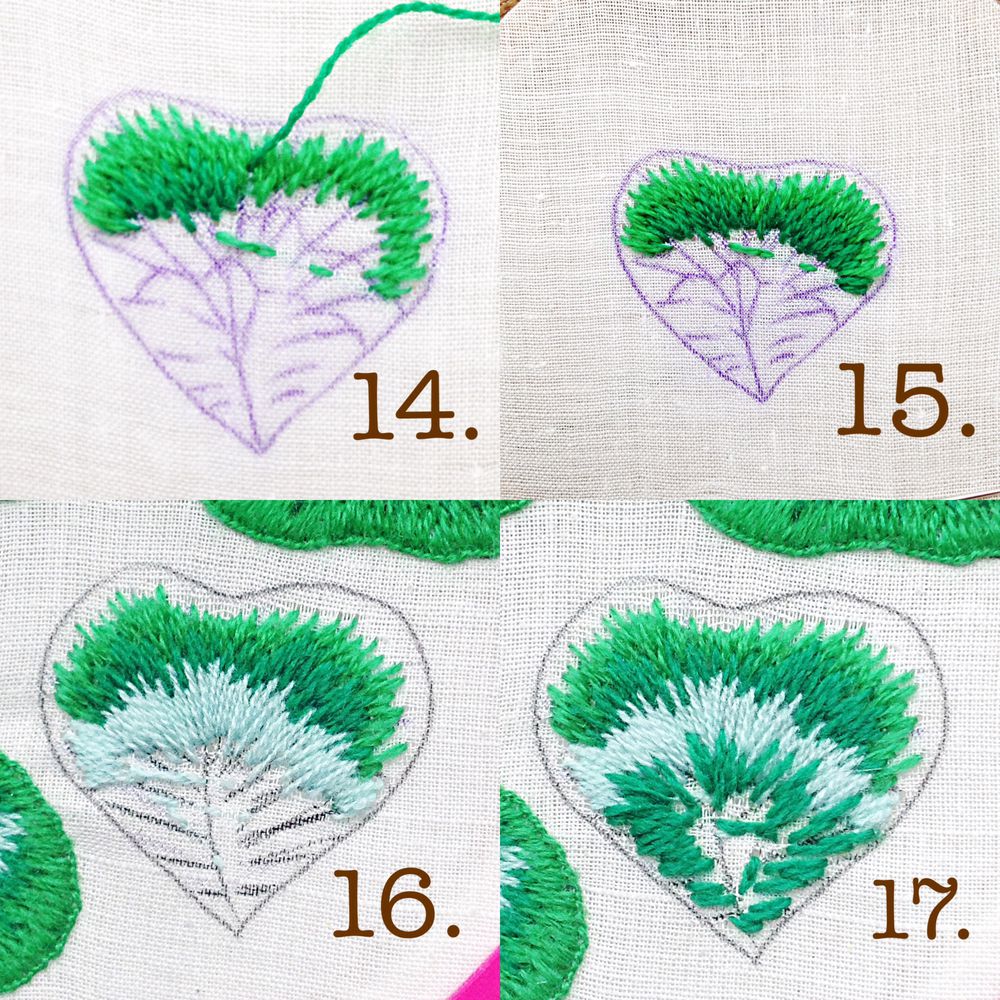
14. Take the thread color number 3 and begin to embroider the second row, second stitch – continuation of the first, that is, you need a needle stick is not the end of the hole, and from the first stitch, and, splitting thread, just going to the stitch. It is a guarantee that there will be holes in the finished embroidery, regardless of the quality of the fabric.
15. The same number of stitches of the second lengths. “Pour” one color to another.
16. The third row execute thread color number 1.
17. Again, take the shade of thread number 3.
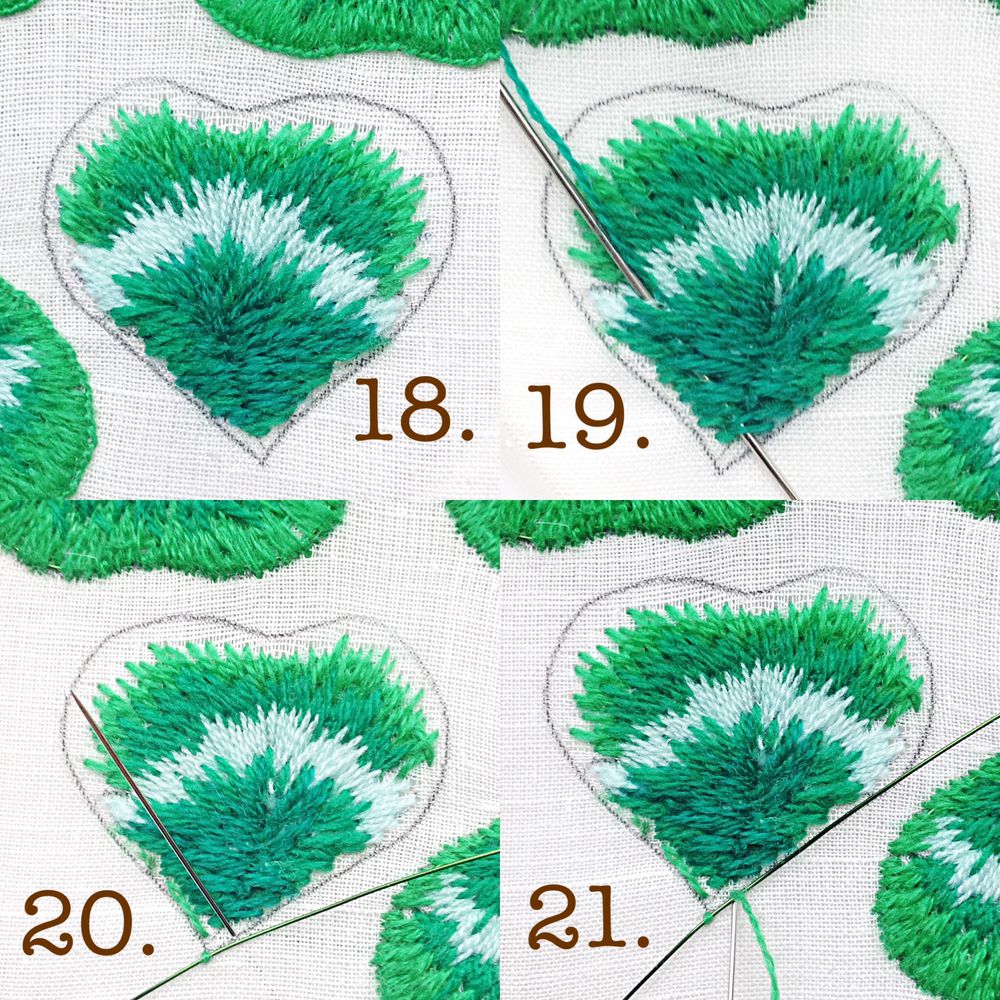
18. Shade number 4 finish embroider leaf.
Shades, their number and location are recommendatory in character. Do so, as required by your imagination, skill and vision of beauty 🙂
19.Pryachem ends of thread on the wrong side under the flooring.
20. Overturn embroidery on the wrong side (pull out of the hoop, and then dressed with a pre, but the wrong side up). Cut the piece of wire. The free ends are too long, you should not do – 2-3 cm is enough.
21. sew thread color number 2 couched stitch technique zero stitch. That is, a needle is stuck there, where pulled out, rounded the wire at the same time. The picture is clear, like. The distance between the stitches can be varied. the stronger the bending, the more stitches. But not more than 6 mm.
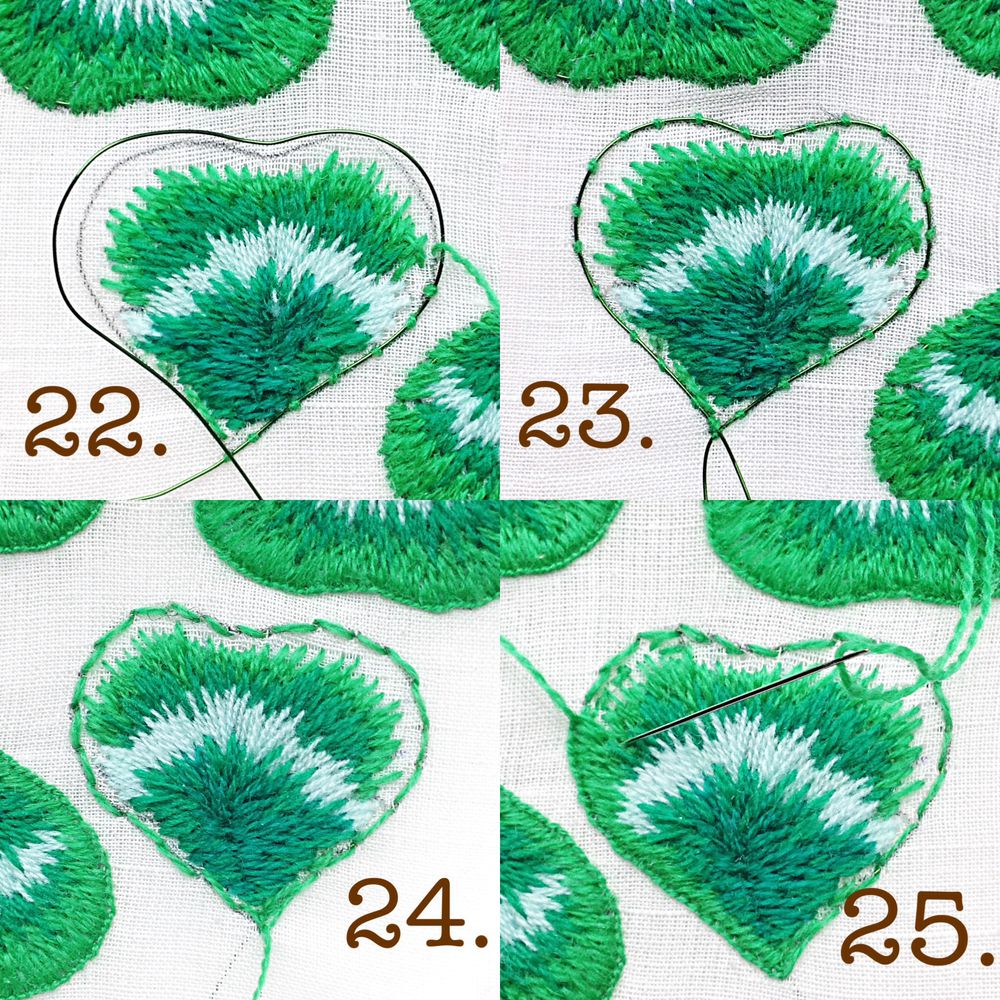
22. The wire should be laid on the contour line, which we have translated and inside out too. Remember? I sew the wire at this stage, when the main embroidery is ready to wire ends do not interfere.
How many saw all do it at the very beginning – to embroidery. Treat the first stitch the edges together with wire and then embroider the center. On the one hand it is clear – embroidery less deformed. But it is not convenient. The wire sticking out – a thread for it cling irritate 🙂 Take your pick.
23. The wire sewn. Threads I was not cut, but simply deduce the front of the embroidery – then come in handy.
24. Type of wire sewn embroidery on the front side.
25, 26. Again turn over embroidery. On the front side. And buttonhole stitches embroider edge of leaf color thread number 2. Technology is the same – to stick a needle in the previous stitch in thread, rather than next to it.
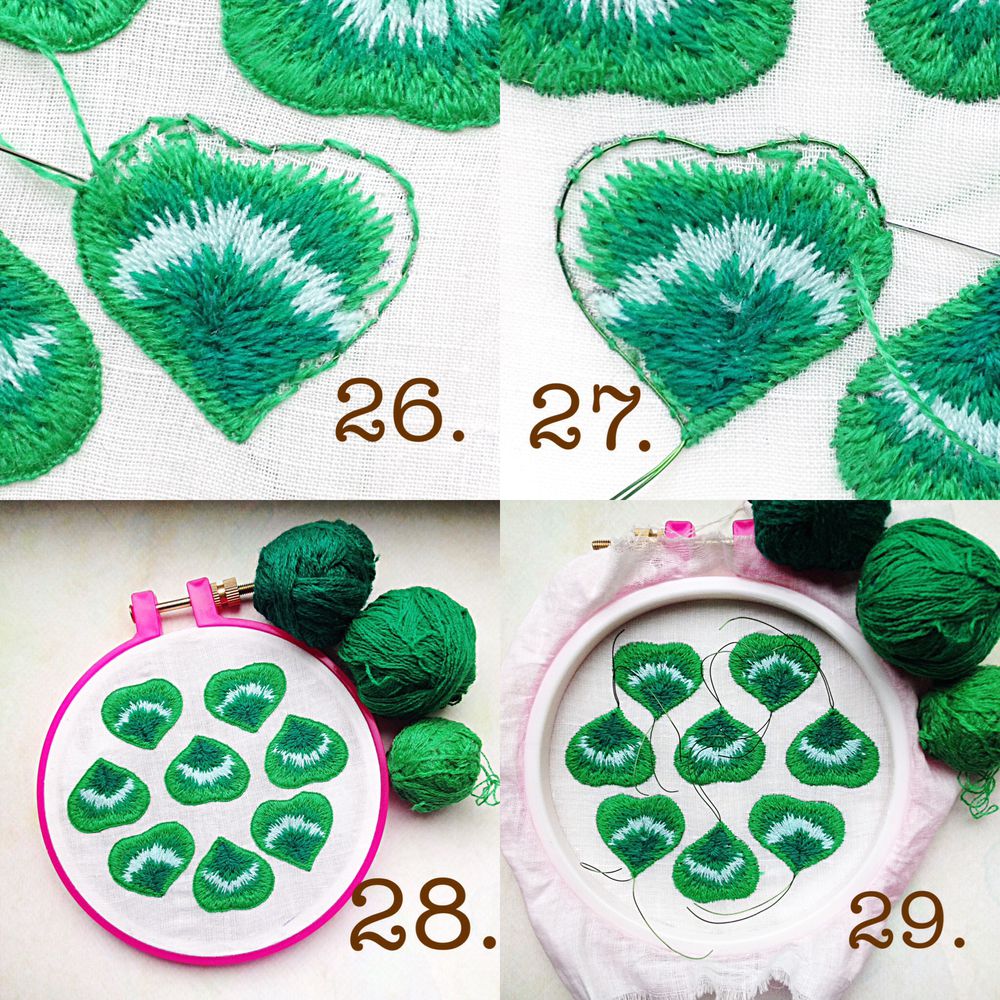
27. On the reverse side the needle comes very close to the wire on the outer edge. In order to get exactly, embroidery turn is not necessarily, the wire is well detectable. Or a needle leading to the center of the leaf on the fabric, and it rests on the wire, make a puncture. The stitches should be laid close to each other. If the gaps are formed, do not worry, later we will close them.
28. The front side of the embroidery with a loop suture treated leaves.
29. Wrong side stitch.
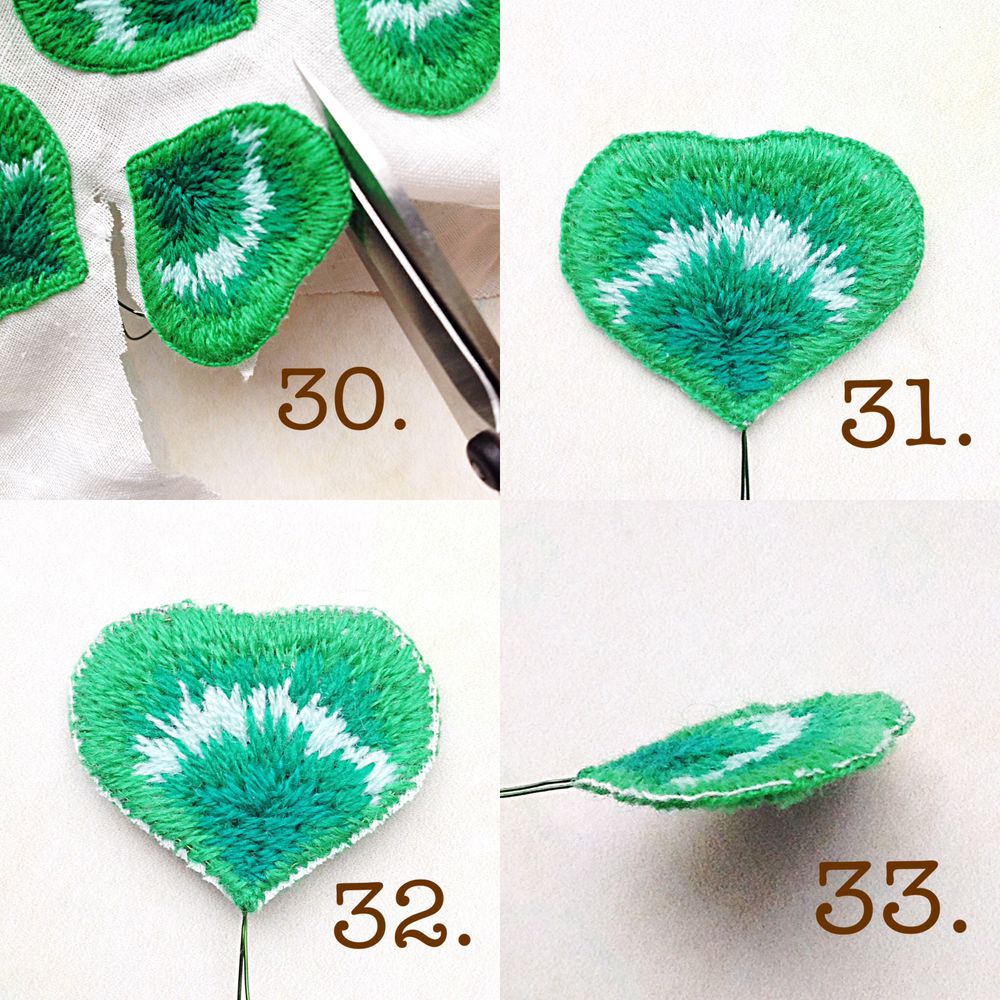
30. Take out the embroidery of the embroidery frame. Small sharp scissors cut out the leaves as close to the pigtail hinge joint. Cut holding embroidery facing up. If you’re on the wrong side of cut 100% damage the thread on the edge. Read Tips If slice the thread, then immediately fall onto nail varnish or glue in place “injury.” I is not never embroidery stabbed.
31. The cut sheet of paper from the front side. Remnants of the base fabric is almost not visible.
32. The cut sheet of paper from the wrong side. Here the base fabric is already very well visible and it looks sloppy.
33. The edge of a leaf. Visible white rim tissue osnovy.Vot stripes from this, we will get rid of using a water-soluble non-woven fabrics.

34. We put in a water-soluble nonwoven hoop. Wire tails skip through the fabric inside out so as not to interfere with work.
35. Regular sewing thread of any color, basting stitches slanting leaf on interlining, that in the course of work will not run away.
36. Baste leaf. View from the inside out.
37, 38. And now again looped stitches of different lengths, thread color number 2 runs along the edge. Fill the gaps, if sinned in the previous step. From the edge of the sheet is not retreat much, ideal to do the very edge of the sheet. If you are going away to recede, the region will be fuzzy, loose and wavy. This effect can also be used, for example, in colors. The end of the thread at the beginning and end of the hide under the floor.
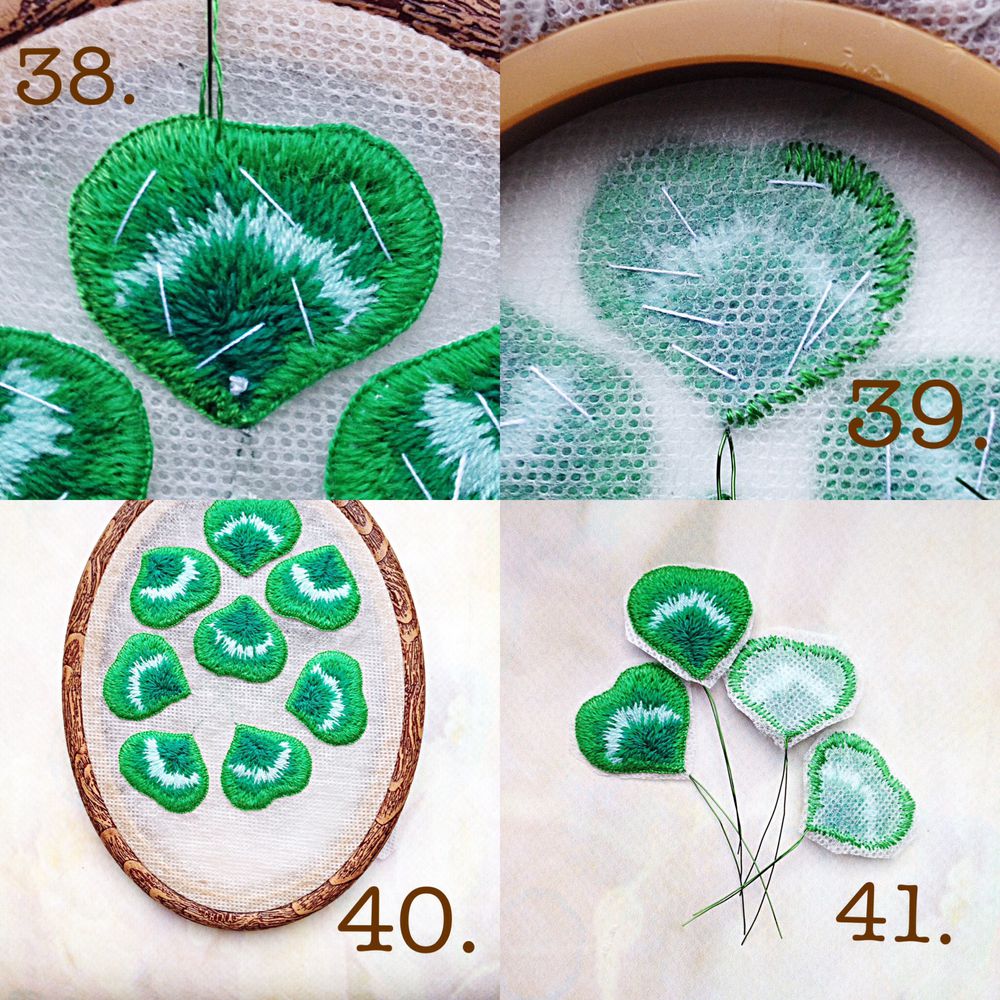
39. View from the wrong side.
40.Vynimaem basting thread leaves.
41.vynimaem of embroidery hoop. Cut leaves. You can not very gently, important not to damage the embroidery.
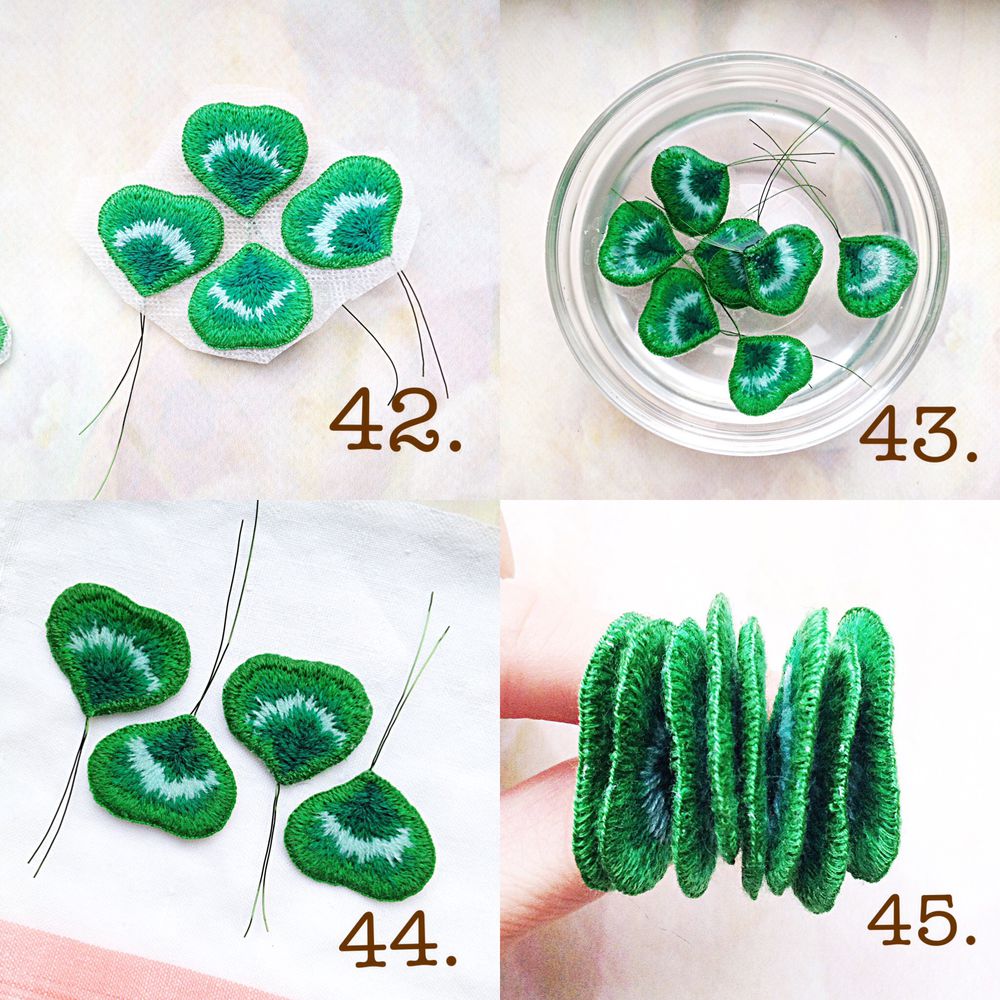
42. If it is absolutely unbearable, or laziness, they can be generally one does not cut, and entirely with the whole piece of nonwoven lowered into the water. All the same, it will dissolve, but I prefer to cut and then spend less time in the tap water.
43. Put the leaves in a bowl of water at room temperature. Fleece can be different, and dissolved over different time. See specifications. I is 2 minutes in a bowl. I then I wash the leaves under running water until complete washout nonwoven.
44. We spread the leaves on a towel or rag, blotted the excess moisture. Dry them. I dry, wrapped in a towel, directly on the battery.
45. The result of applying a water-soluble nonwoven’s such a beautiful, neat edge without a fringe and protruding threads, which is not exactly osypetsya. And interlining nakrahmalivaet little embroidery.
Can I do without it?
Mmozhno!
– If you do not particularly bother with accuracy;
– If the edges of negligence fits into the image, character and style of your product;
– It is possible to select as the base fabric is not white, and green, and then the warp is hardly seen from the end;
– Paint over the contour of the base fabric marker or paint the color of the thread edge. Then, too, the fabric will not be seen;
– Walk along the edge of a loop seam without interlining, just holding leaf in hand. In this case, the edge will be more loose and not very smooth, but as an option is well suited.
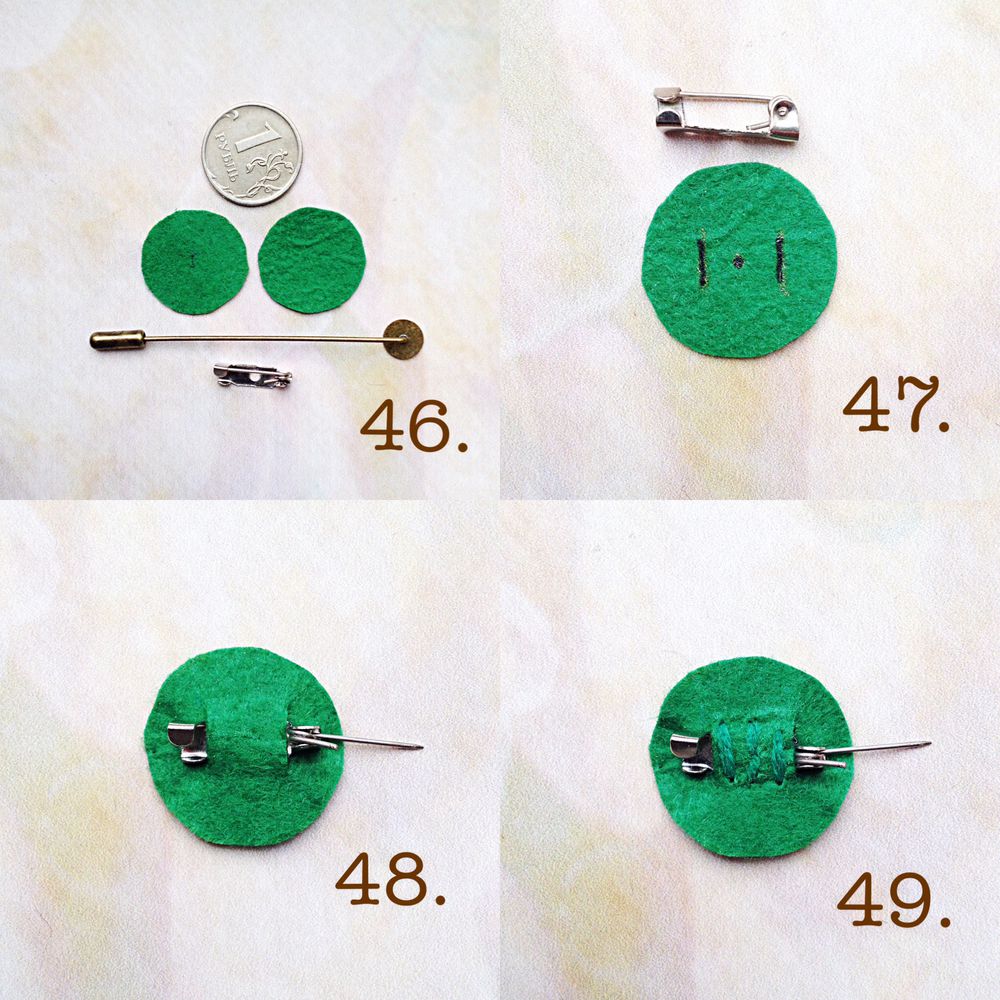
46. Cut the green felt two thin slices the size of a 1-ruble coin. It may be any fastener in the form of pins, needles, and other.
47. Mark up on one circle to the cutting line on the size of a pin. cut length of 5 mm. In general, depending on pin size. Cut.
48. Insert the pin in the hole.
49. Firmly sew thread in tone.
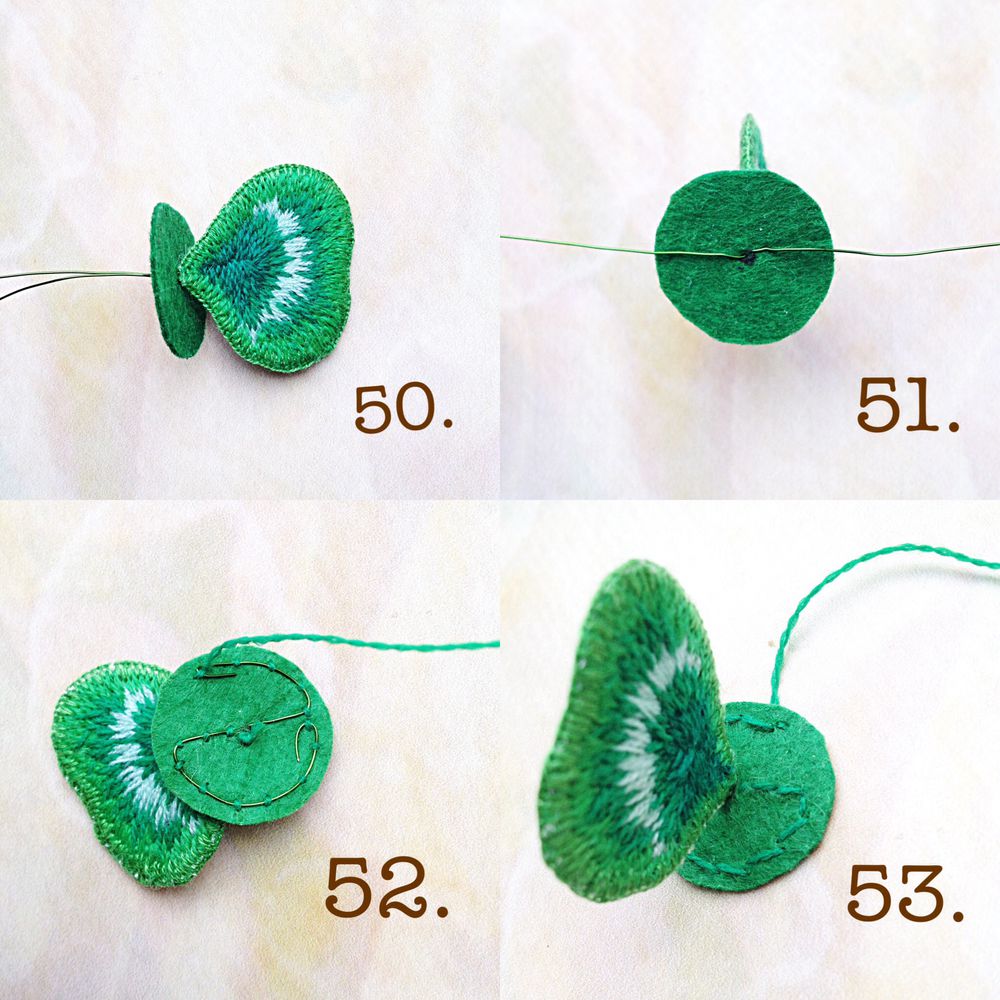
50. Take the second felt circle. Pierces the middle of the hole and insert the wire ends from the first leaf to stop.
51. unbent wire antennae.
52.nitkami color of felt sewn wire. Required Fold the tip of the wire loop.
53. The view from the front side of the felt circle.
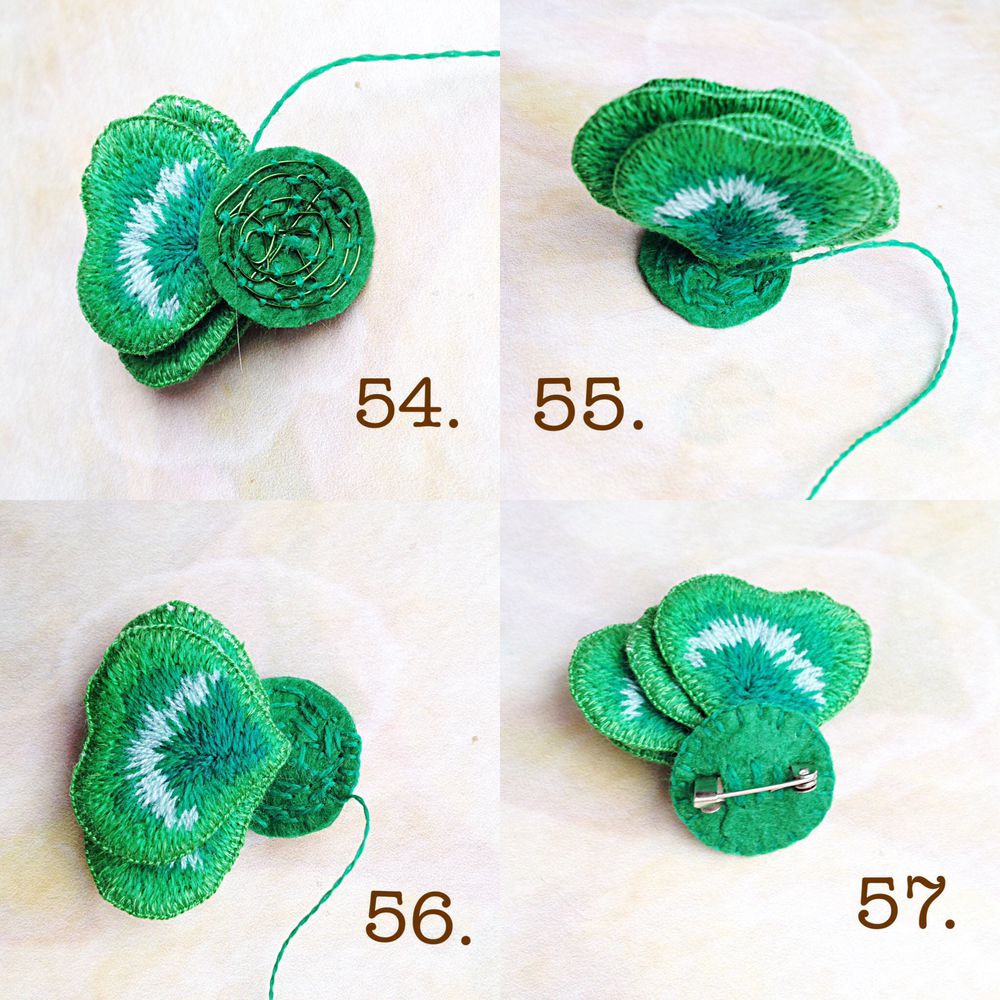
54. secure all the leaves and all the ends of the wire.
55. The view from the front side. You can leave and so, and you can embroider the felt circle further. For example, the French knots.
56. Take the second circle with a buckle. You can drop into the center of the adhesive. I use the glue gun. And you can not stick at all. A loop seam is sewn over the edge of one circle to another.
57. The underside of the brooch with buckle.
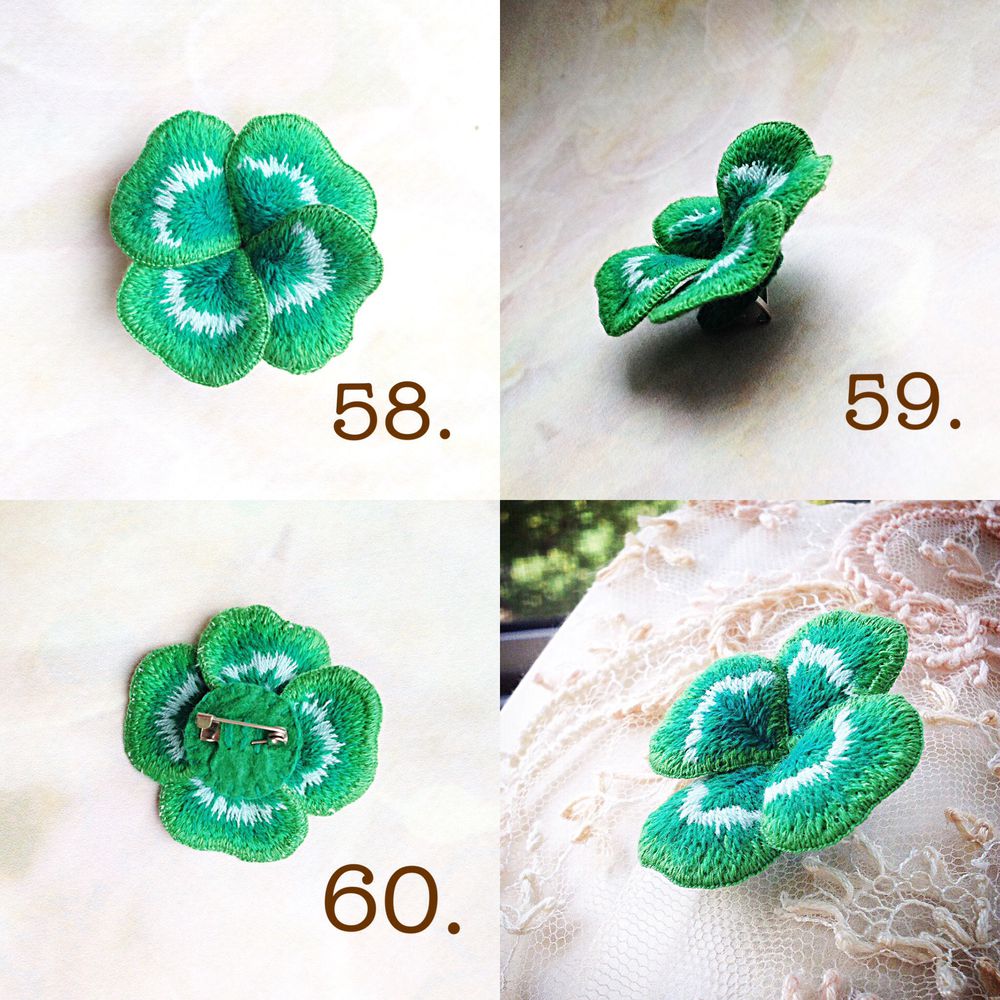
58 59.Raspravlyaem folds and leaves to your liking.
60. Wrong side brooches.
Done! Be creative, try.
Thank you for attention.
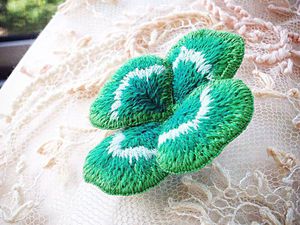
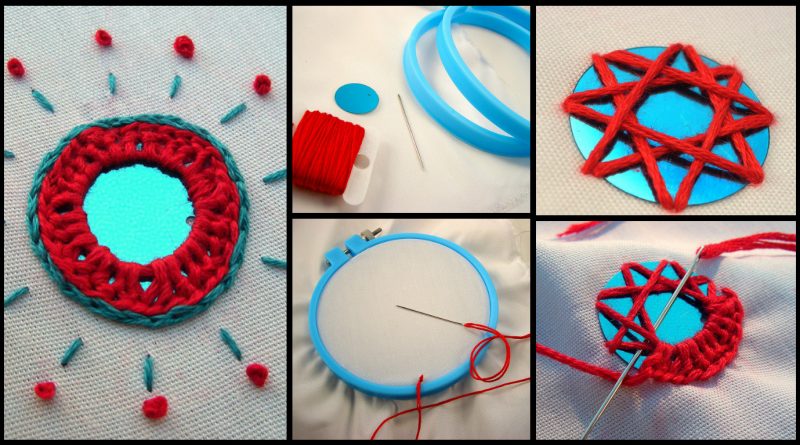
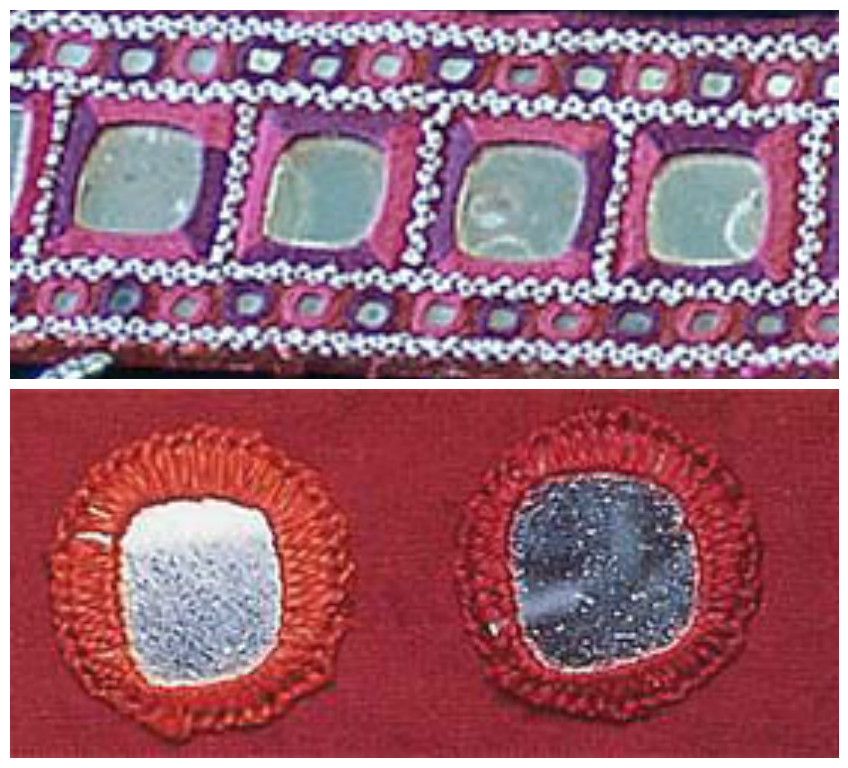
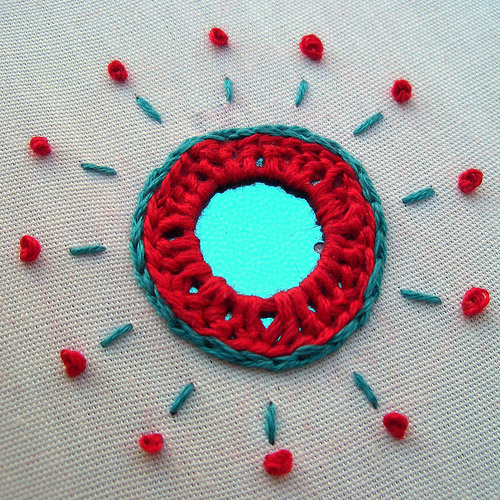 Prepare all materials. For embroidery you will need: cotton, silk or wool fabric with a tight weave structure of the fabric yarns, hoop, needle sharp, mirror-shisha (or sequins, or coins) and thread for embroidery (silk, cotton, metallic thread).
Prepare all materials. For embroidery you will need: cotton, silk or wool fabric with a tight weave structure of the fabric yarns, hoop, needle sharp, mirror-shisha (or sequins, or coins) and thread for embroidery (silk, cotton, metallic thread).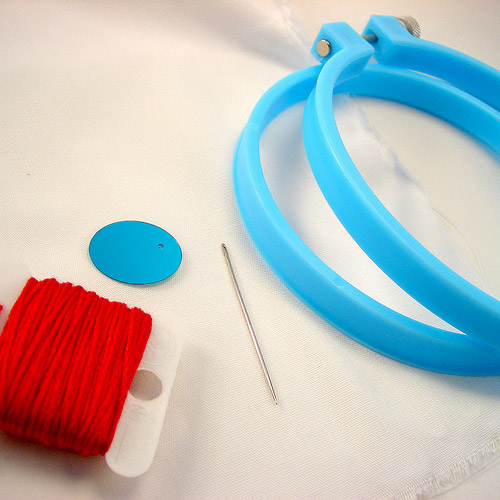 Tightly secure the fabric in the hoop. Insert the thread a needle and tie a knot at the end of the thread.
Tightly secure the fabric in the hoop. Insert the thread a needle and tie a knot at the end of the thread.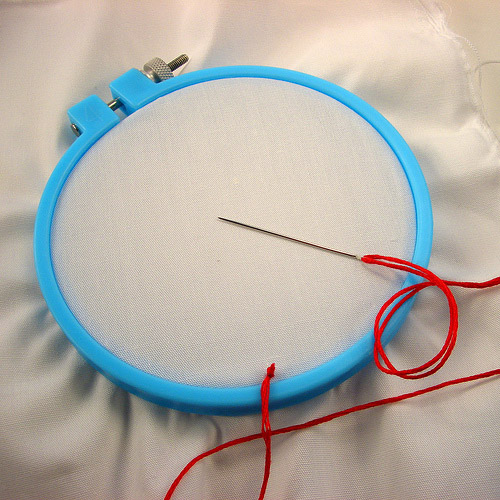 Place shisha on the fabric and sew basic cross stitches. The basic stitches are not necessary to be very careful. But they must be tight, and arrange them should not be too close to the edge of sequins – or shisha simply fall out.
Place shisha on the fabric and sew basic cross stitches. The basic stitches are not necessary to be very careful. But they must be tight, and arrange them should not be too close to the edge of sequins – or shisha simply fall out.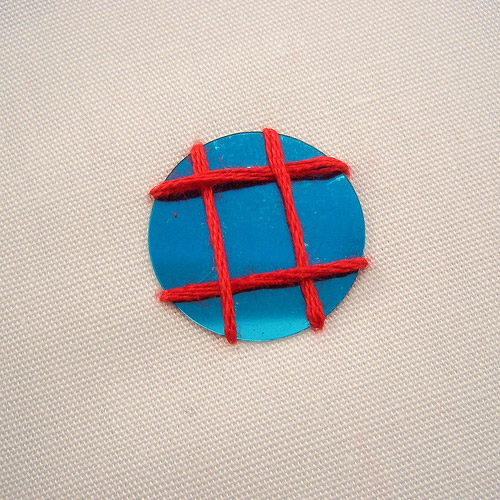 Now repeat the basic stitches, but by turning them by 45 degrees, as in the photo.
Now repeat the basic stitches, but by turning them by 45 degrees, as in the photo.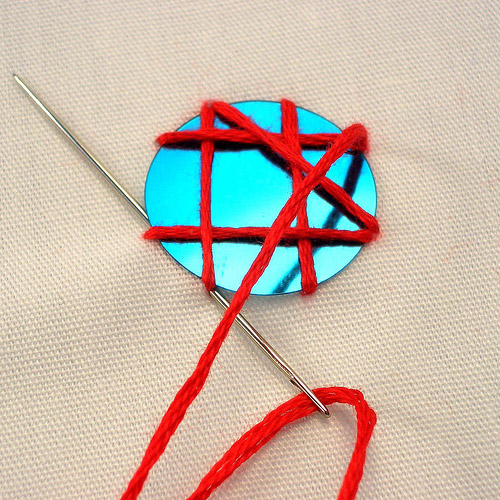 You should have this:
You should have this: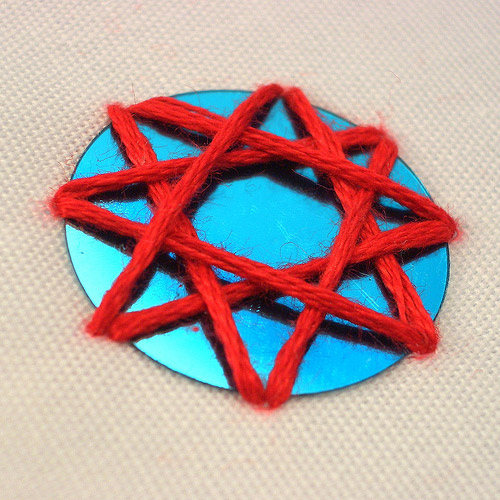 Now you can leave everything as it is, and sew the next shisha. This is already well fixed and looks nice. But if you want to create a tight box around the shisha – continue. Pierce the fabric with a needle near a mirror from the inside face. Then, insert the needle under the basic stitches from the center to the edge.
Now you can leave everything as it is, and sew the next shisha. This is already well fixed and looks nice. But if you want to create a tight box around the shisha – continue. Pierce the fabric with a needle near a mirror from the inside face. Then, insert the needle under the basic stitches from the center to the edge.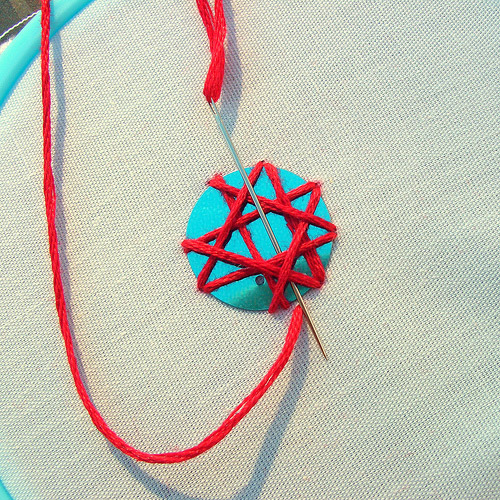 Pull the thread and tighten the stitch, then make one stitch in the fabric next to the mirror.
Pull the thread and tighten the stitch, then make one stitch in the fabric next to the mirror.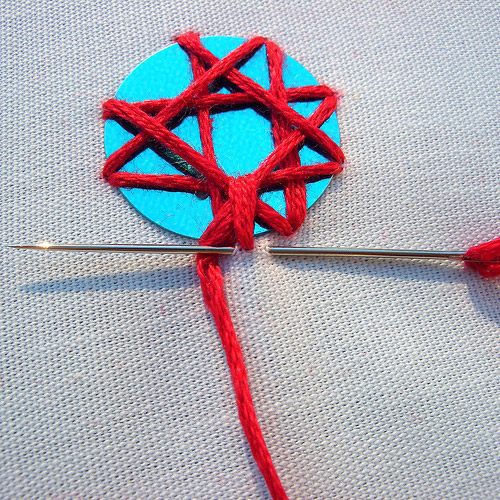 Now, following the stitches should be the same as odeyalnye stitches. Again, thread the needle under the basic stitches from the center to the edge, but make sure that the thread forms a loop under the needle when tightening the stitch.
Now, following the stitches should be the same as odeyalnye stitches. Again, thread the needle under the basic stitches from the center to the edge, but make sure that the thread forms a loop under the needle when tightening the stitch.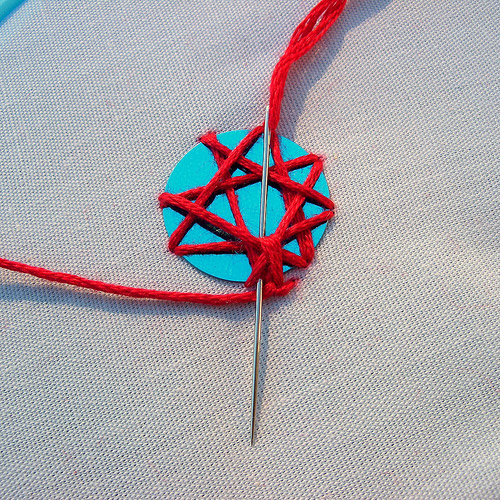 From now on, when you make a stitch on the cloth after odeyalnogo stitch, you make sure that puncture the needle through the previous stitch in the fabric. So you make a nice chain around your shisha.
From now on, when you make a stitch on the cloth after odeyalnogo stitch, you make sure that puncture the needle through the previous stitch in the fabric. So you make a nice chain around your shisha.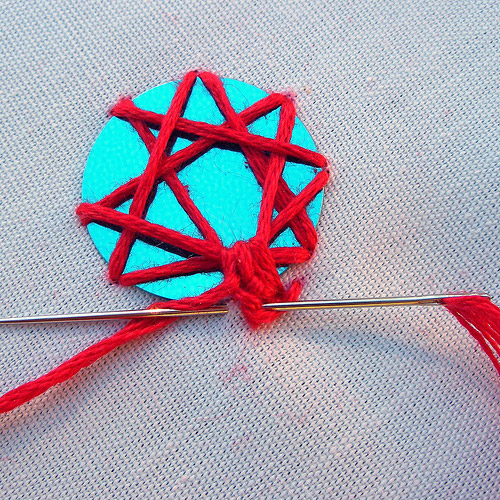 At this point, you can take out of the embroidery hoop, but not necessarily. Continue with steps 7 and 8 around the mirrors.
At this point, you can take out of the embroidery hoop, but not necessarily. Continue with steps 7 and 8 around the mirrors.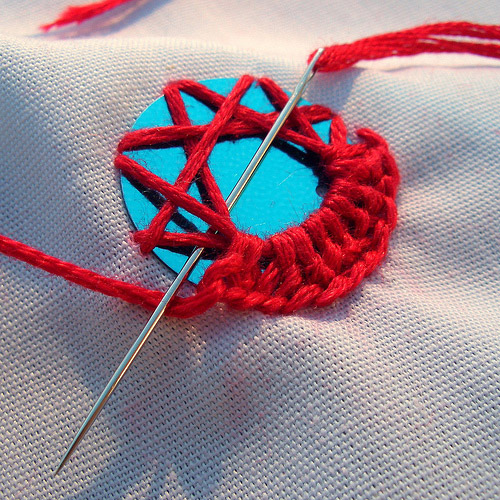 If removed from the embroidery hoop, will be able to slightly bend the substrate and better control of the stitches on the fabric.
If removed from the embroidery hoop, will be able to slightly bend the substrate and better control of the stitches on the fabric.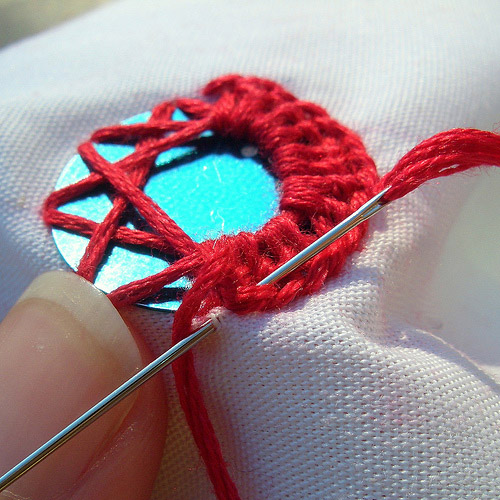 Continue until you reach the end!
Continue until you reach the end!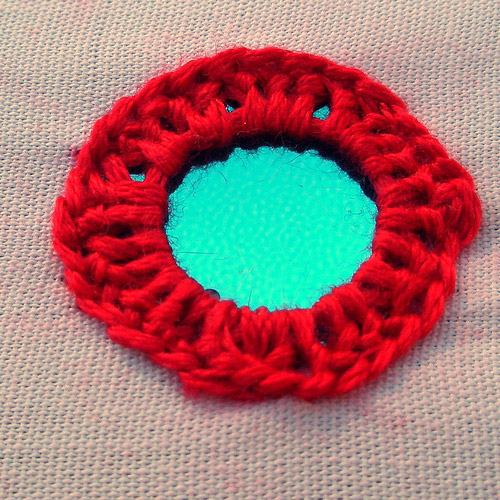 You can stop at this point, or do embroidery even more interesting. Follow the edging of turquoise chain stitch in tone sequins.
You can stop at this point, or do embroidery even more interesting. Follow the edging of turquoise chain stitch in tone sequins.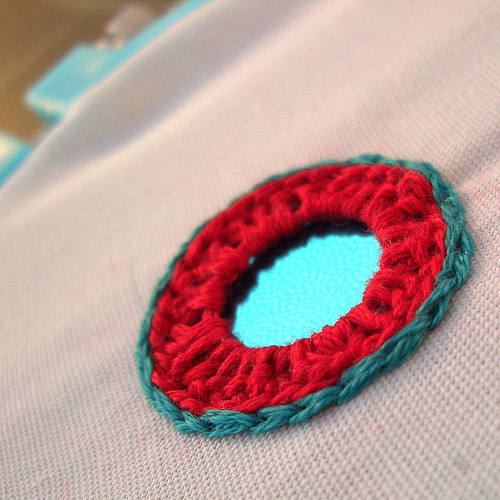 Then follow the stitches-rays of your shisha and shine like the sun!
Then follow the stitches-rays of your shisha and shine like the sun! Shut down the lovely French knots.
Shut down the lovely French knots.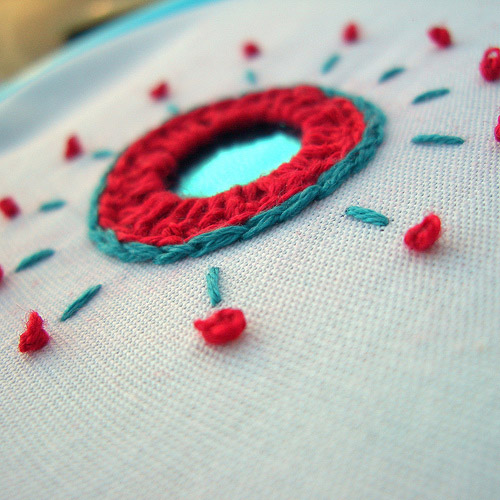
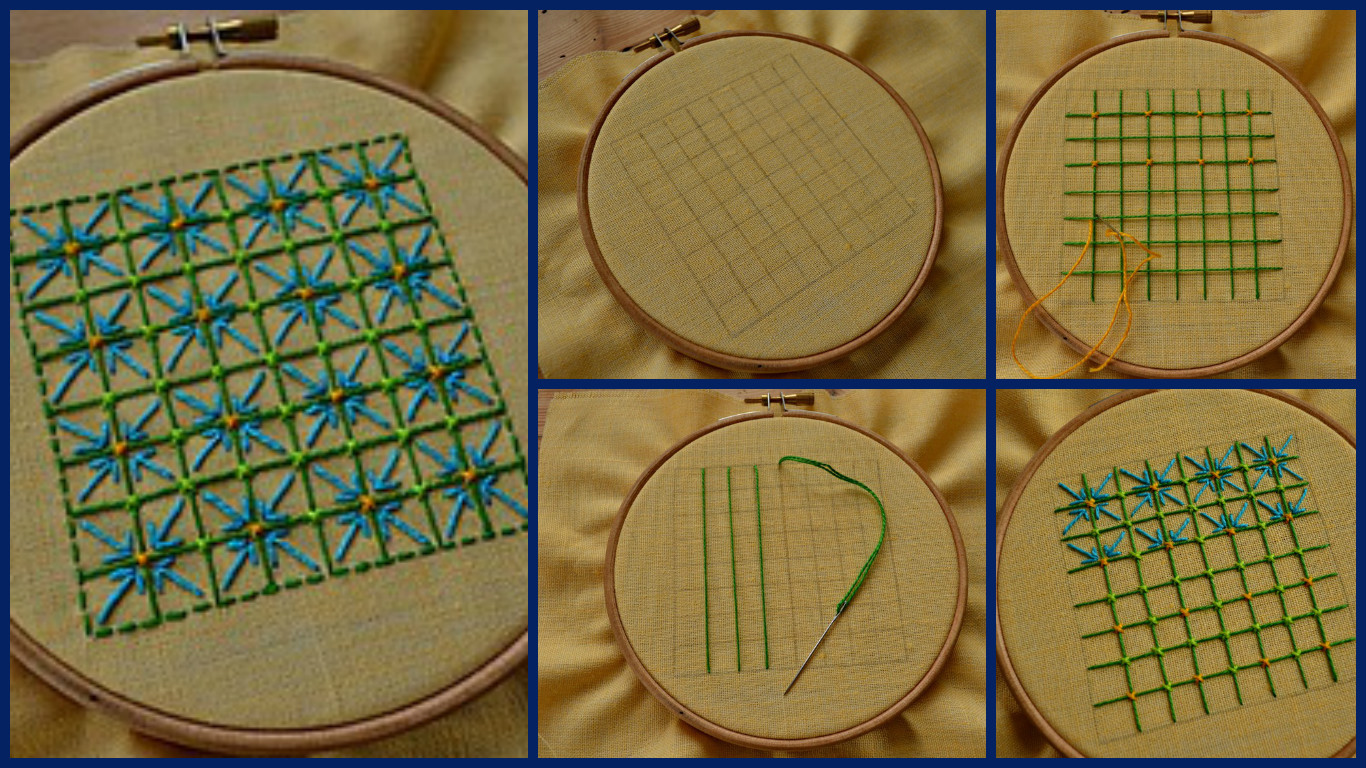
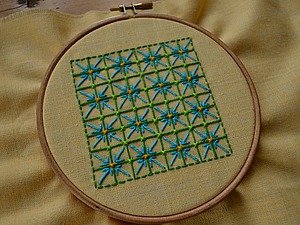
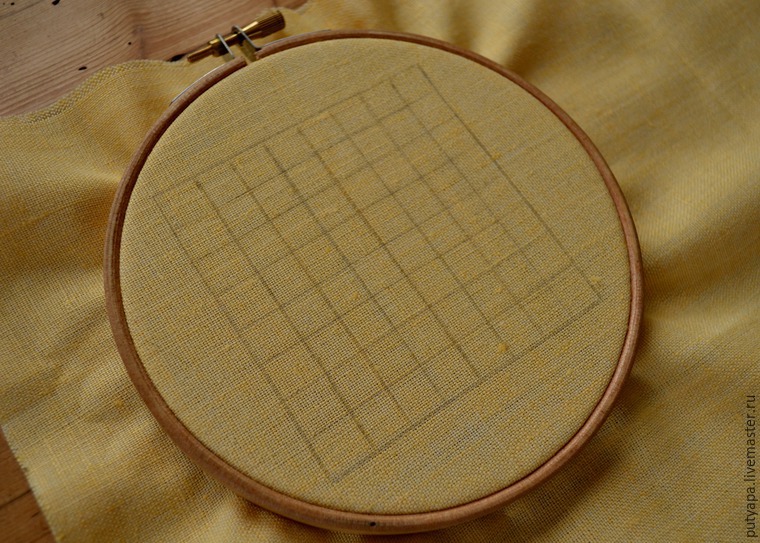 Further along the planned lines stretch yarn from left to right, then top to bottom (or vice versa – does not matter). On the contour of a square thread does not stretch at the end of it seem. You get such a grid:
Further along the planned lines stretch yarn from left to right, then top to bottom (or vice versa – does not matter). On the contour of a square thread does not stretch at the end of it seem. You get such a grid: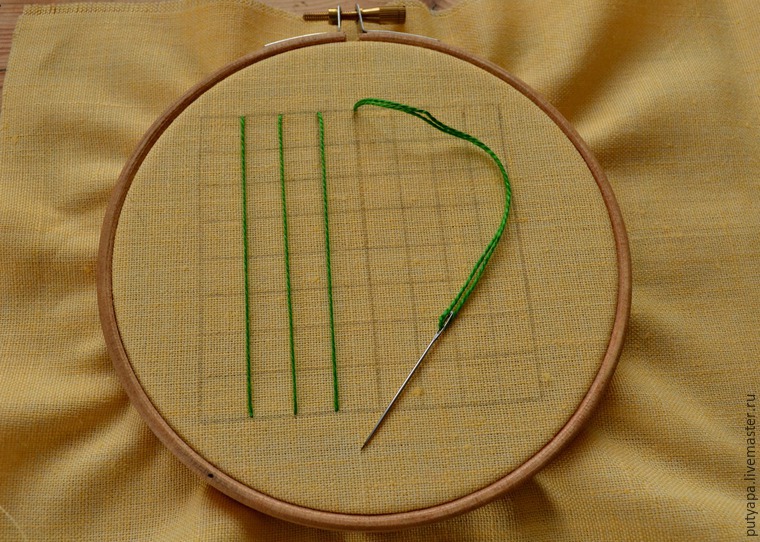
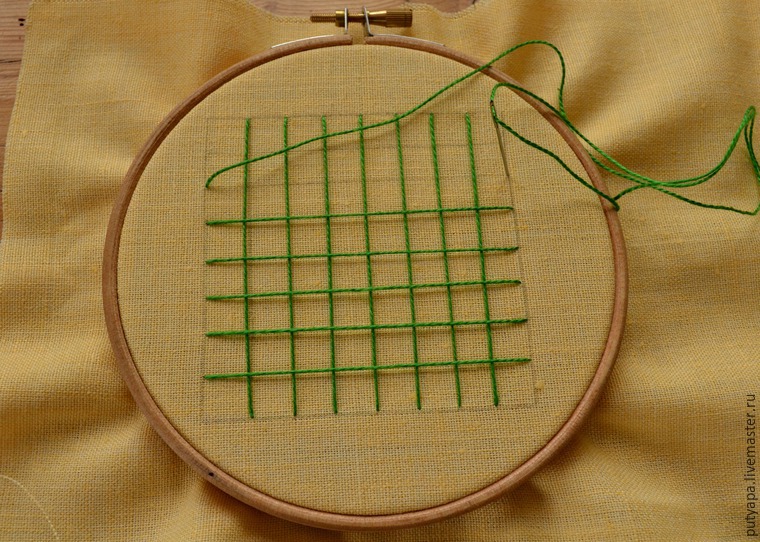
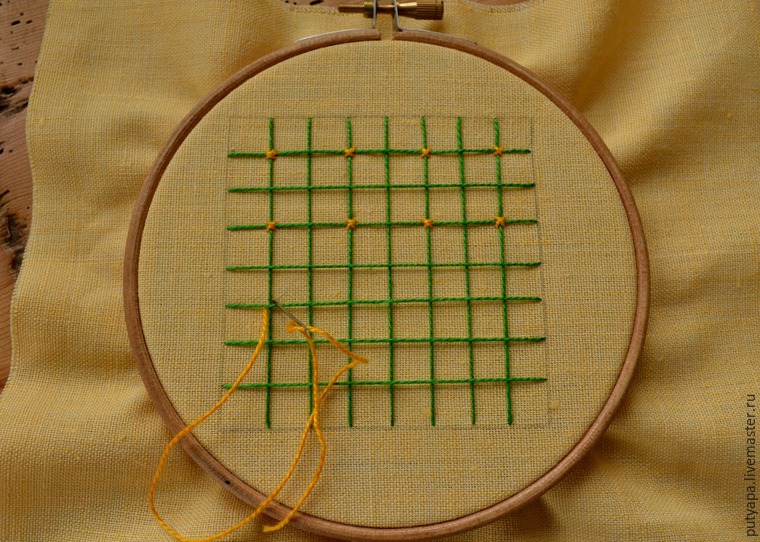
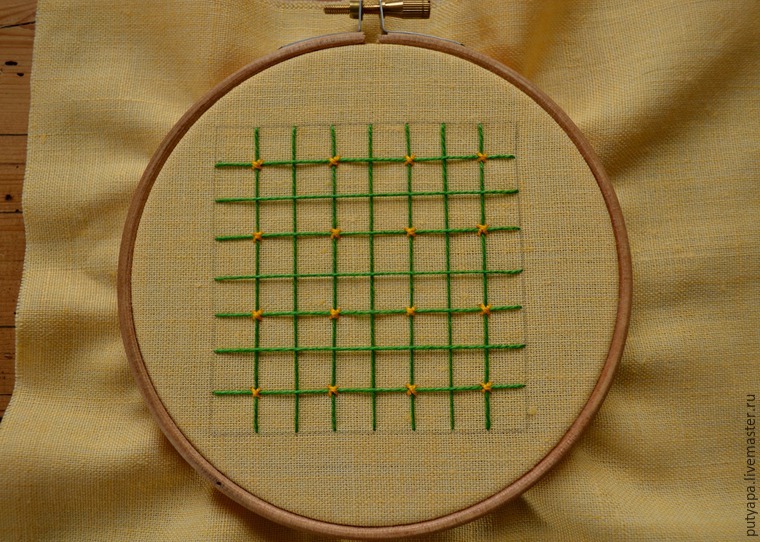 Then the rest of the crossing thread attach a cross thread of light green color. You get such a grid:
Then the rest of the crossing thread attach a cross thread of light green color. You get such a grid: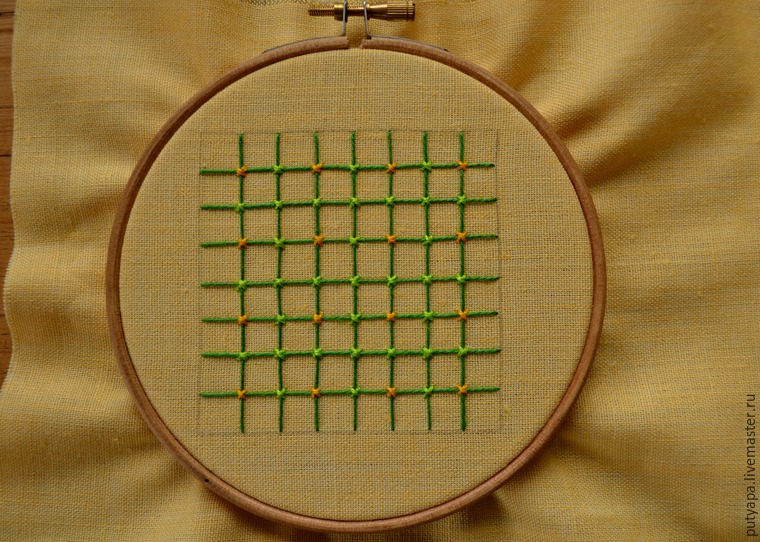 Now, in every cell of the resulting grid, we embroider cuts “legs”. This pattern is made of 3 stitches: 2 small stitches (approximately ) along the 2-sides of the square; and one stitch more – diagonally from one corner to another square. To “paws” to look nice and smooth, we make sure that all 3 stitches joined at one point.
Now, in every cell of the resulting grid, we embroider cuts “legs”. This pattern is made of 3 stitches: 2 small stitches (approximately ) along the 2-sides of the square; and one stitch more – diagonally from one corner to another square. To “paws” to look nice and smooth, we make sure that all 3 stitches joined at one point.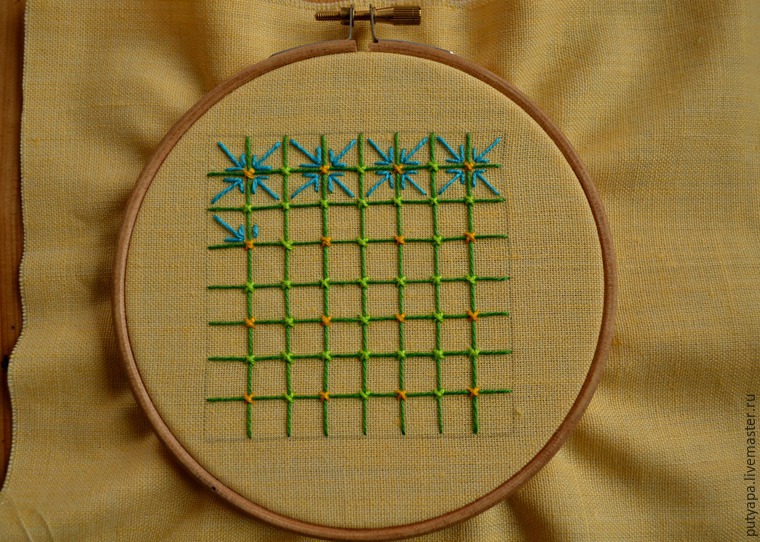
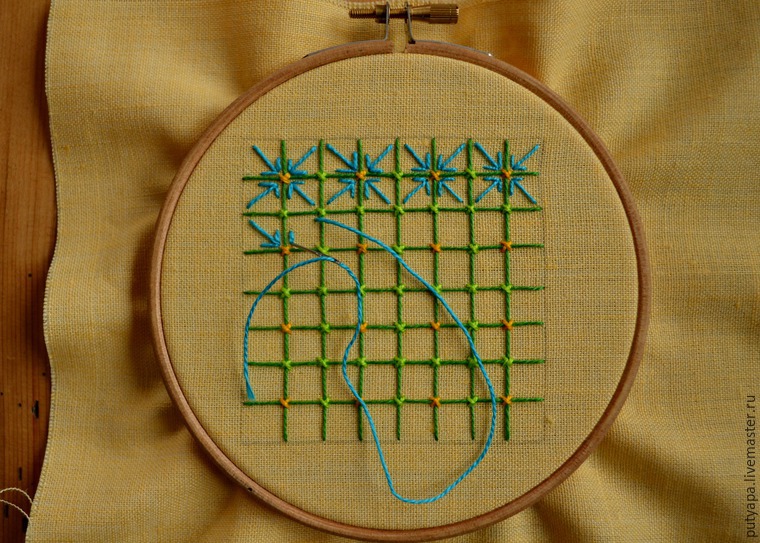
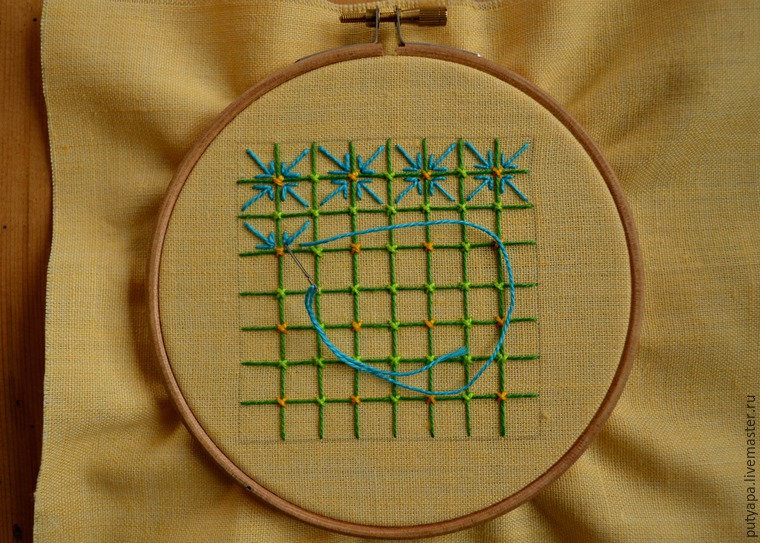 Fill cells “tabs” from left to right, top row first flowers future, then lower.
Fill cells “tabs” from left to right, top row first flowers future, then lower.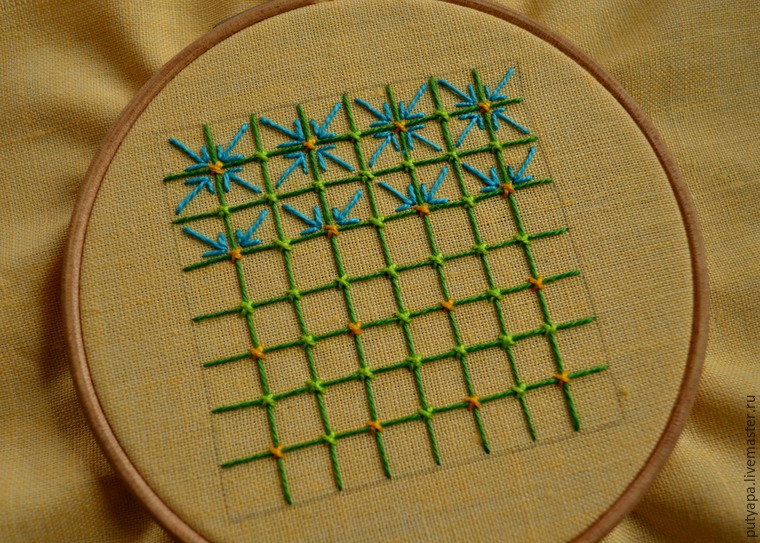
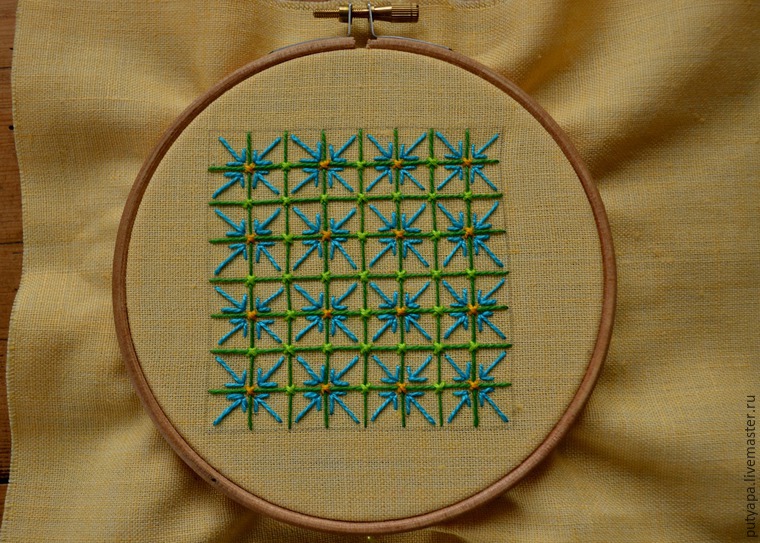 At the end of our work we are sheathed circuit stalk seam or seam “forward needle”. So, our job is ready:
At the end of our work we are sheathed circuit stalk seam or seam “forward needle”. So, our job is ready: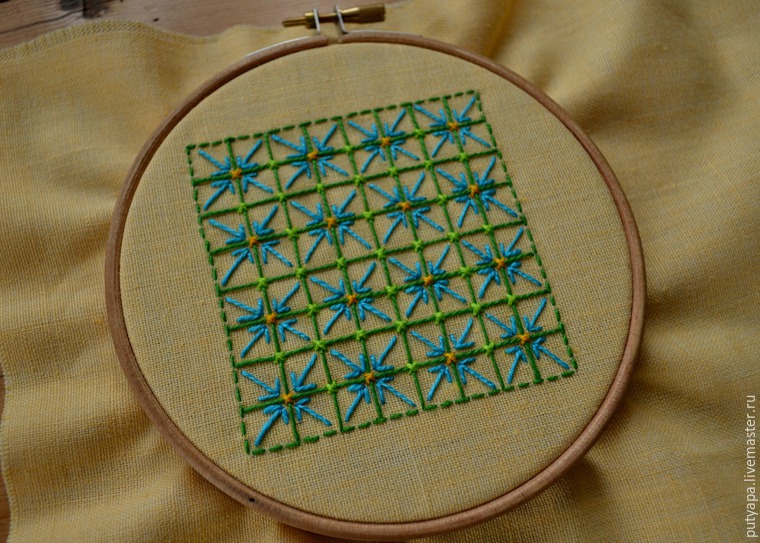 Here is an example of the finished product using this pattern – delicate daisies.
Here is an example of the finished product using this pattern – delicate daisies.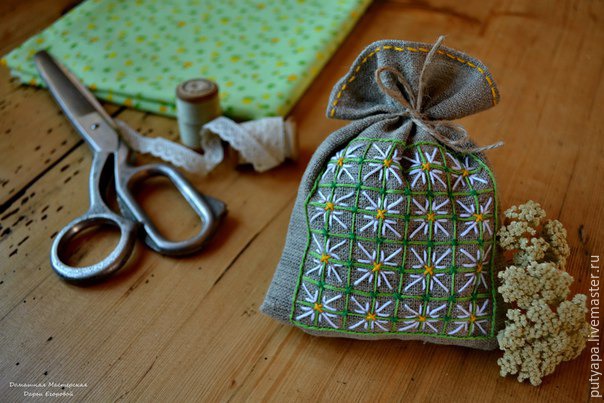 I hope my master class was someone interesting and useful. To be continued, Until we meet again!
I hope my master class was someone interesting and useful. To be continued, Until we meet again!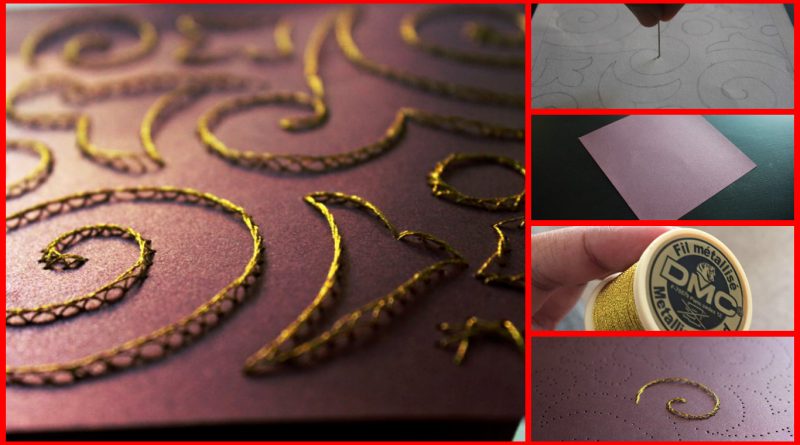
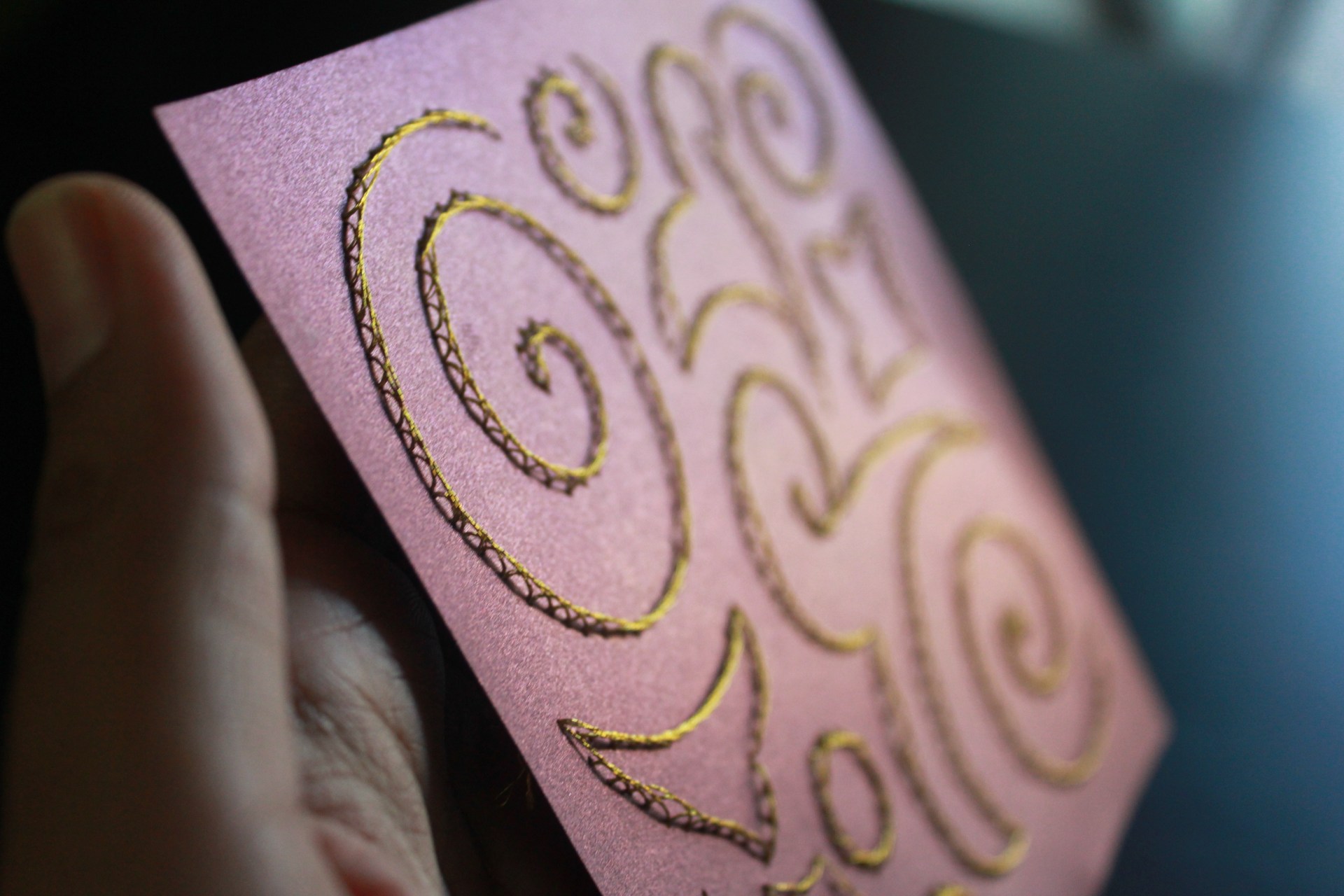
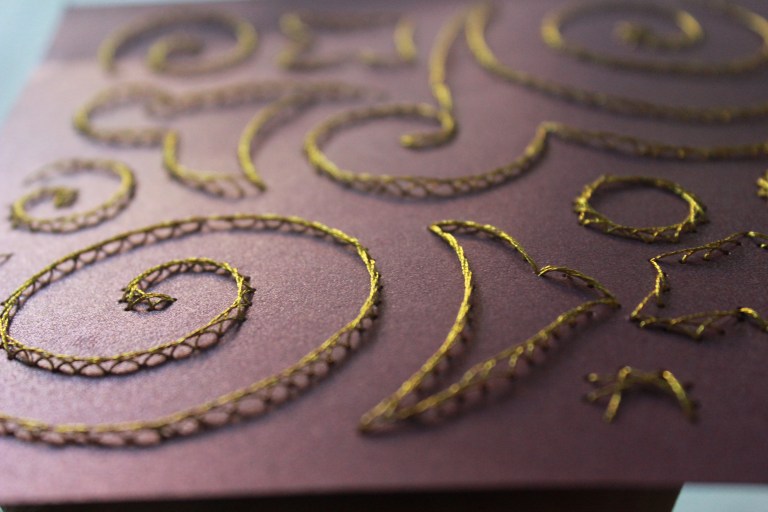
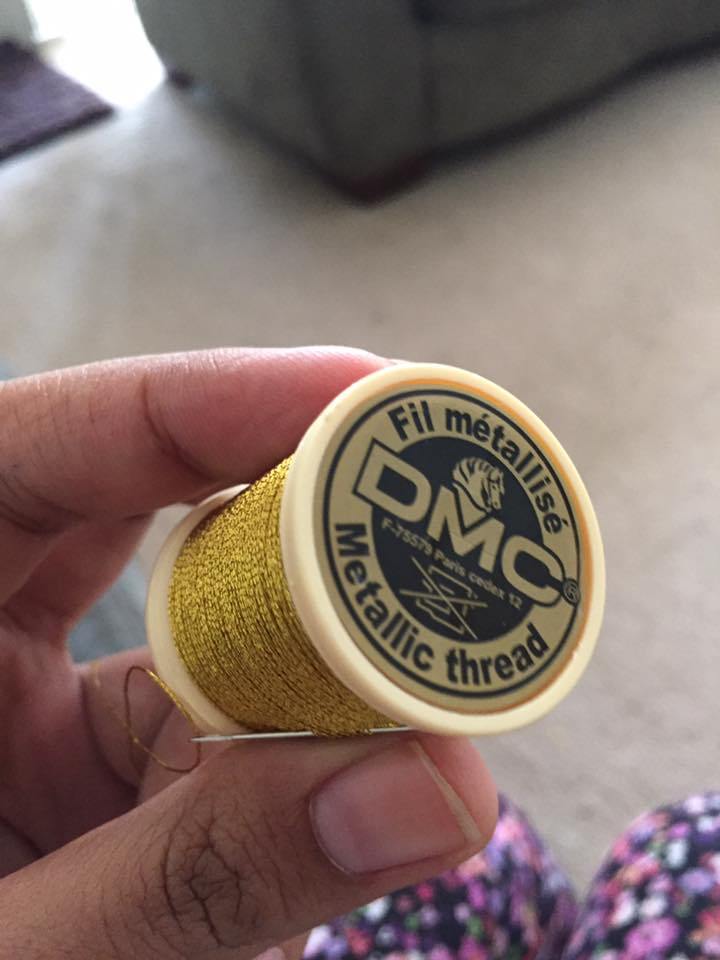 Procedure:
Procedure: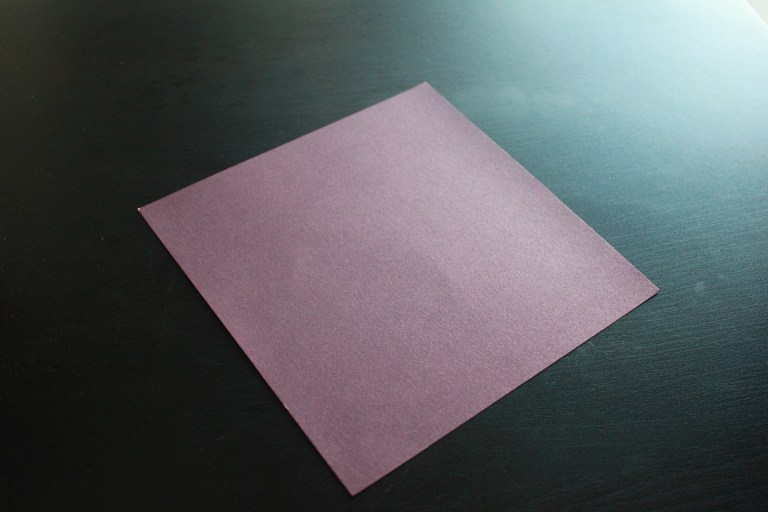 Cut 2 squares of equal size from foam board
Cut 2 squares of equal size from foam board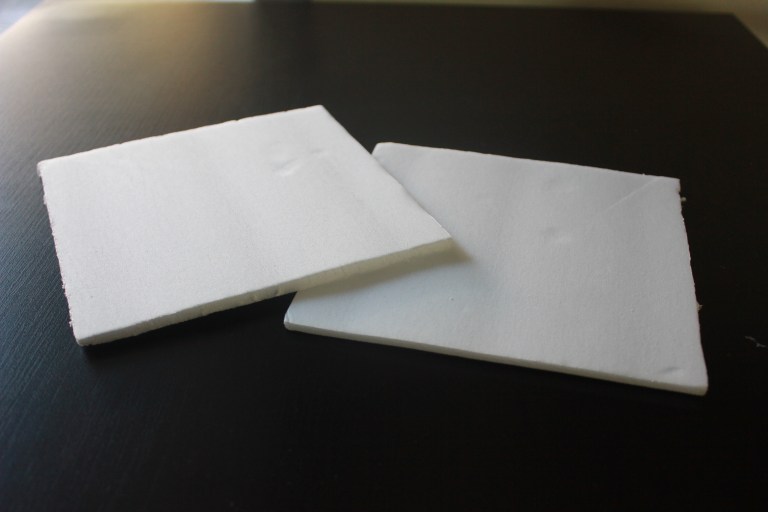 Draw a pattern to be embroidered on a paper. You can find patterns online. A lot of holiday patterns are available for purchase on Etsy. Some designer craft papers also come with beautiful printed patterns.
Draw a pattern to be embroidered on a paper. You can find patterns online. A lot of holiday patterns are available for purchase on Etsy. Some designer craft papers also come with beautiful printed patterns.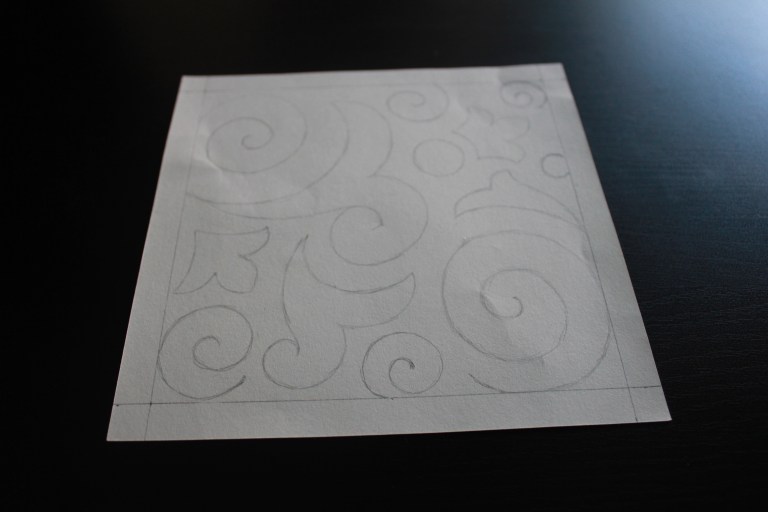 Stack up a foam board square, wine card stock paper and another foam board square on the top. Place the paper with design pattern on the top of the stack. Make sure everything is aligned and use adhesive tape to secure everything in place. This makes a perfect piercing mat!
Stack up a foam board square, wine card stock paper and another foam board square on the top. Place the paper with design pattern on the top of the stack. Make sure everything is aligned and use adhesive tape to secure everything in place. This makes a perfect piercing mat!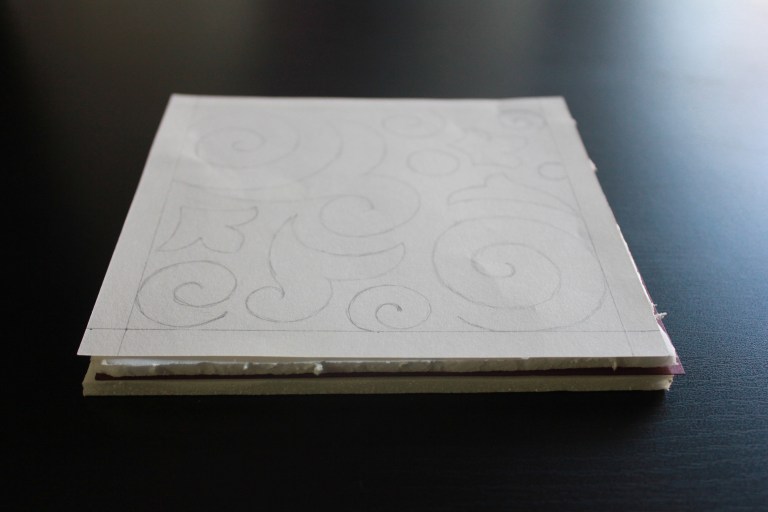 Start piercing along the lines using a piercing tool or a needle. If you are using a needle, protect your fingers while piercing.
Start piercing along the lines using a piercing tool or a needle. If you are using a needle, protect your fingers while piercing.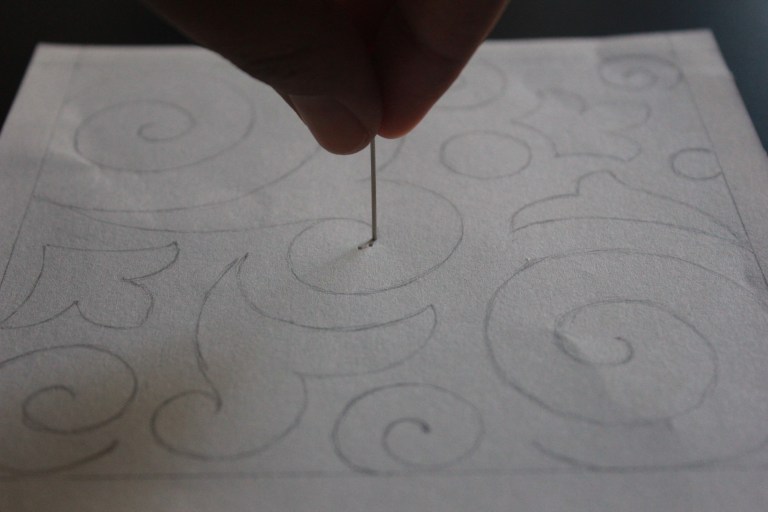
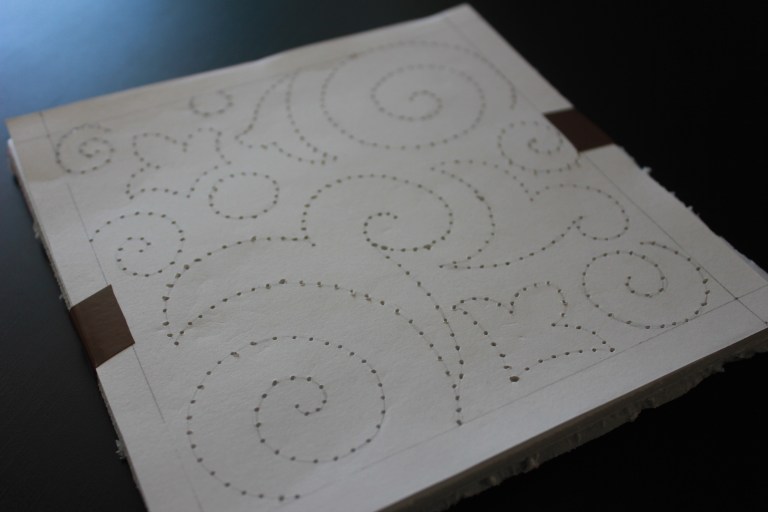 Once the complete pattern is pierced, open the adhesive tape and separate the perfectly pierced cardstock paper. Hold it against the source of light to make sure you did not miss any part of design.
Once the complete pattern is pierced, open the adhesive tape and separate the perfectly pierced cardstock paper. Hold it against the source of light to make sure you did not miss any part of design.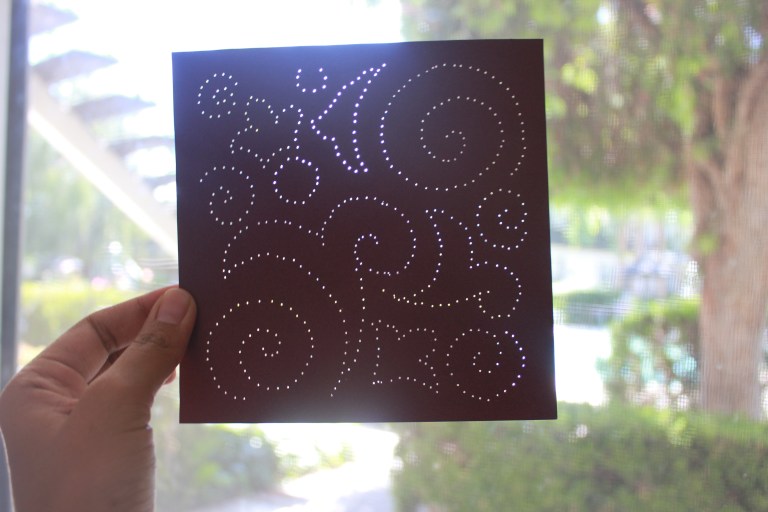 Next, we need to stitch on the paper. There are several different ways to stitch on paper. I am not an expert in stitching, so I have used a very simple stitching method. Start by threading a strand of floss into the eye of a needle.
Next, we need to stitch on the paper. There are several different ways to stitch on paper. I am not an expert in stitching, so I have used a very simple stitching method. Start by threading a strand of floss into the eye of a needle.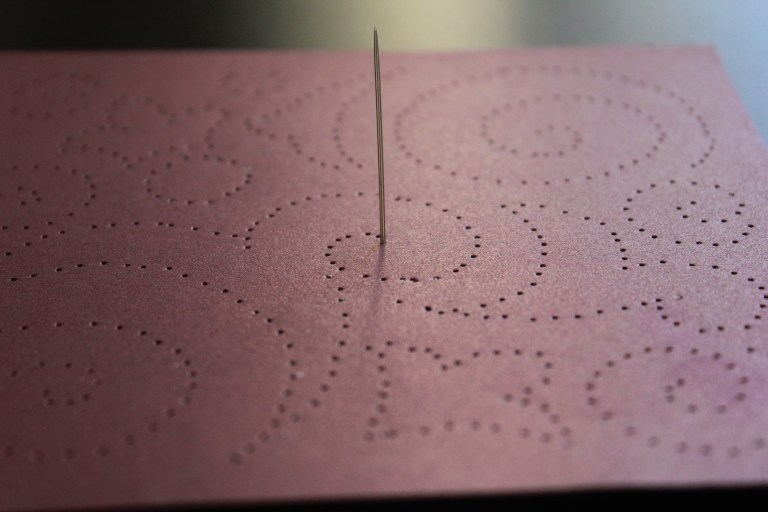 Skip next two holes and go down from the third hole.
Skip next two holes and go down from the third hole.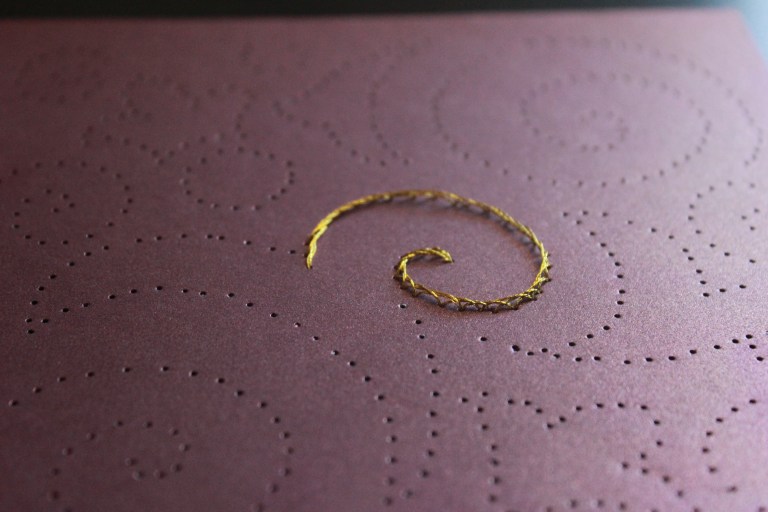
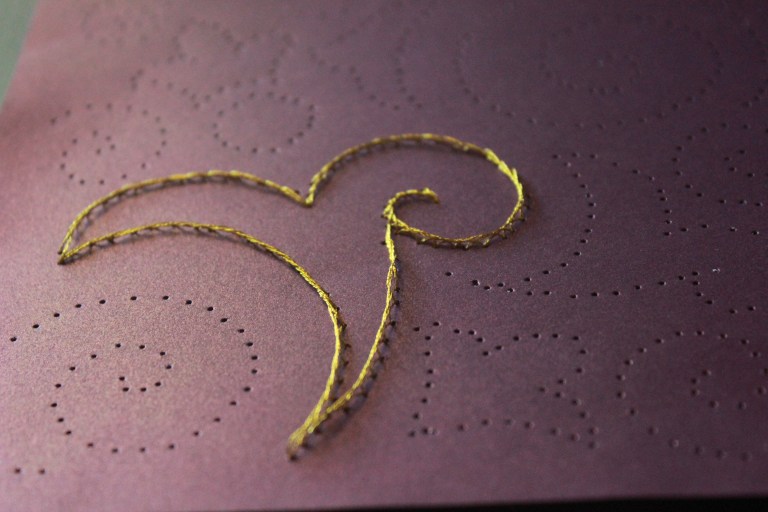
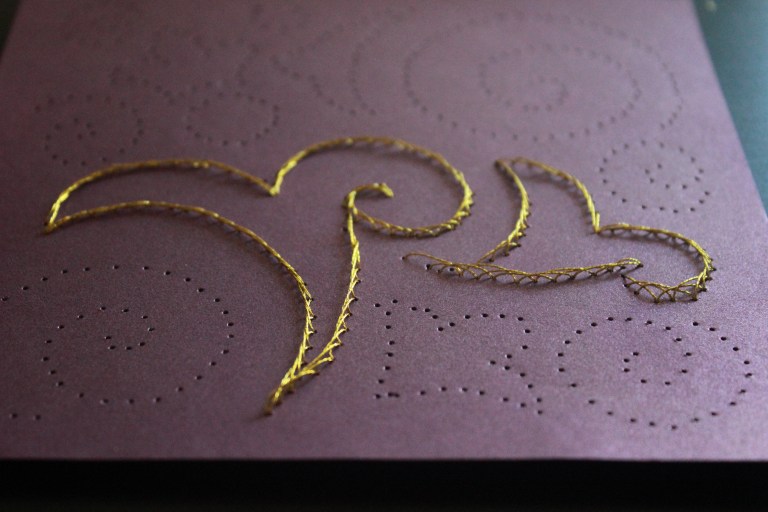
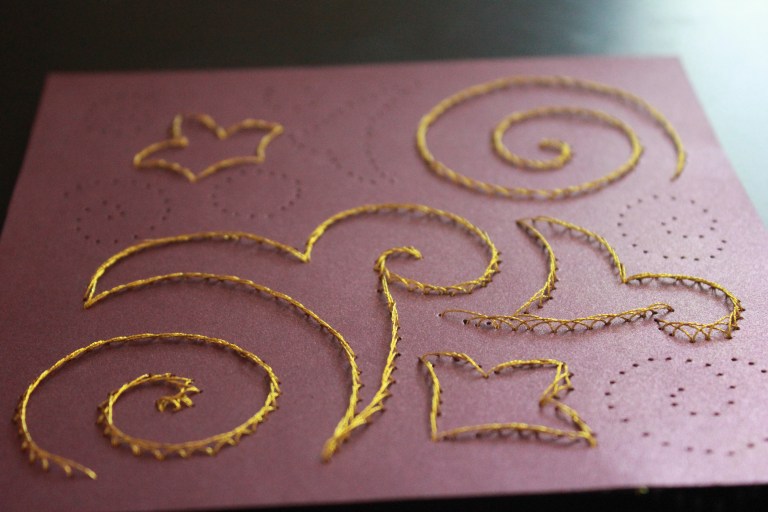

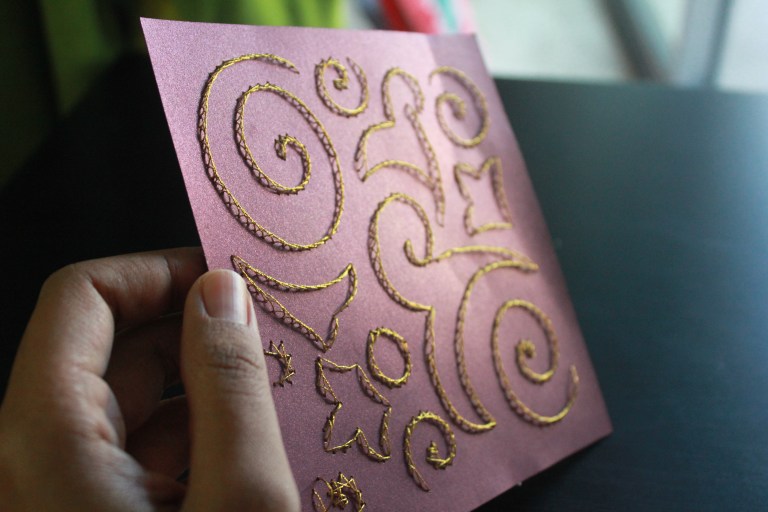 Thank you for visiting! We really appreciate
Thank you for visiting! We really appreciate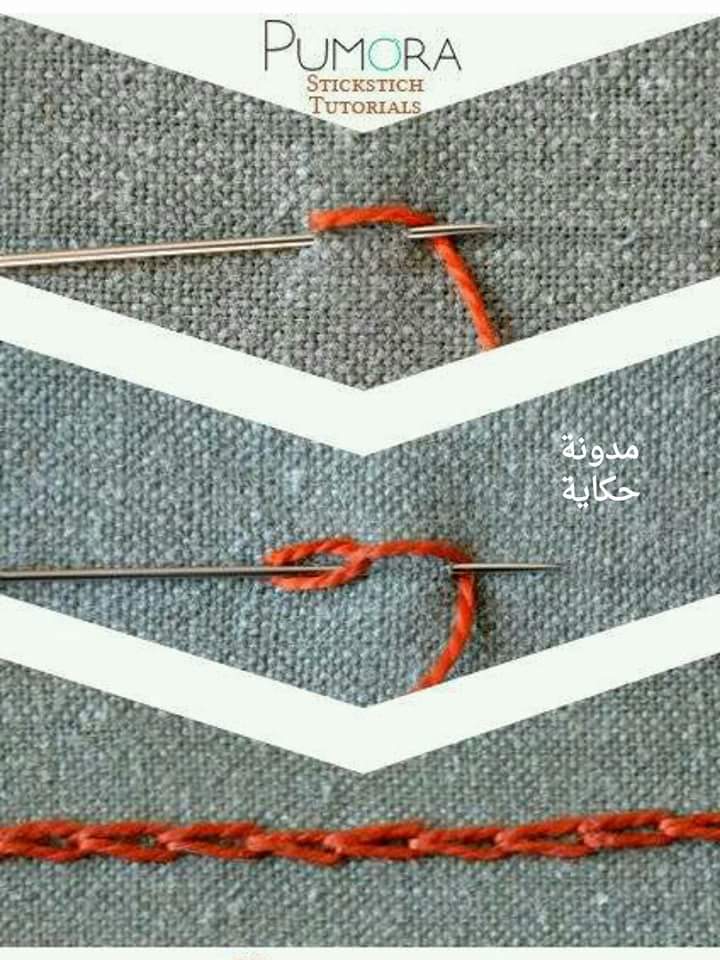
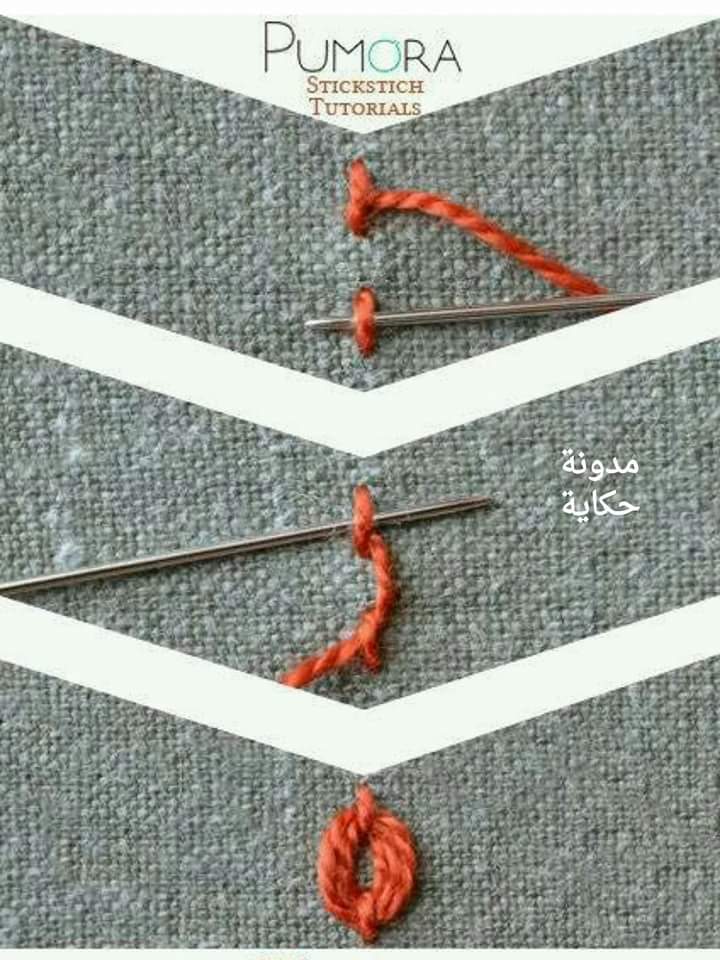
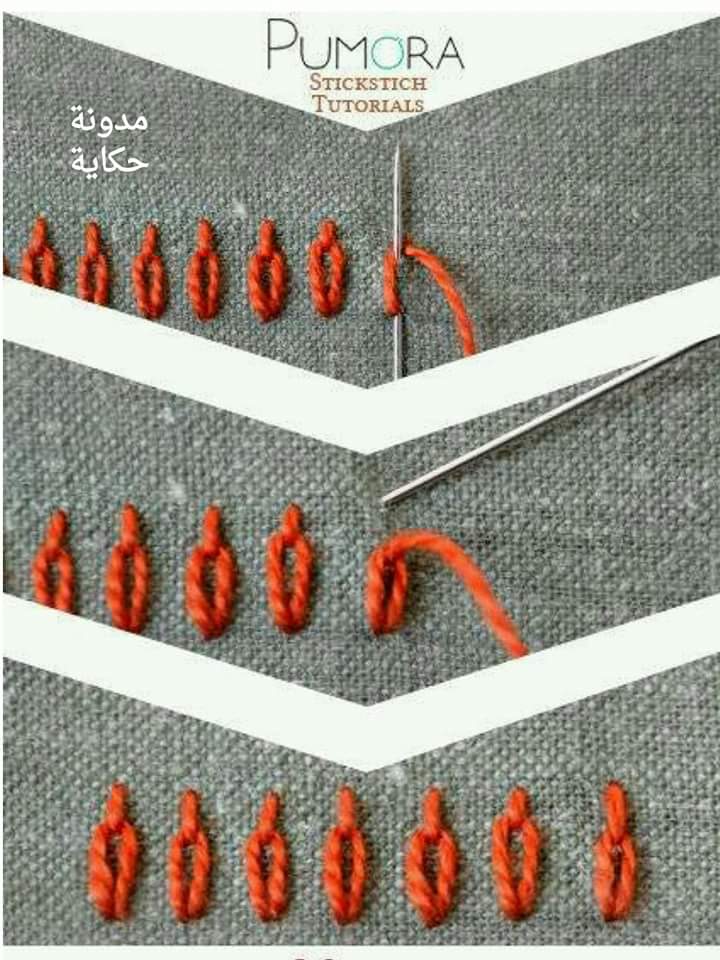
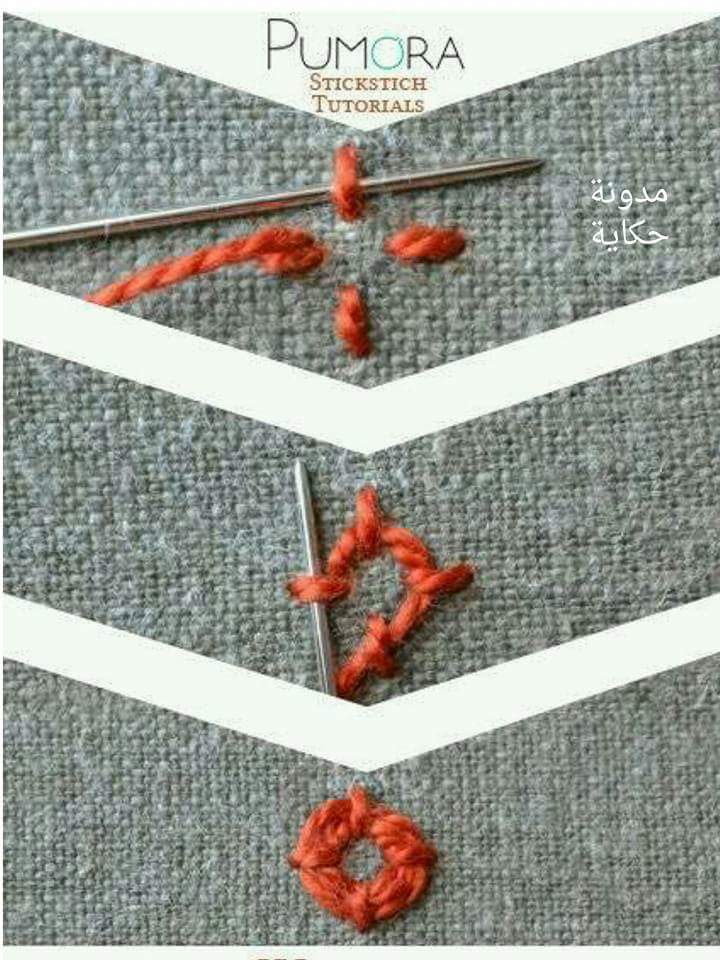
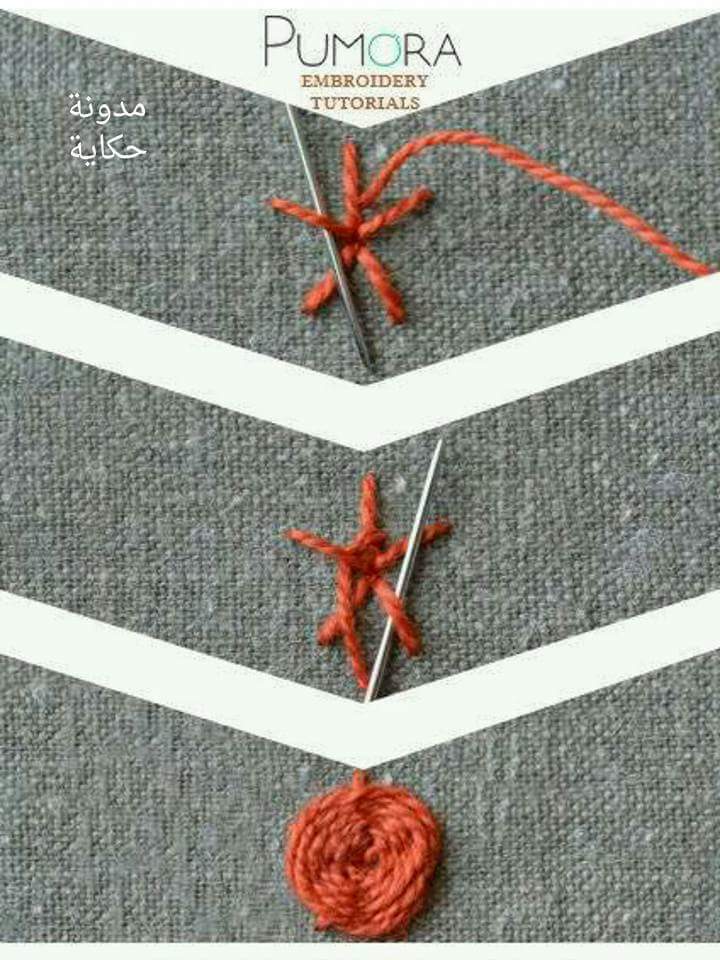
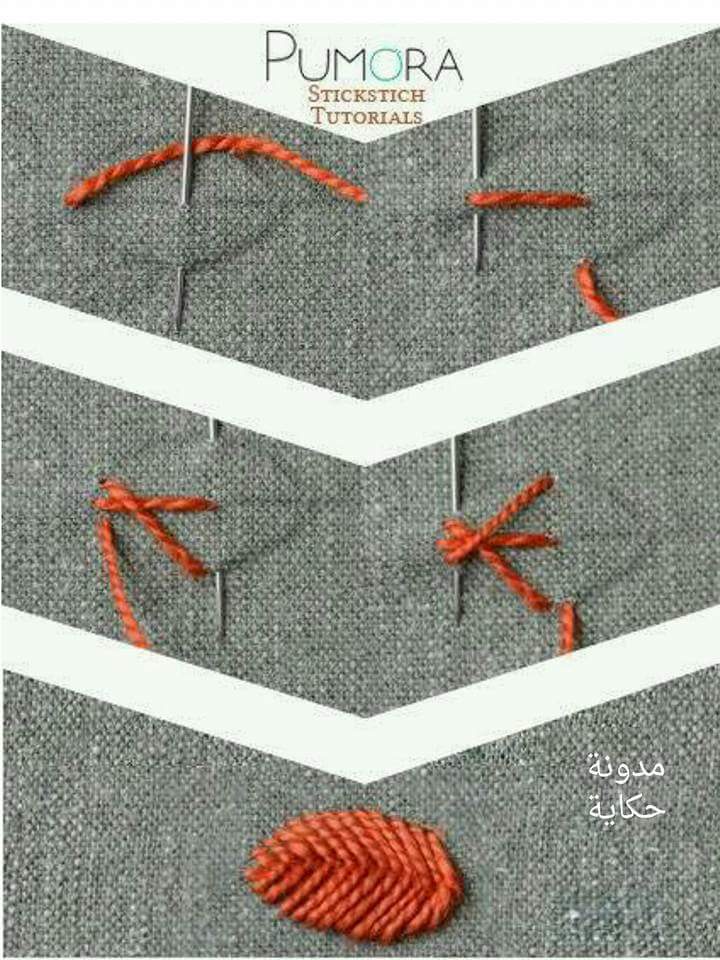
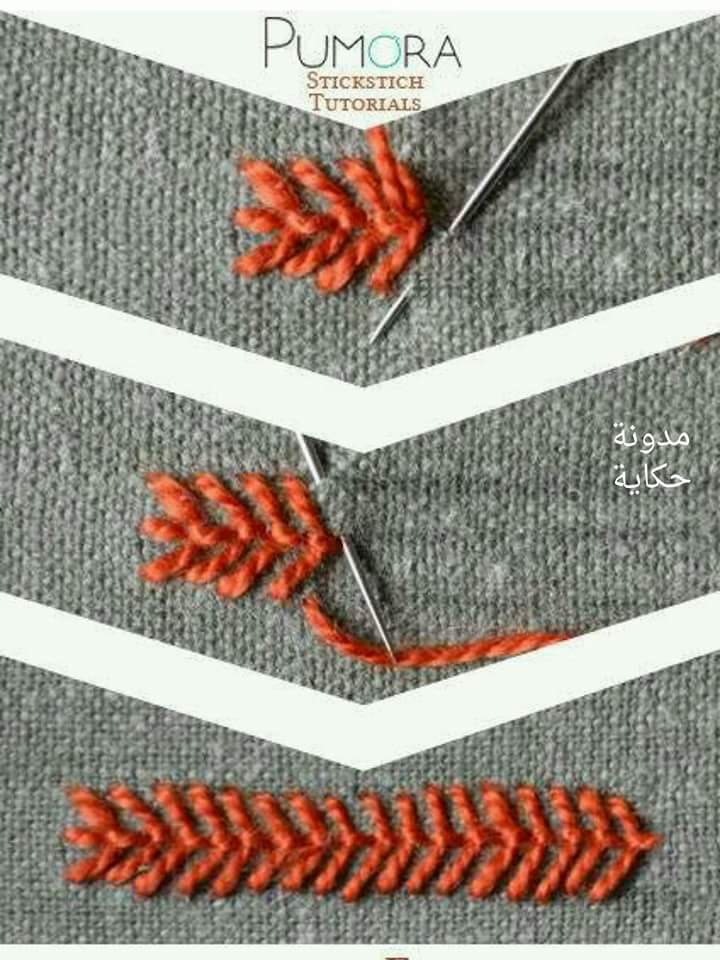
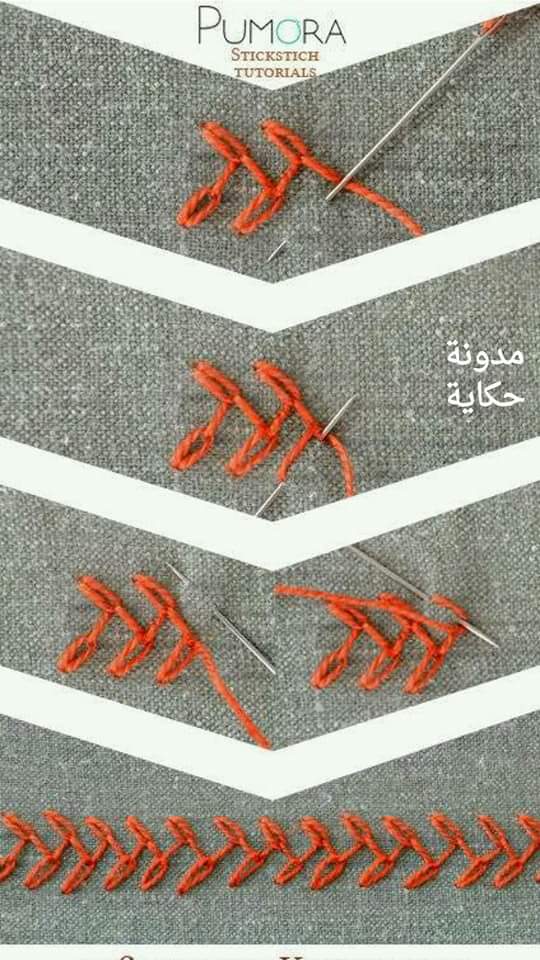
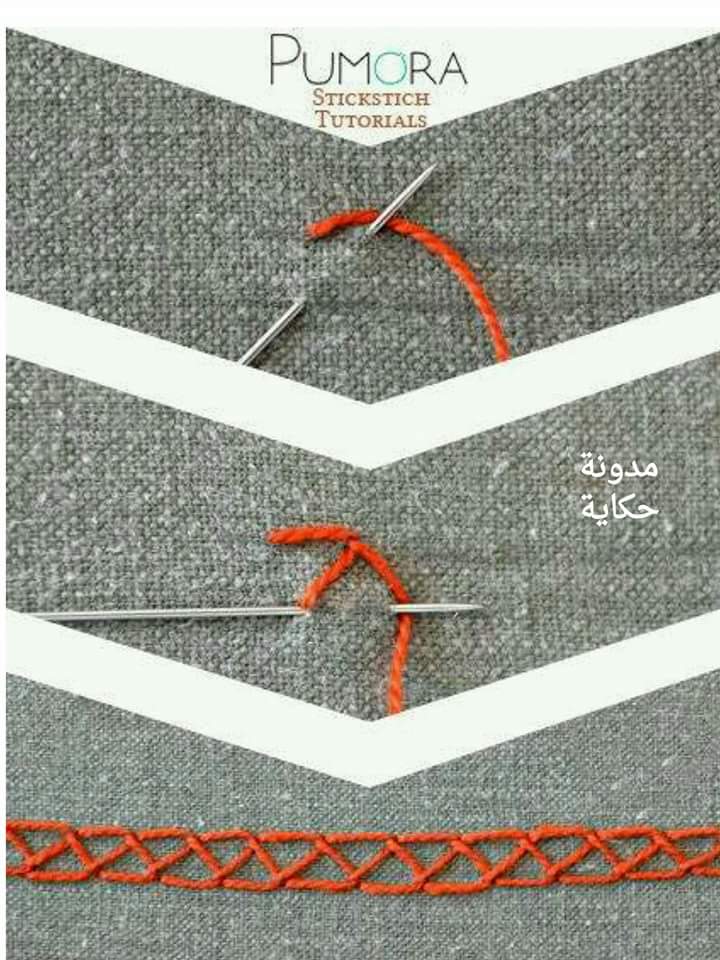
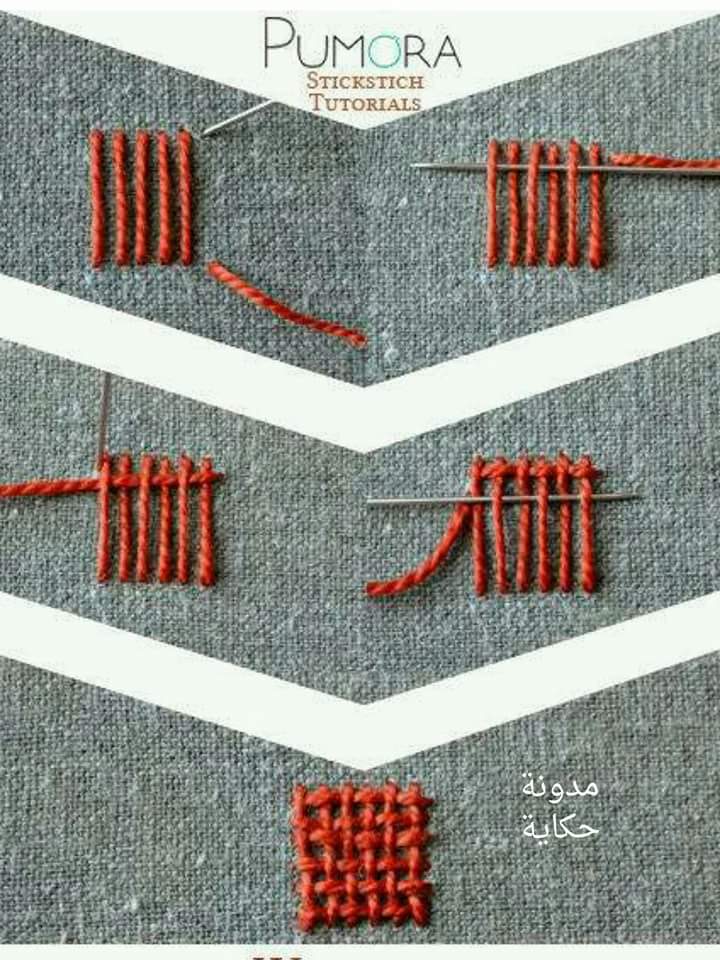
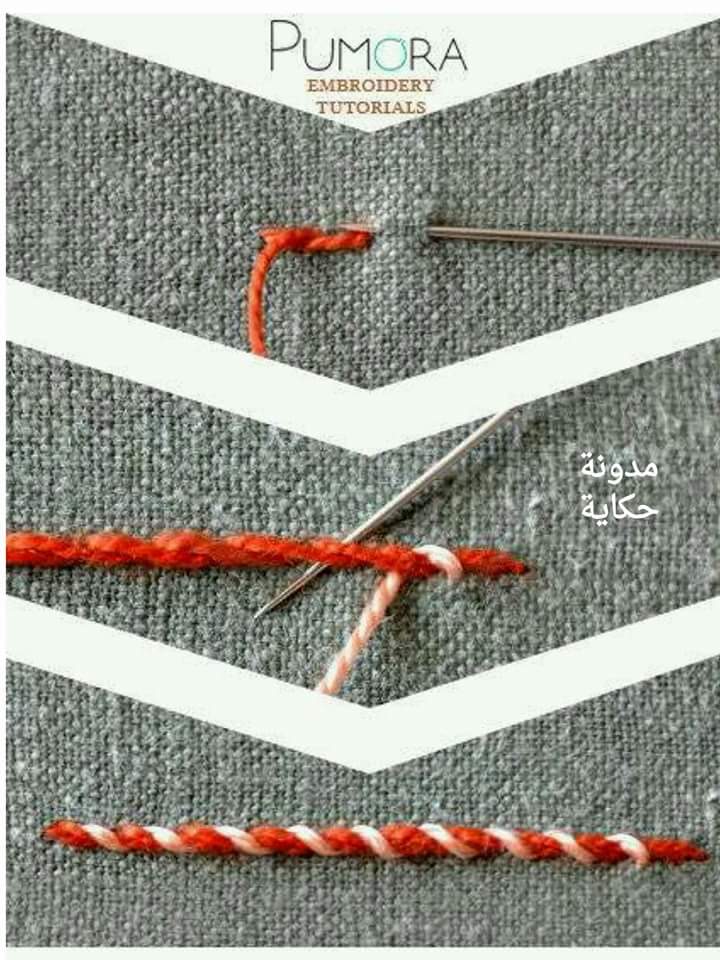
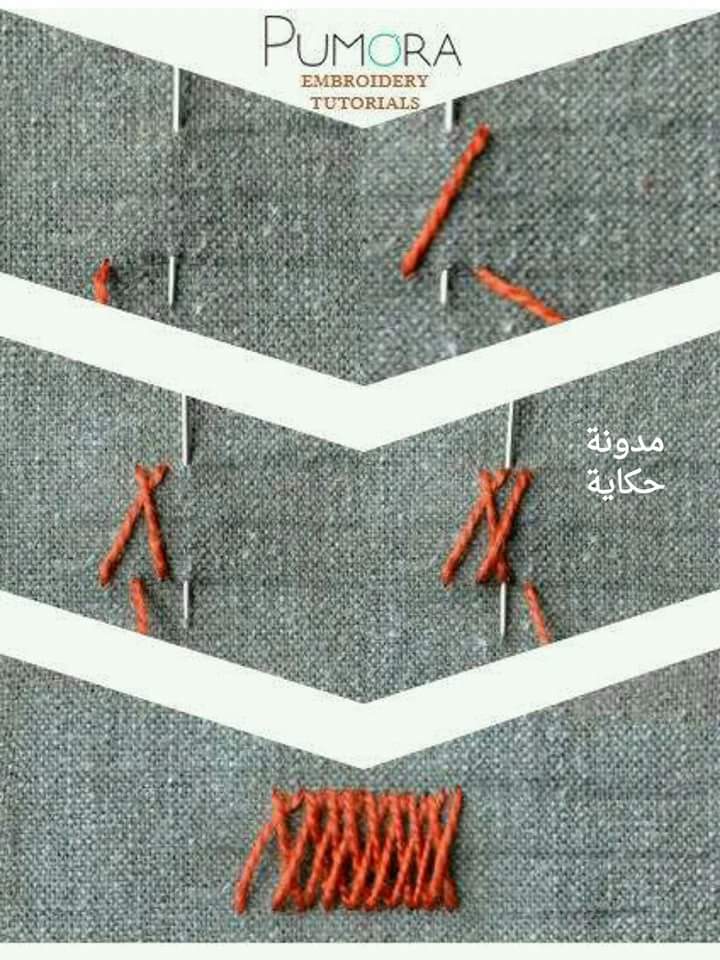
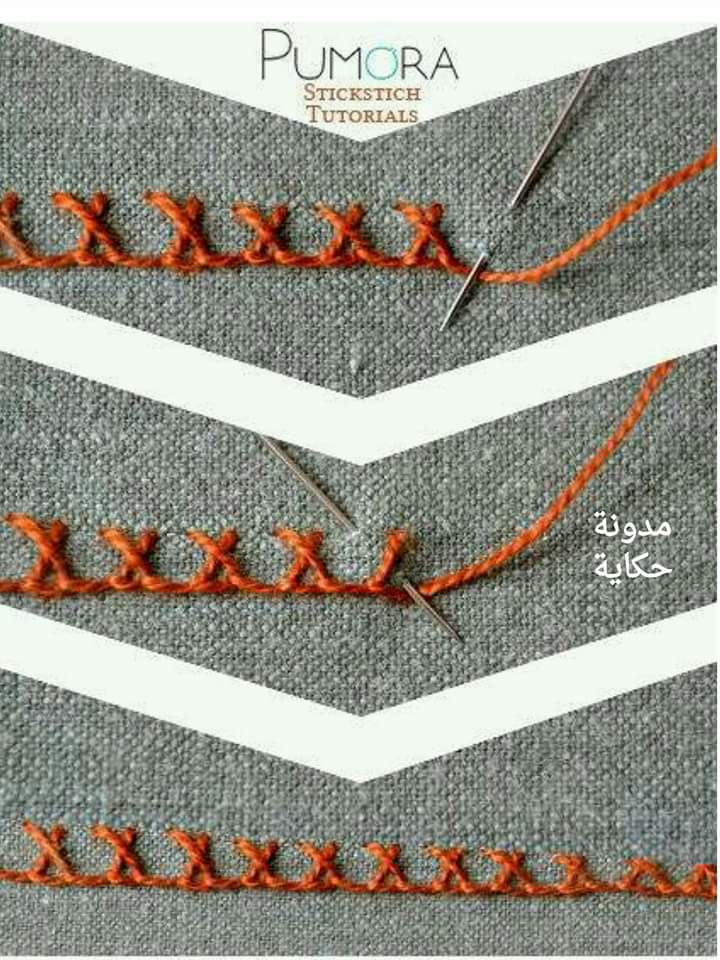

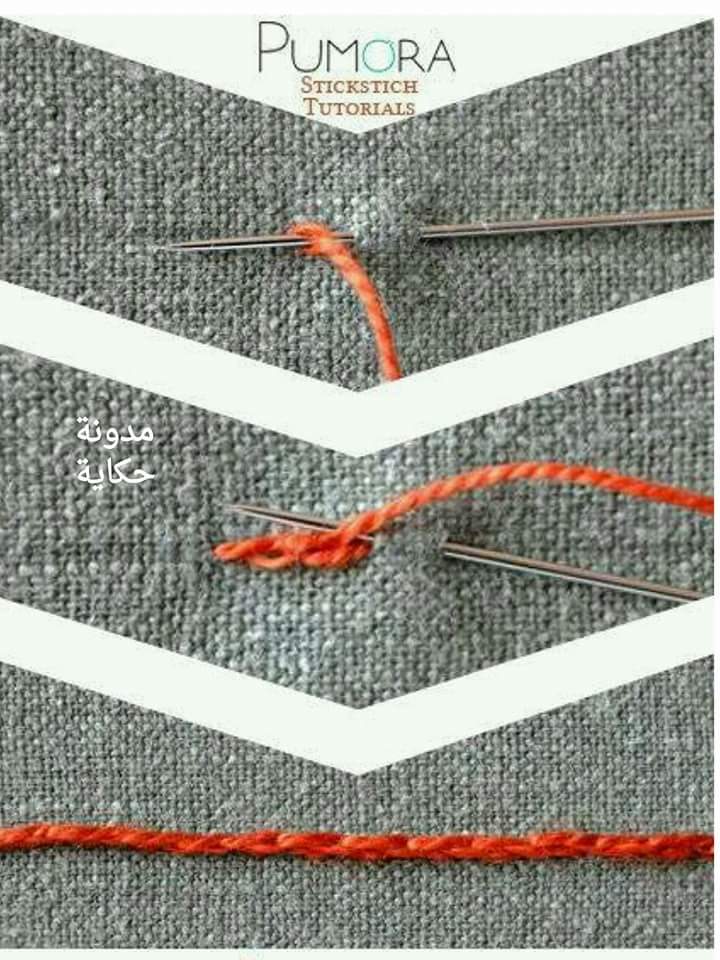
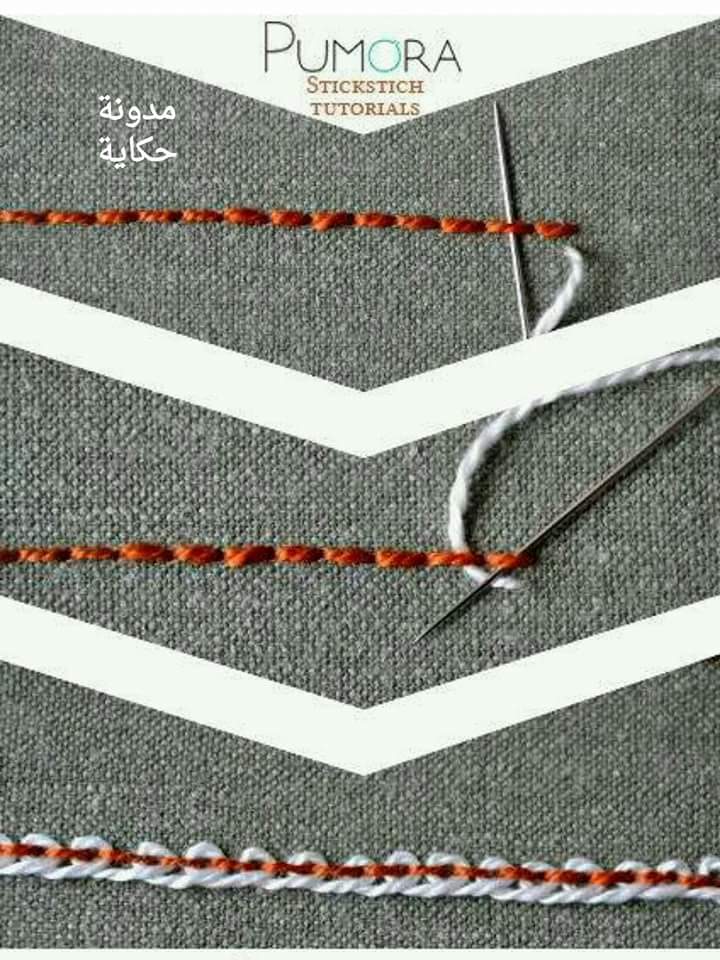
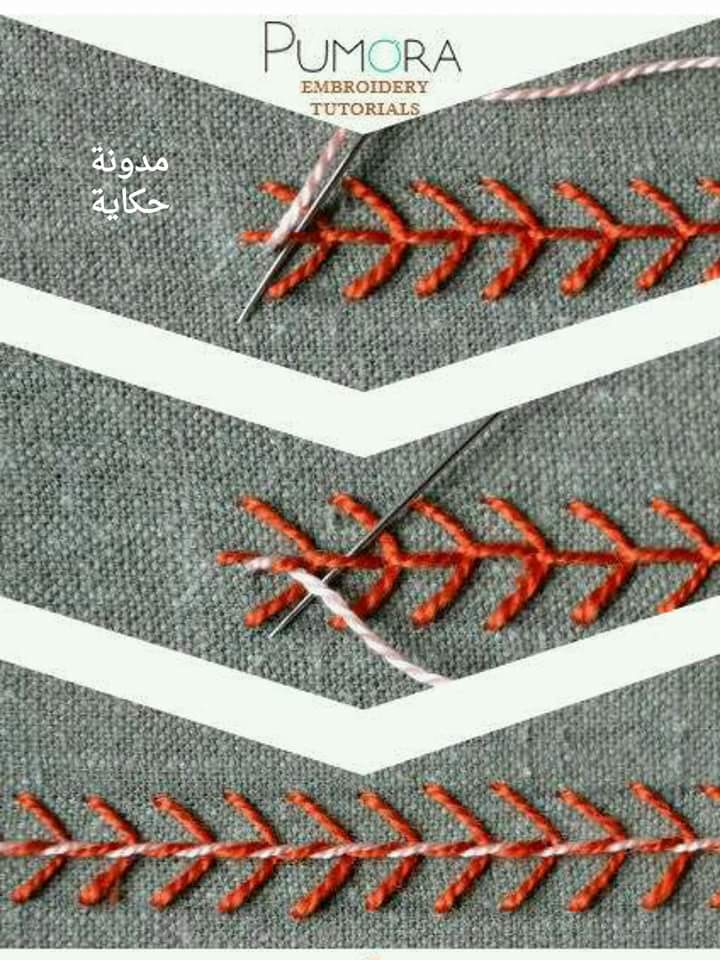
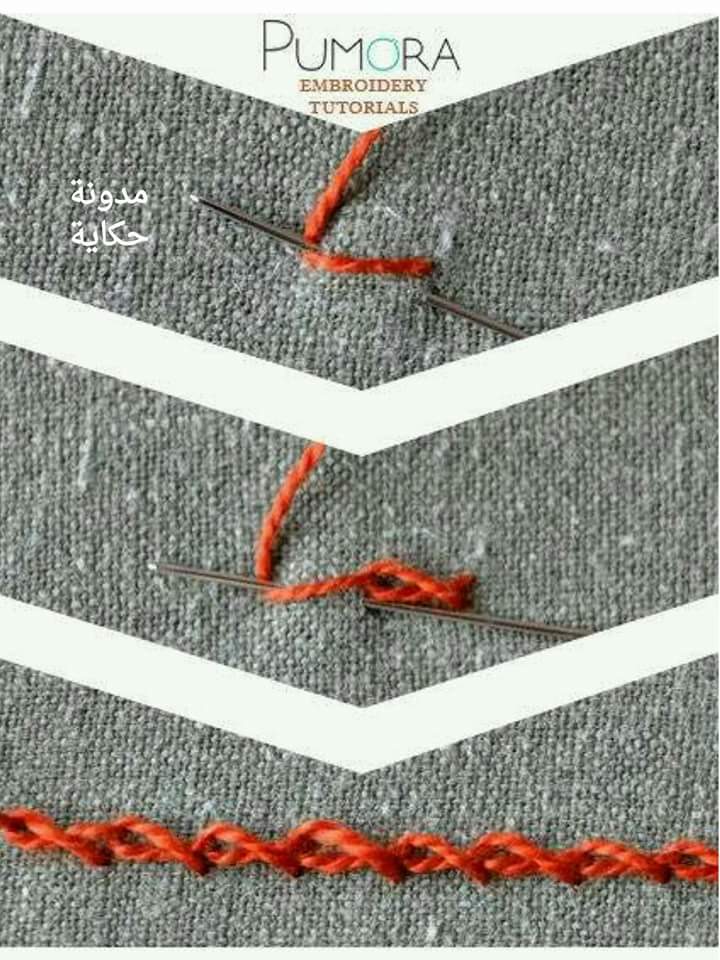

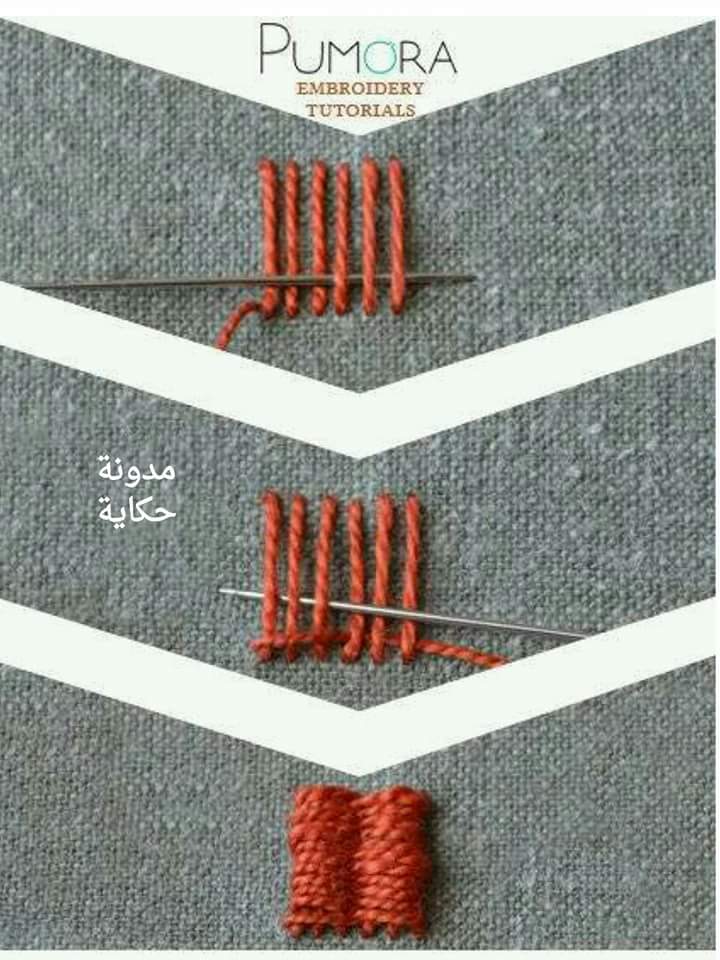
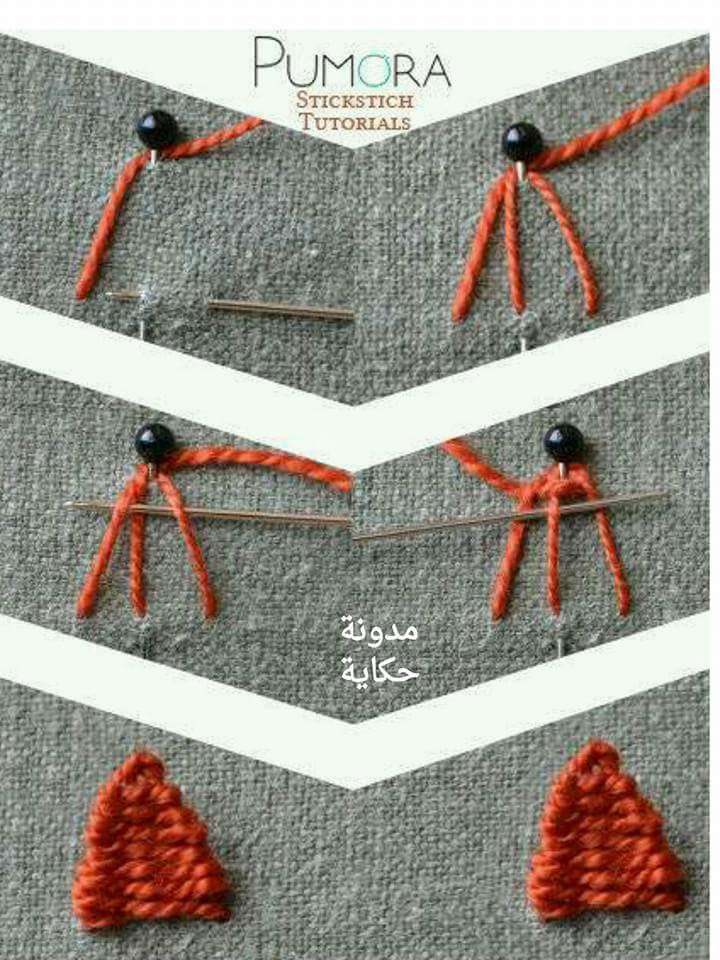
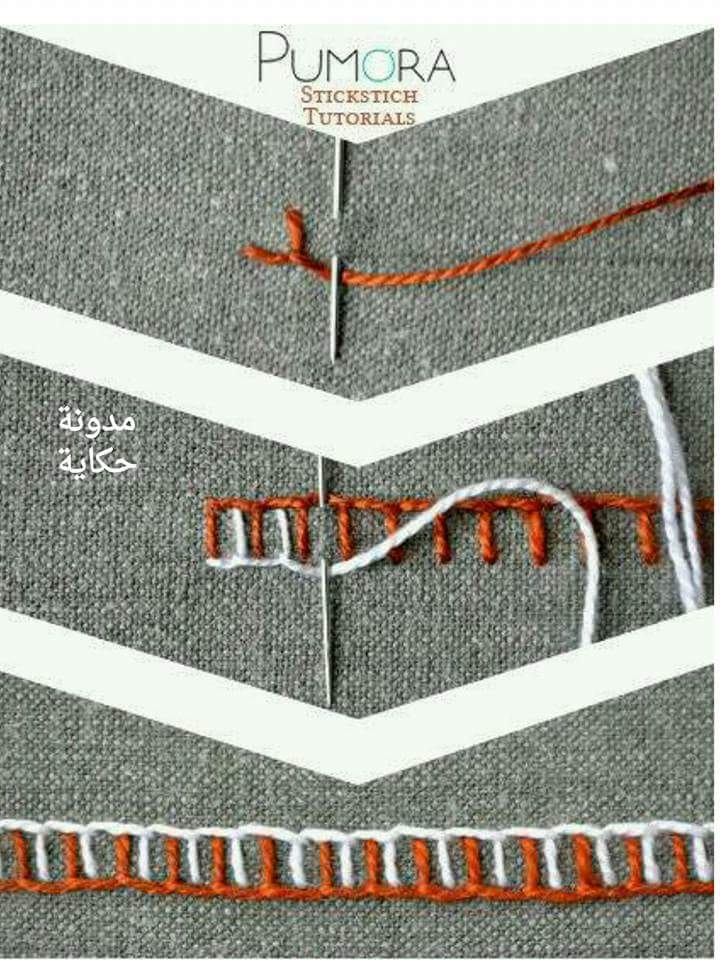
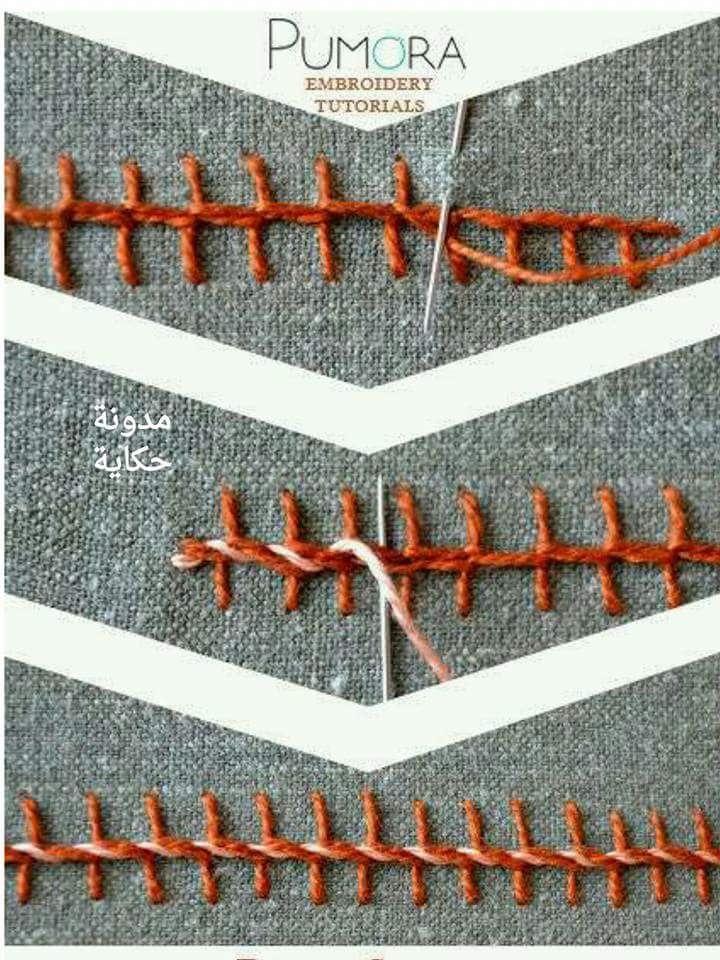
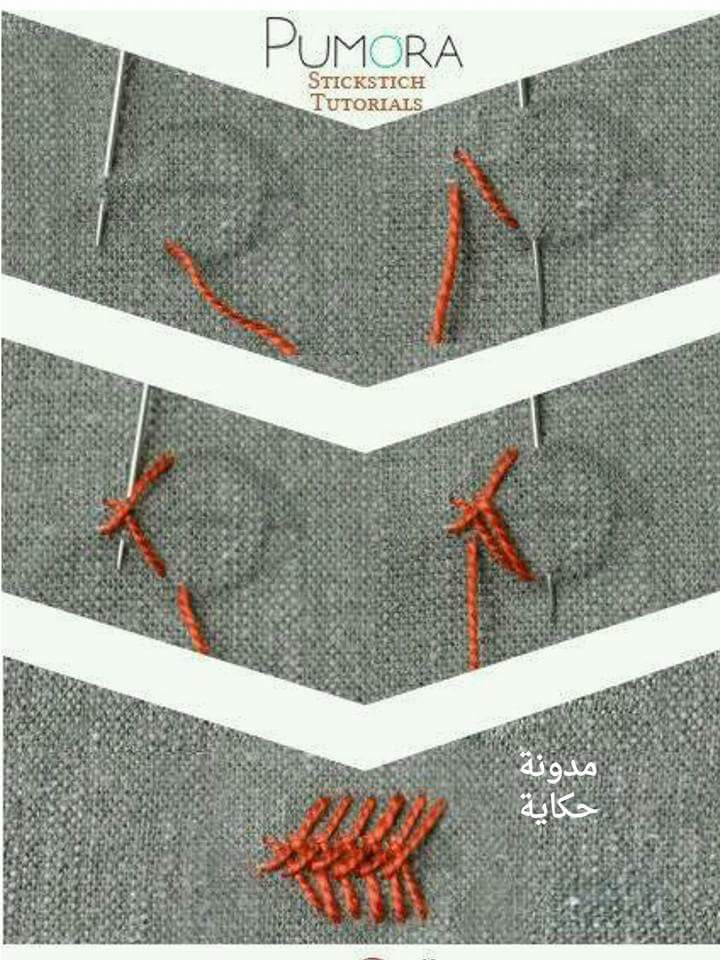
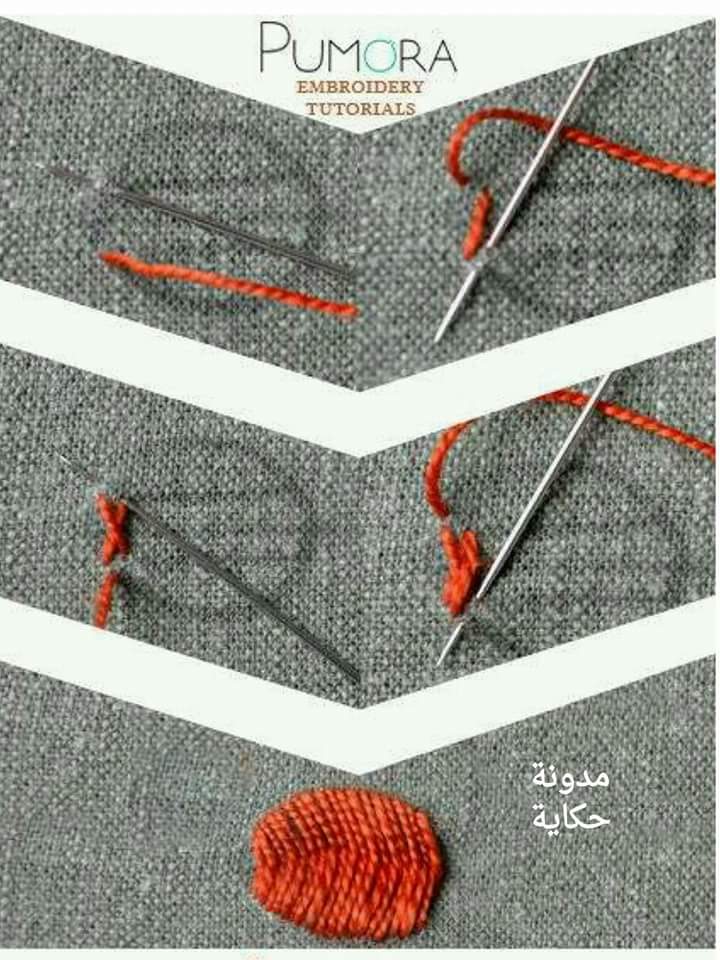
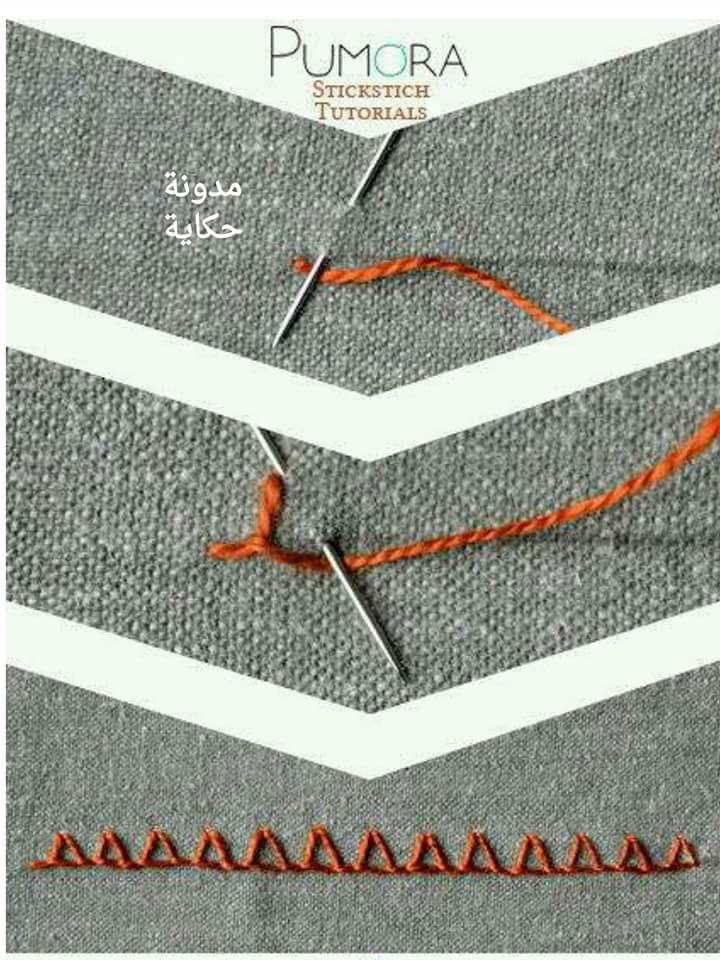
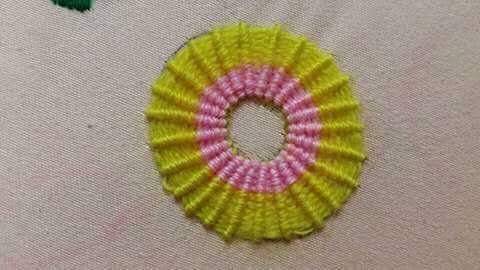
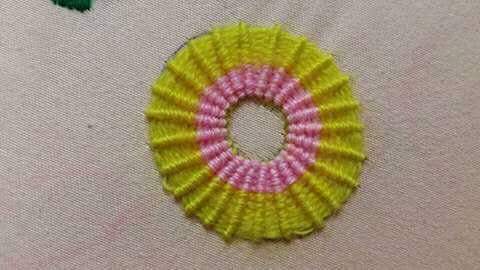
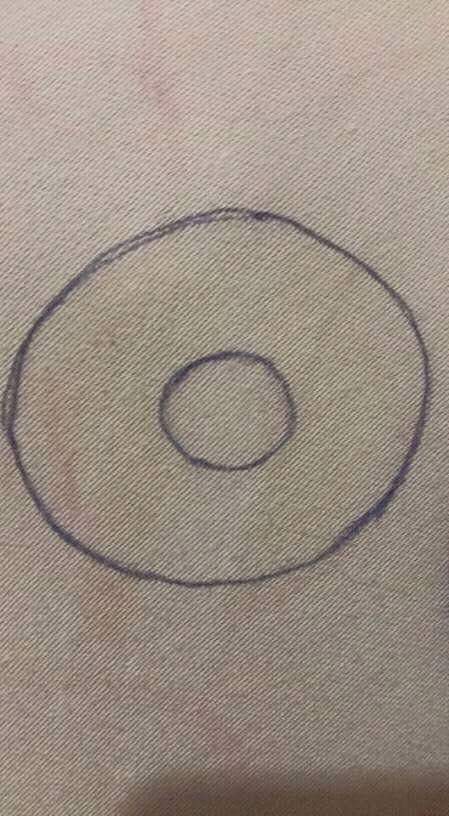
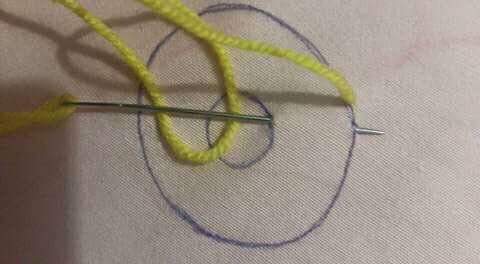
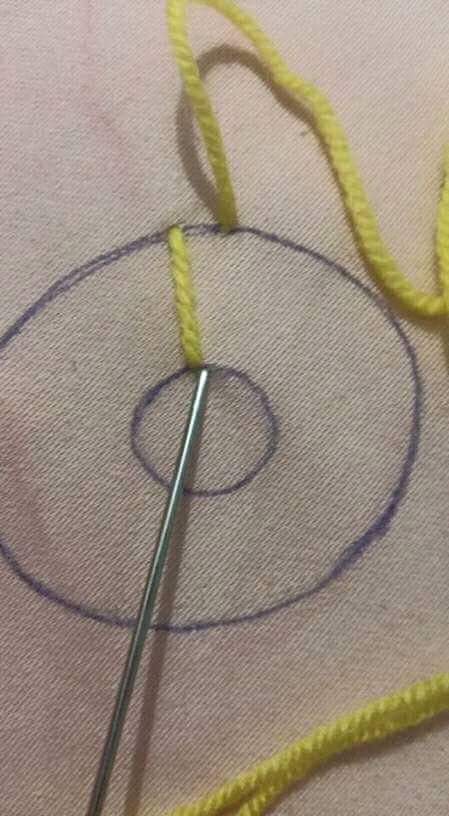
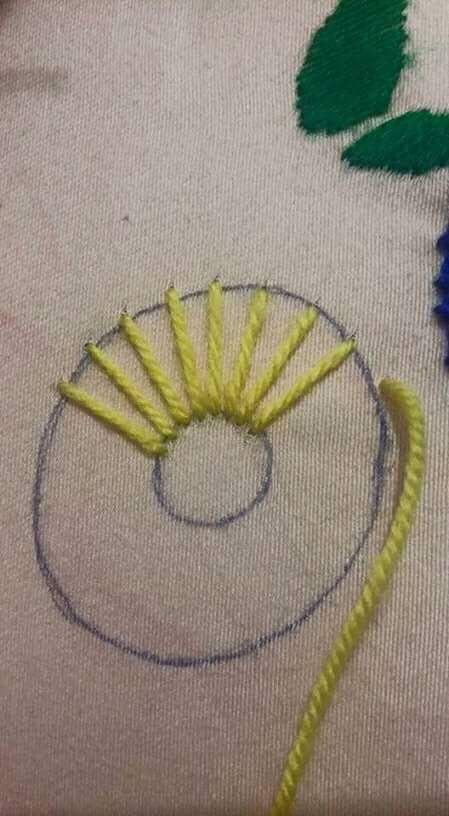

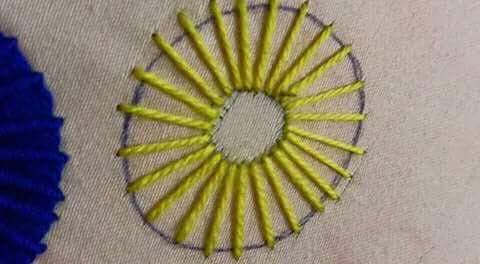
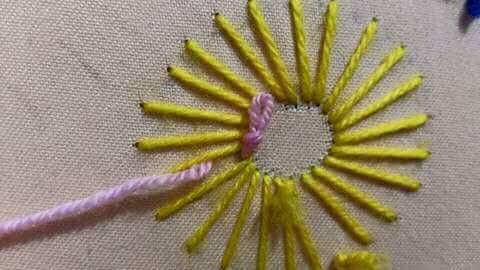
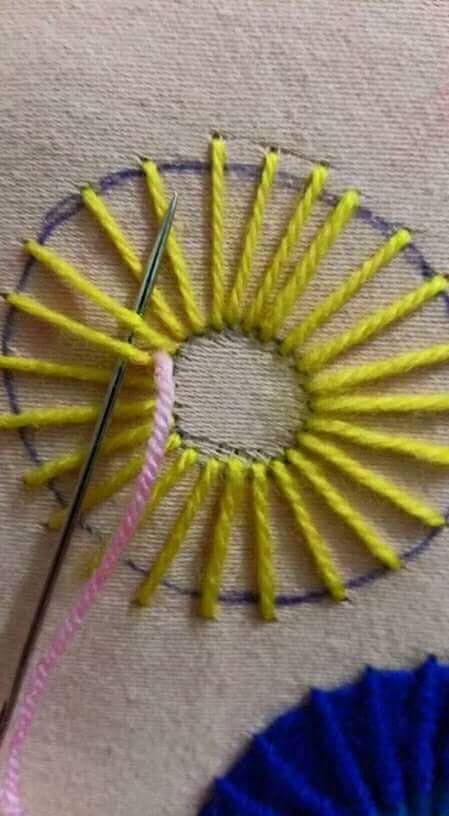
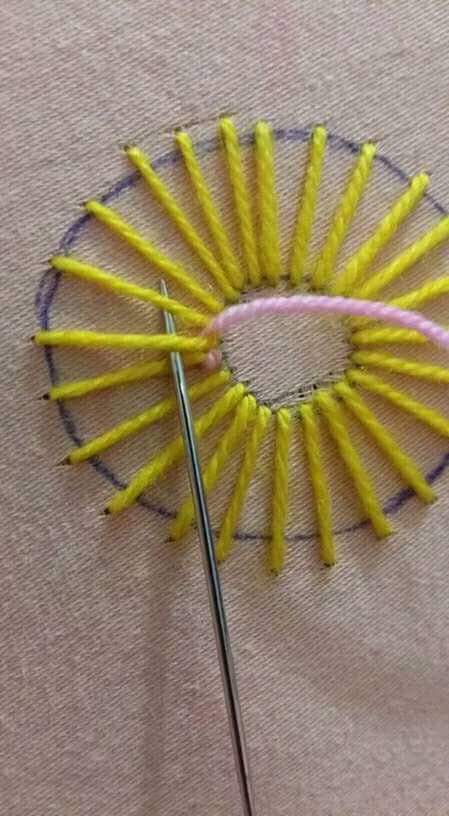
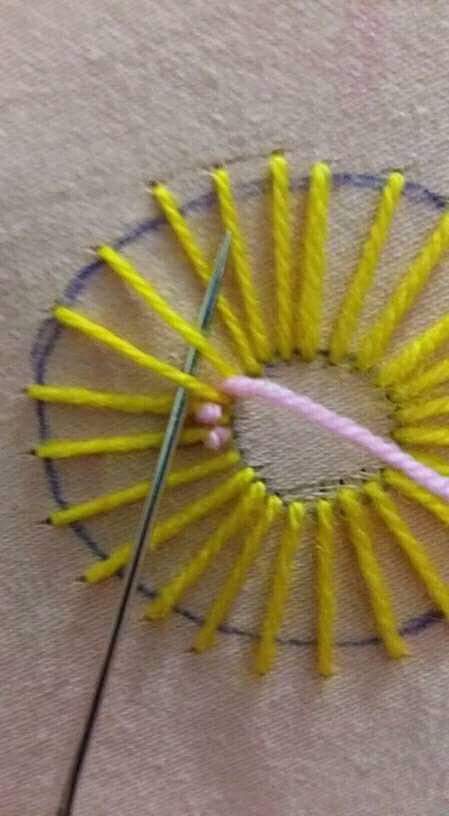
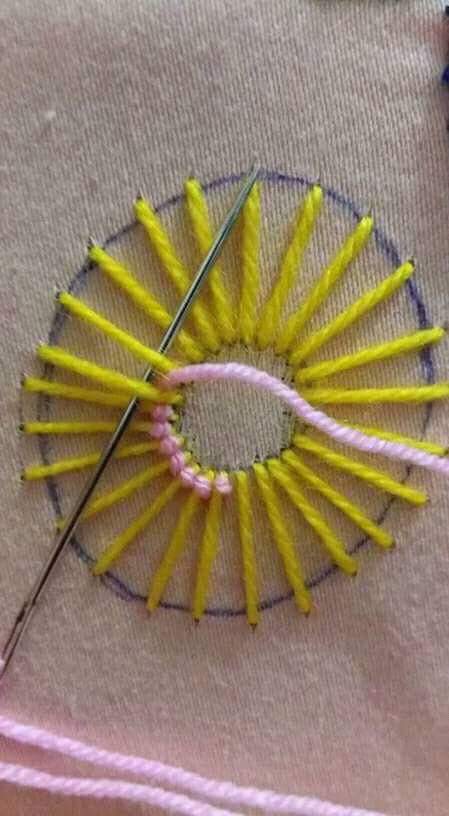
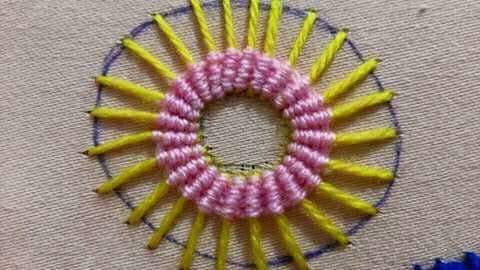
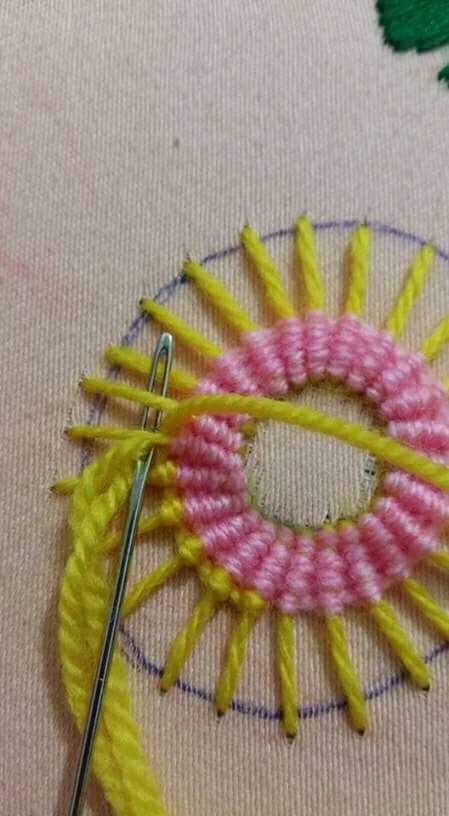
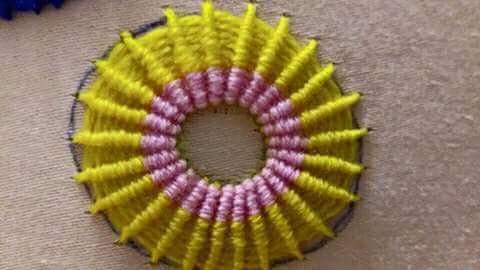
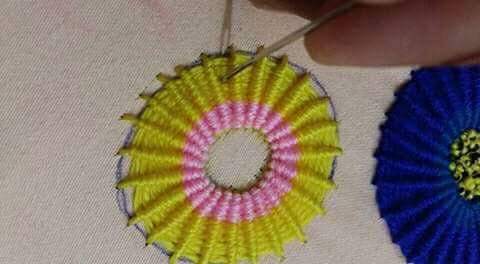
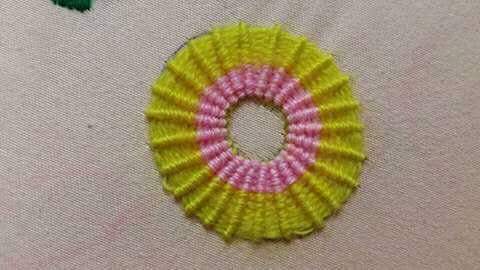
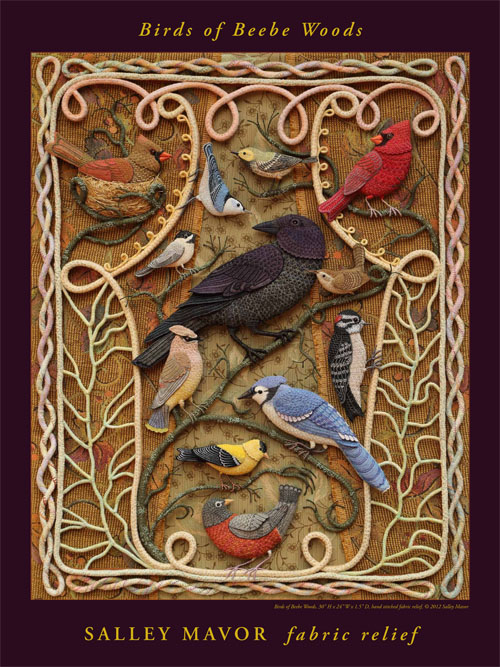
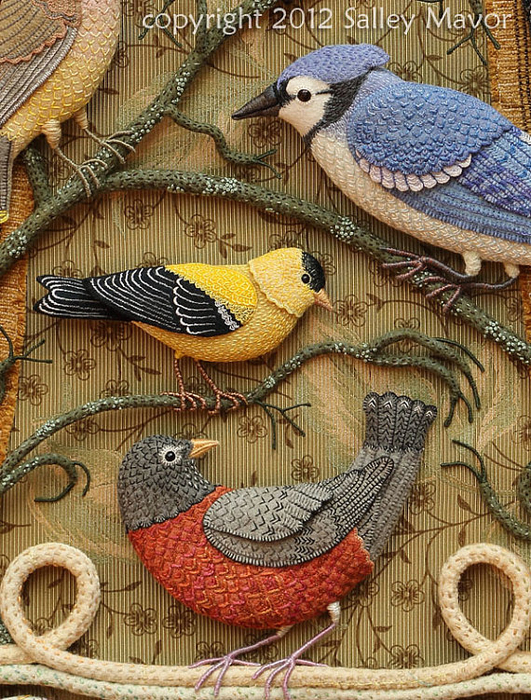
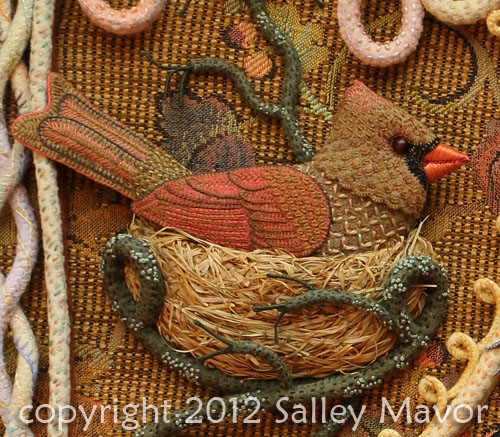
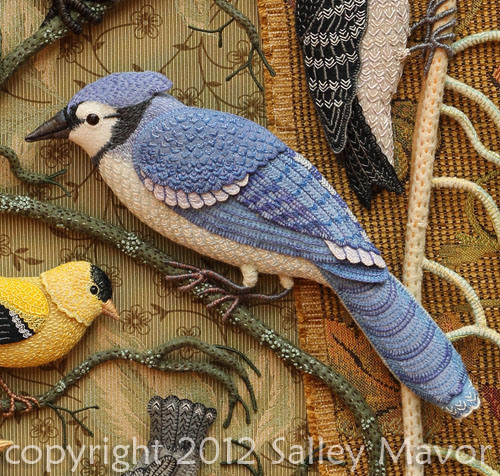
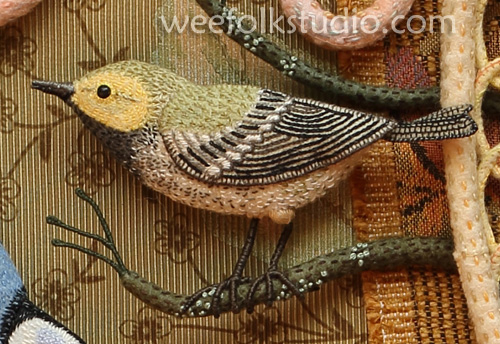
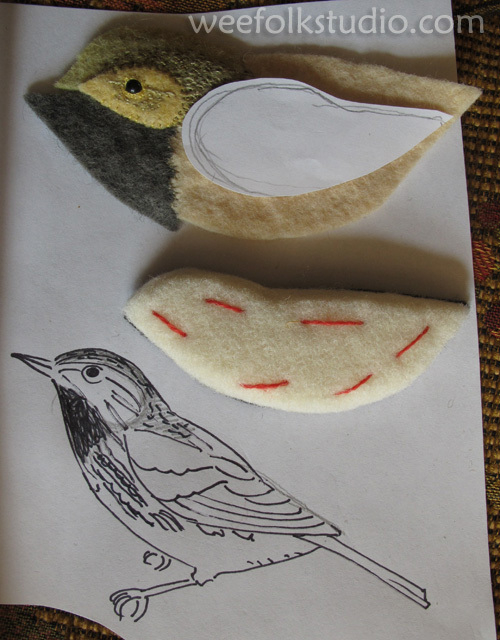

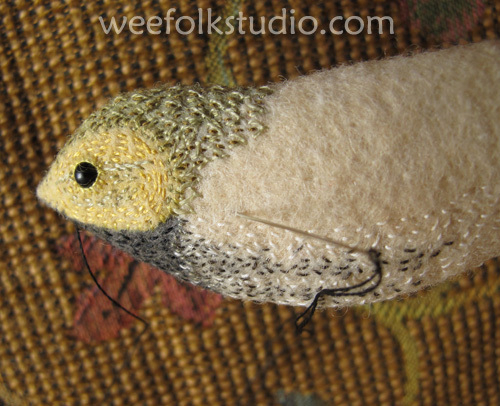
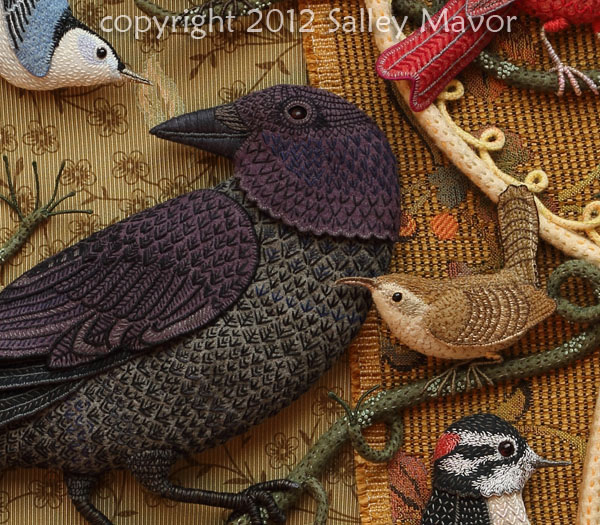
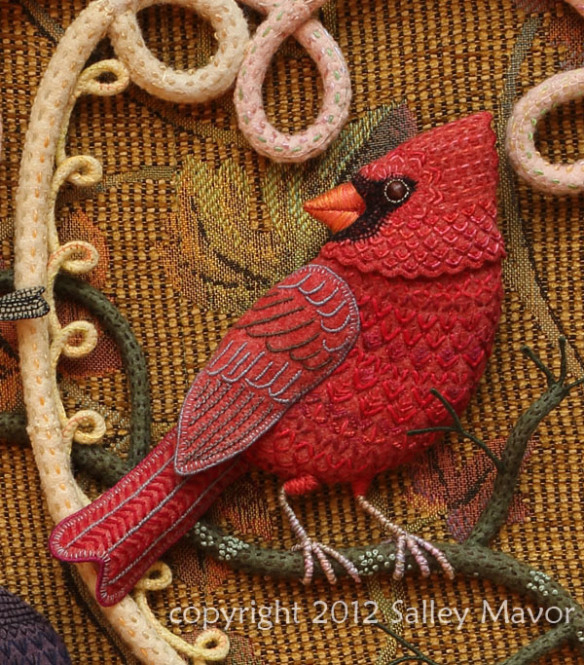
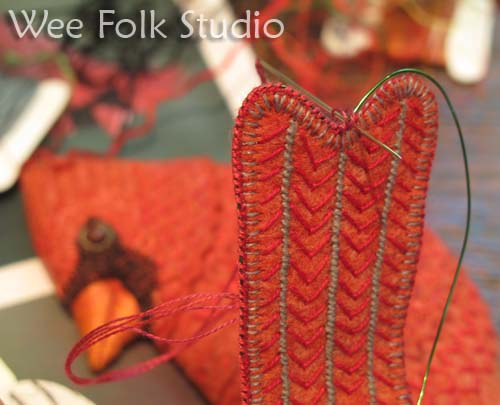
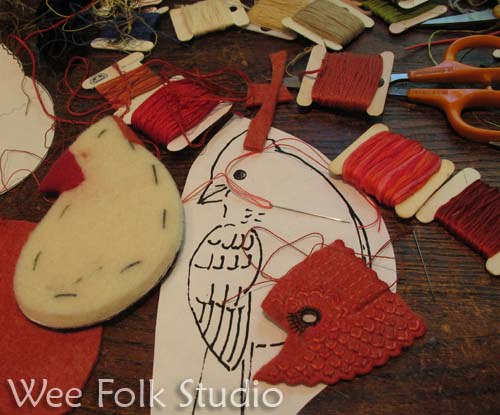
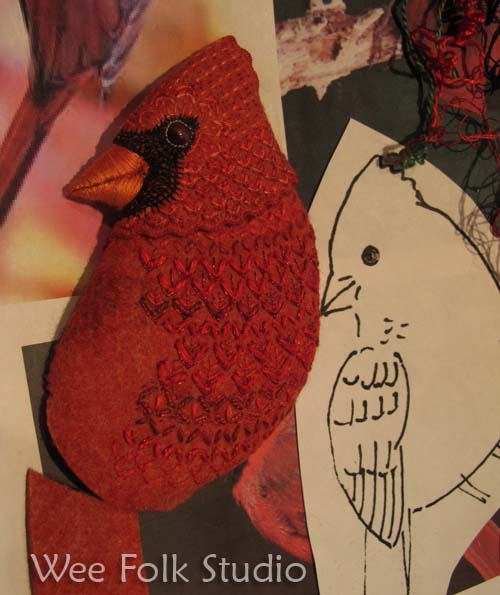
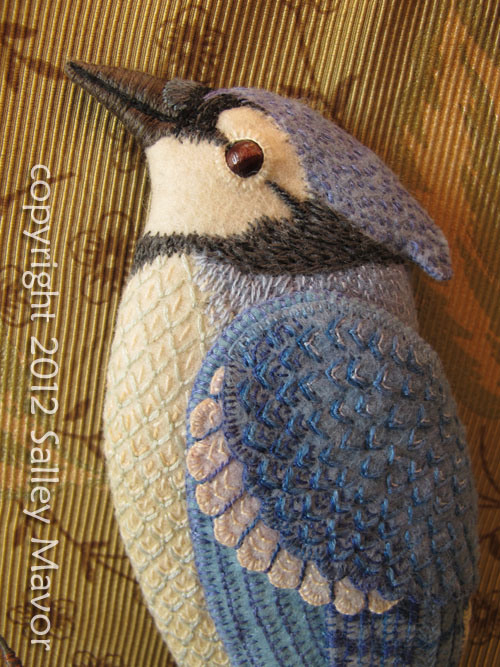
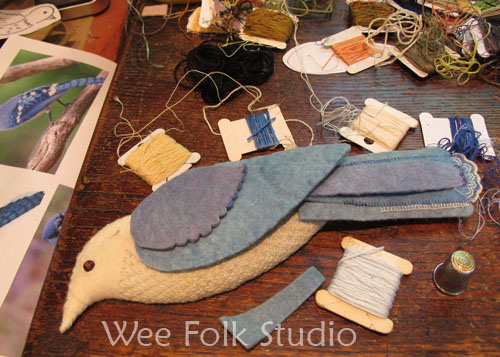
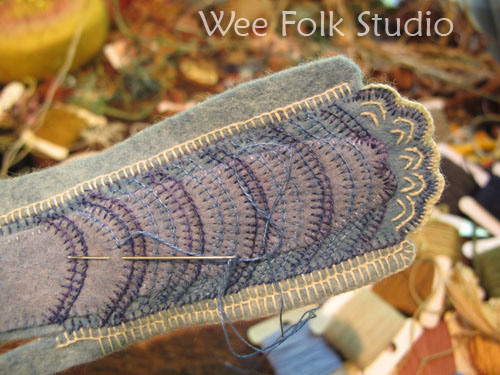
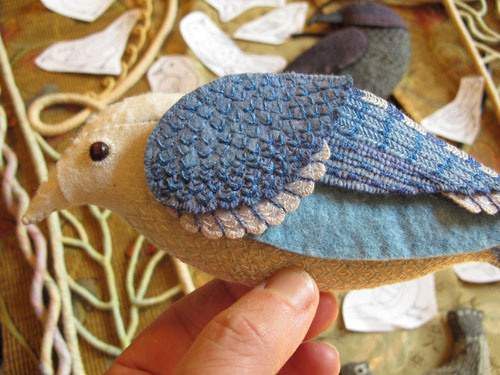
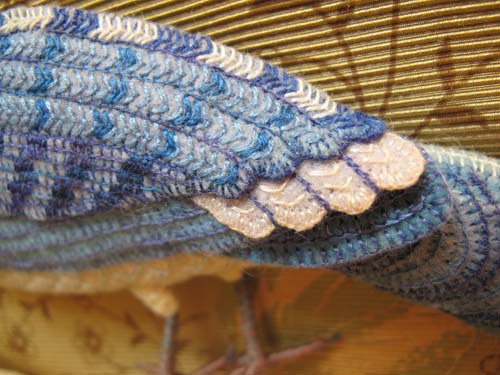
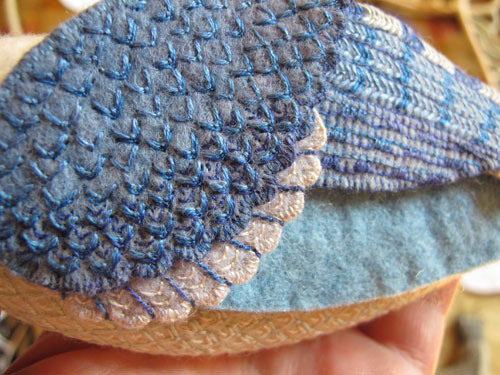
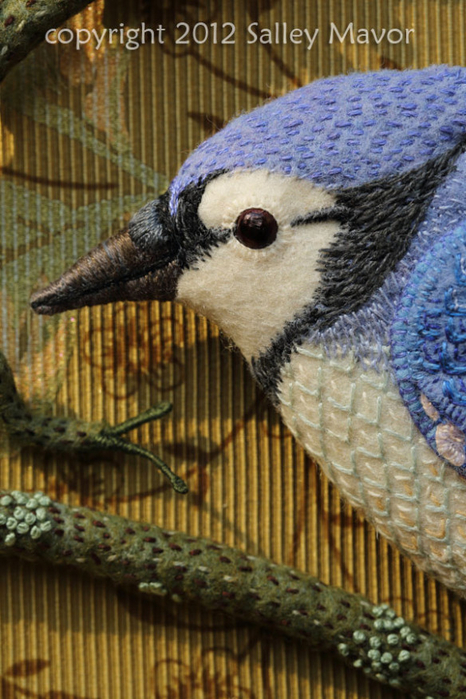
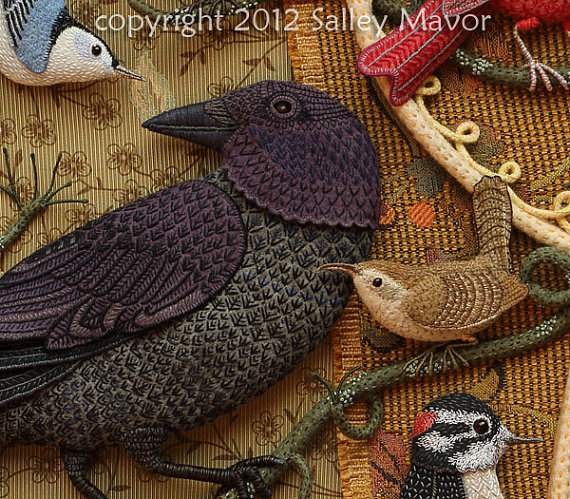
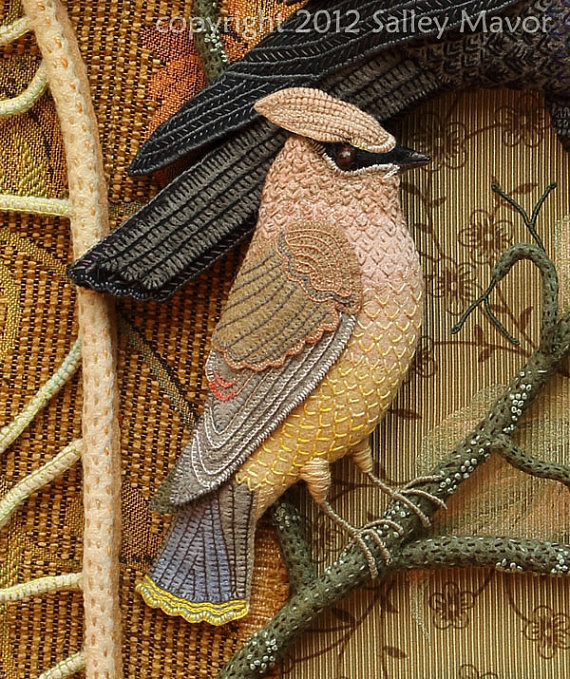
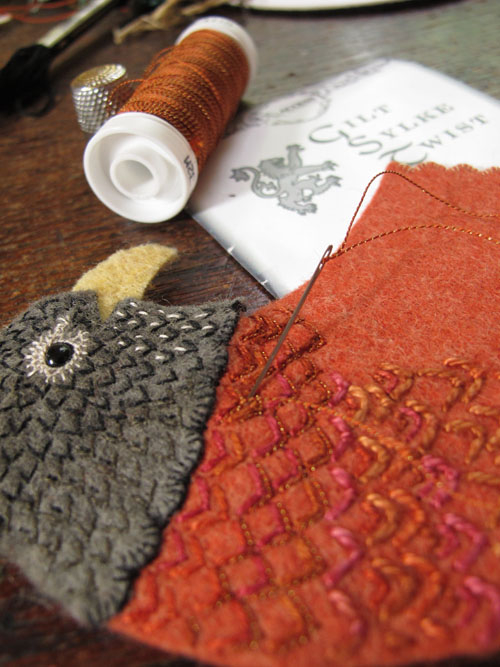
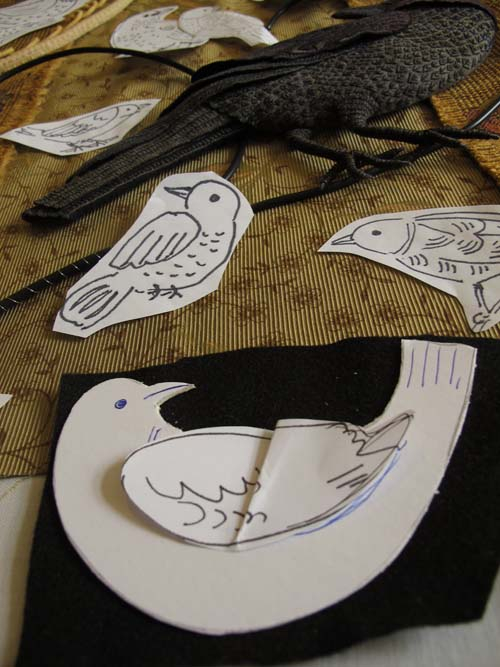
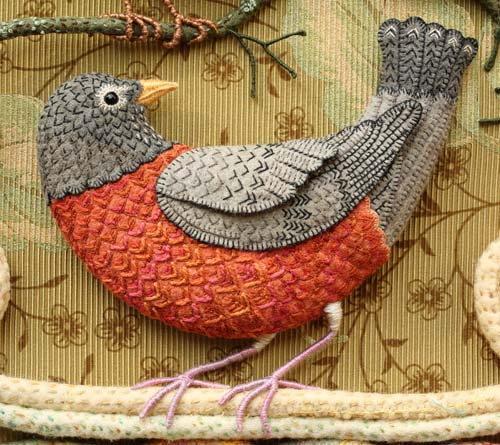
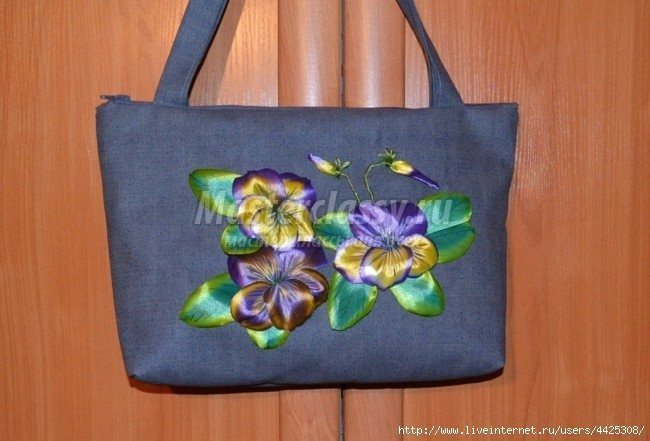
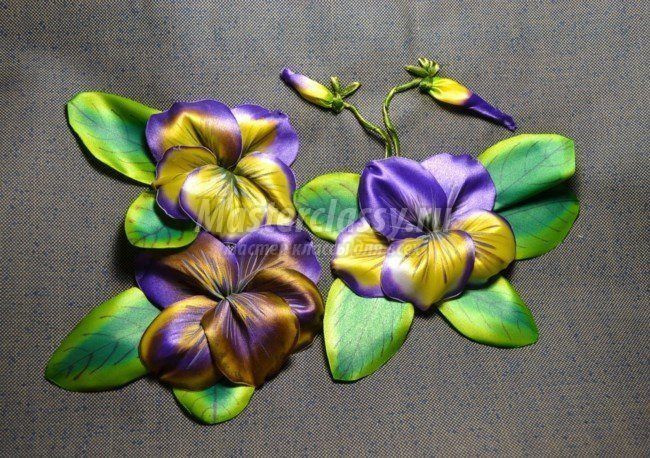
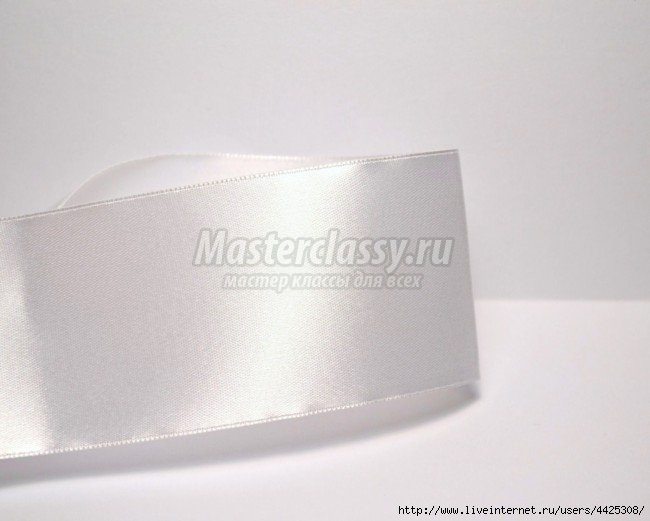 Cut off from the tape segment rather rectangle.
Cut off from the tape segment rather rectangle.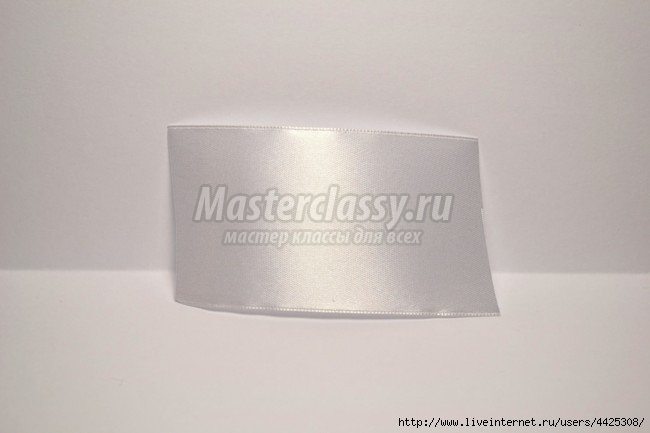 Cut a rectangle of a certain preparation, which is shown in the photo. singeing the edges of the work piece. This is done so that the edges of the tape is not rained.
Cut a rectangle of a certain preparation, which is shown in the photo. singeing the edges of the work piece. This is done so that the edges of the tape is not rained.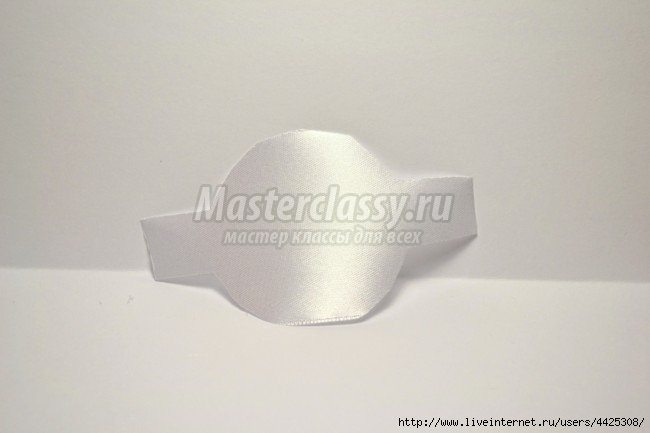
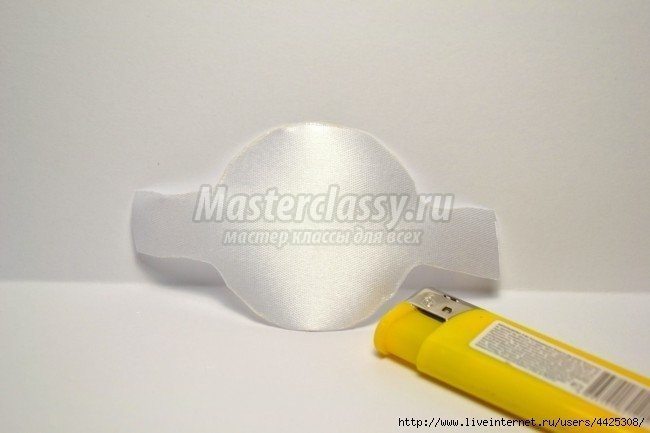 Next, take the hands of paint. They should be diluted to a state of some water. Even if you have a liquid paint, you also their divorce. Workpiece should be wetted with water and blot on polotenicheke to avoid dripping. Then apply the paint brush tip and touch the edge of a petal… petals according to the real petals. After the paint has dried it is necessary to draw the veins. I do it with conventional acrylic paints dry brush. (You can do this a black gel pen)
Next, take the hands of paint. They should be diluted to a state of some water. Even if you have a liquid paint, you also their divorce. Workpiece should be wetted with water and blot on polotenicheke to avoid dripping. Then apply the paint brush tip and touch the edge of a petal… petals according to the real petals. After the paint has dried it is necessary to draw the veins. I do it with conventional acrylic paints dry brush. (You can do this a black gel pen)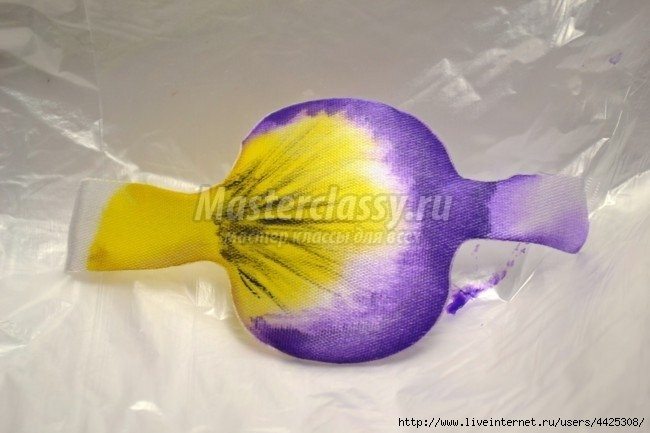 Create a few of these petals. For one flower need 5 petals.
Create a few of these petals. For one flower need 5 petals.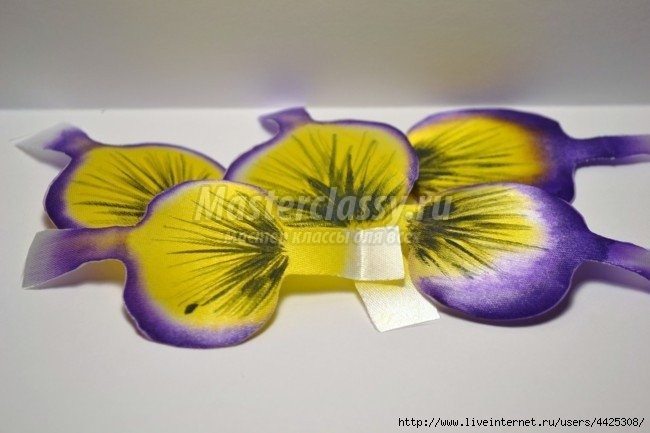 Now combine the three petals together. Sew them. And sew two lobes separately.
Now combine the three petals together. Sew them. And sew two lobes separately.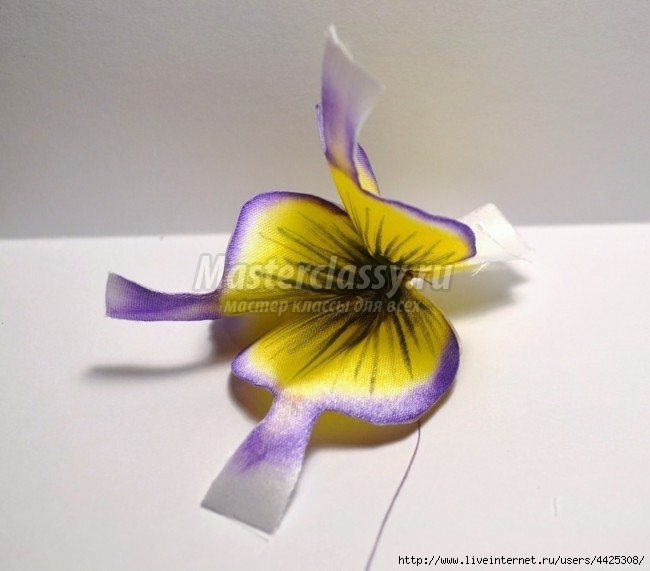
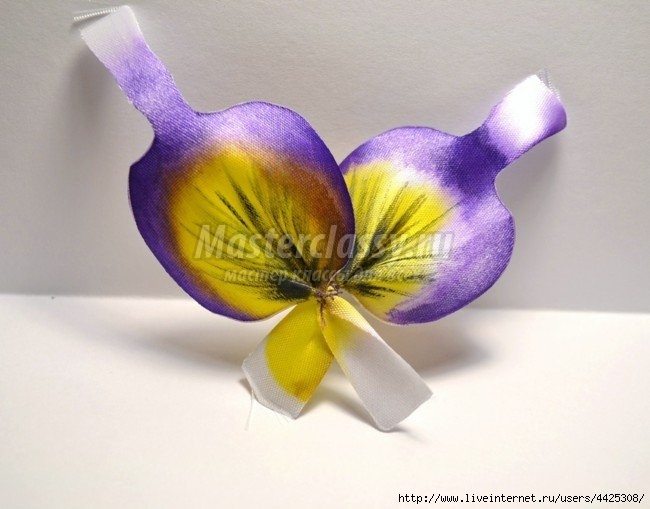 Now you need to sew all the petals. Care should be taken, as will be placed petals. We must achieve greater similarity with real colors.
Now you need to sew all the petals. Care should be taken, as will be placed petals. We must achieve greater similarity with real colors.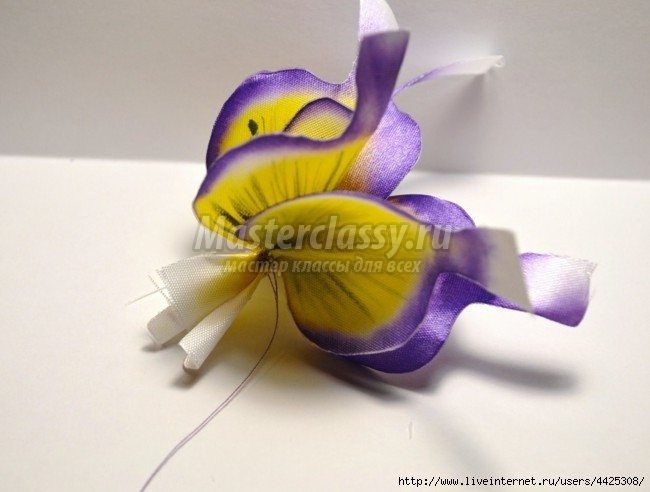 Next, insert the tip of the flower and sew the fabric on the reverse side.
Next, insert the tip of the flower and sew the fabric on the reverse side.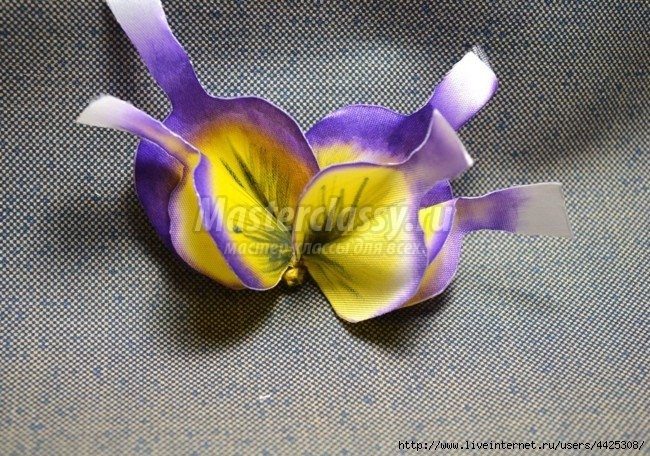 Then insert the tip of each petal in the fabric. We obtain as a result a beautiful flower pansy. .
Then insert the tip of each petal in the fabric. We obtain as a result a beautiful flower pansy. .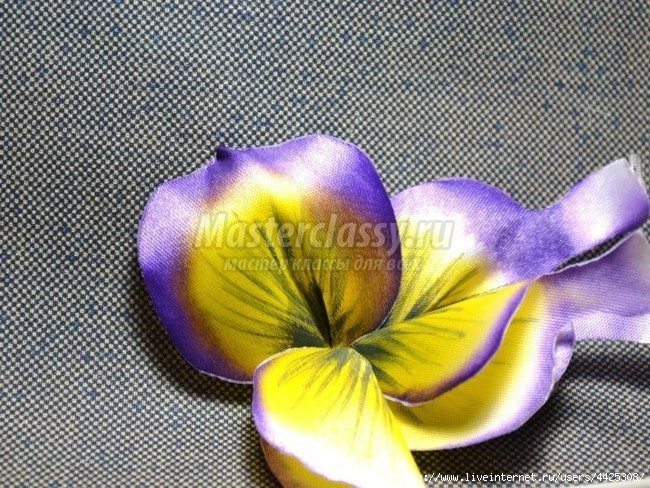
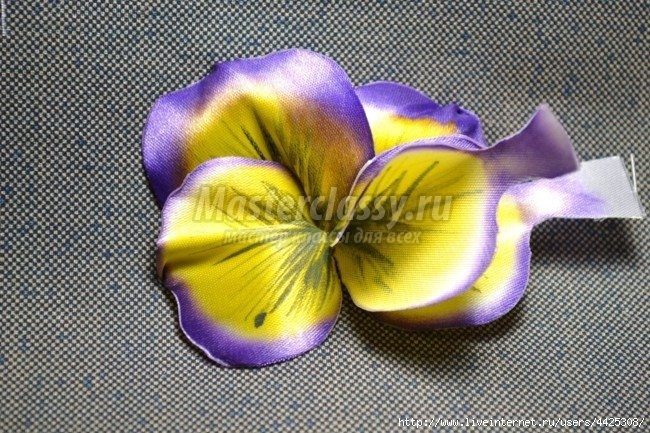

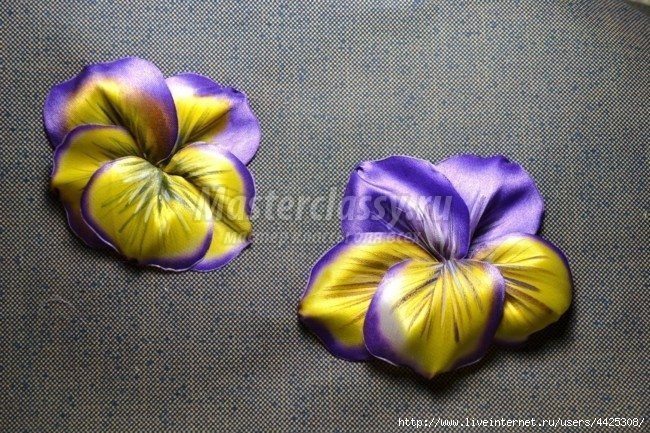
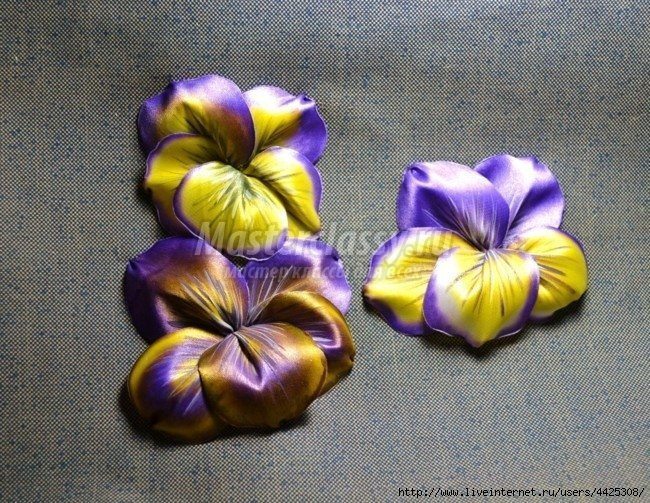 Now proceed to the creation of the leaves. Cut a piece of satin ribbon.
Now proceed to the creation of the leaves. Cut a piece of satin ribbon.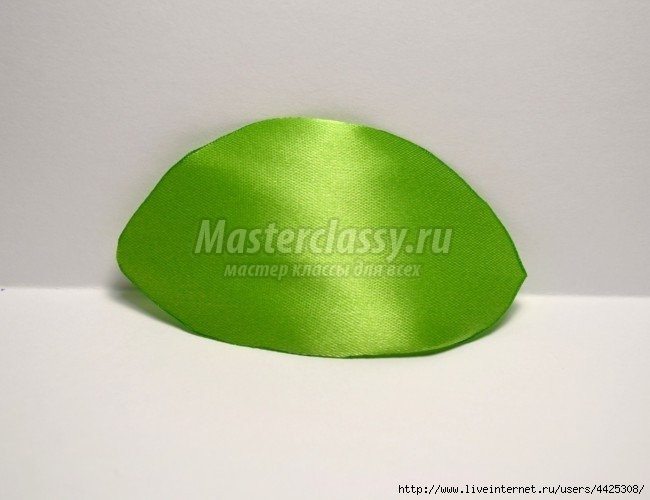 Drawn streaks of dry leaves. I drew veins with a toothpick fabric paint. (Gel pen you just to help!)
Drawn streaks of dry leaves. I drew veins with a toothpick fabric paint. (Gel pen you just to help!)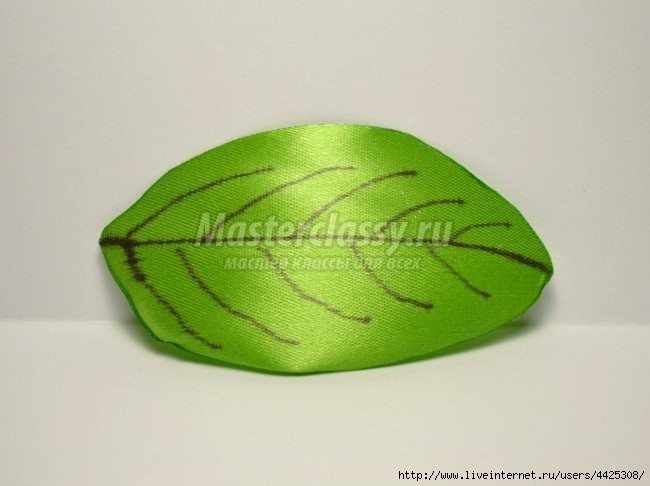 Next, it is necessary to wet the sheet and towel . Then the middle of a toned leaf and edge colours for the fabric.
Next, it is necessary to wet the sheet and towel . Then the middle of a toned leaf and edge colours for the fabric.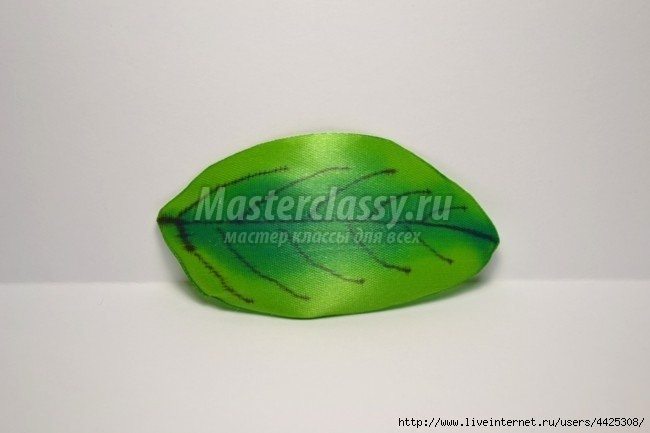
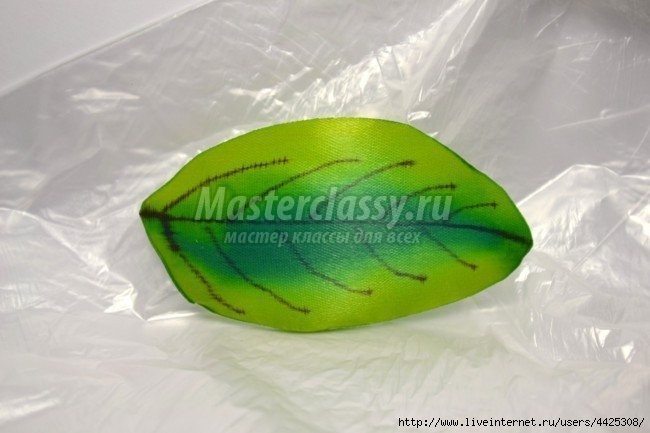 Will create further bud of a flower. Cut out a square of satin ribbons. Sew it with one edge. Rolled and stitched to the embroidery . Using a thin satin ribbon necessary to embroider the stem and sepals.
Will create further bud of a flower. Cut out a square of satin ribbons. Sew it with one edge. Rolled and stitched to the embroidery . Using a thin satin ribbon necessary to embroider the stem and sepals.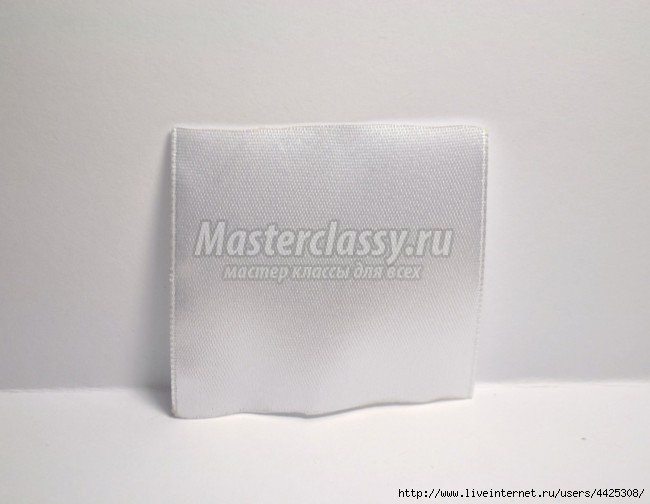 Create more bud. Toning dyes for fabrics. After all the manipulations embroidery ready.
Create more bud. Toning dyes for fabrics. After all the manipulations embroidery ready.